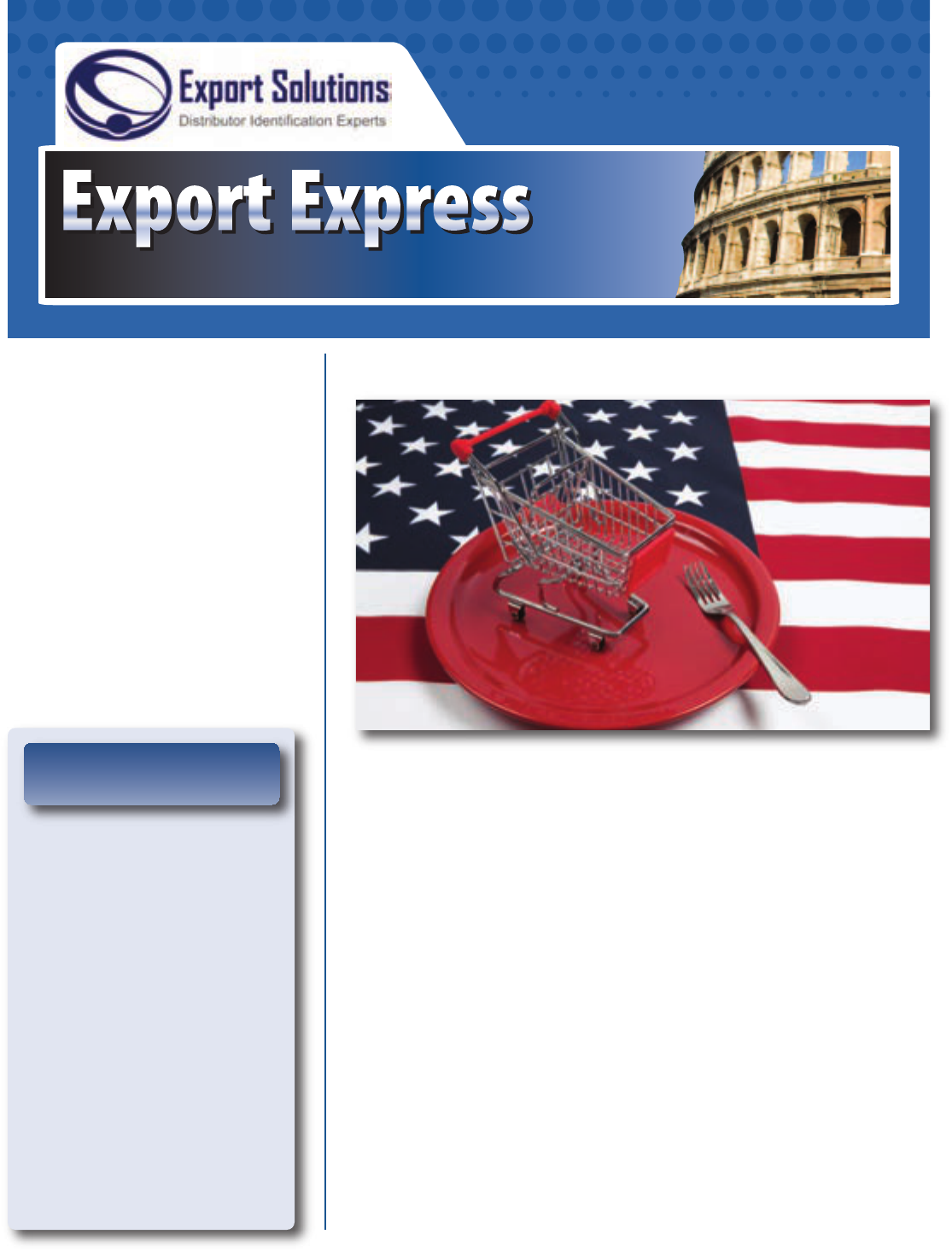
Insights to Accelerate International Expansion
USA Handbook
Our Mission: Help Manufacturers “Spend time Selling to Distributors versus Searching for Distributors”
The USA has served as a growth
market for European traders for more
than 400 years. Waves of immigrants
have landed on the USA’s welcoming
shores. Early arrivals hailed from the
United Kingdom and France. Slavery
delivered more than 600,000 Africans
between 1700-1820. The industrial
revolution lured people from European
countries including Italy, Germany,
Ireland, Greece, and Sweden. The last
50 years have redefined the USA again
with almost 65 million citizens of
Hispanic descent and 20 million of
Asian heritage. The result is a melting
pot of cultures which creates a unique
appreciation of food from every corner
of the world.
USA Today
The USA is the world’s largest consumer
market with 333 million people and retail
sales exceeding one trillion dollars. It’s
a young country, with 31% of the
population under the age of 25. Many
exporters make the mistake of labeling
the USA as a “mature” market, with low
growth expectations. The reality is that
the USA offers some of the best
opportunities on the planet. This fact is
validated by the combination of a large,
wealthy population, that is adventurous
in food habits. The retail industry is
robust, with large stores bursting with
food choices from around the world.
Export Solutions recognizes that most
exporters maintain business in the USA.
However, our experience is that most
international brands’ sales levels are
modest relative to the size of the USA
population and category development.
Barriers to success include competition
versus USA produced brands and
difficulty in funding marketing and sales
development activities. Export Solutions’
goal with our “Sell to the USA” handbook
is to provide logical strategies, insights,
contacts, and facts for international
brands looking to build sales in the
vibrant USA market.
In This Issue
1,100 USA Experts
Export Solutions features the most
extensive database of USA food brokers,
distributors,and importers. Our
proprietary information covers experts
dedicated to every USA trade channel,
major customer, and region. This includes
specialists for Italian, Spanish, British,
German, Asian and Hispanic food plus
other supermarket categories. Export
Solutions tracks more than 566 food
brokers, as well as 598 food importers
and distributors. These lists can be
purchased individually or as part of
an annual subscription to our database
which covers 96 countries and more
than 9,200 distributors. Access now
at www.exportsolutions.com.
Selling to the United States
Page 2
USA: Bigger than BRIC?
Page 8
Export Solutions: 15 Common USA Issues
Page 17
USA Market Entry Alternatives:
Broker versus Importer versus Direct?
Page 23
Brand Owners: What Every
USA Broker Wants to Know
Page 50
5 USA Labeling Regulation Tips-FDA
Page 51
How Well Do You Know the USA?
50 Industry Terms and Definitions
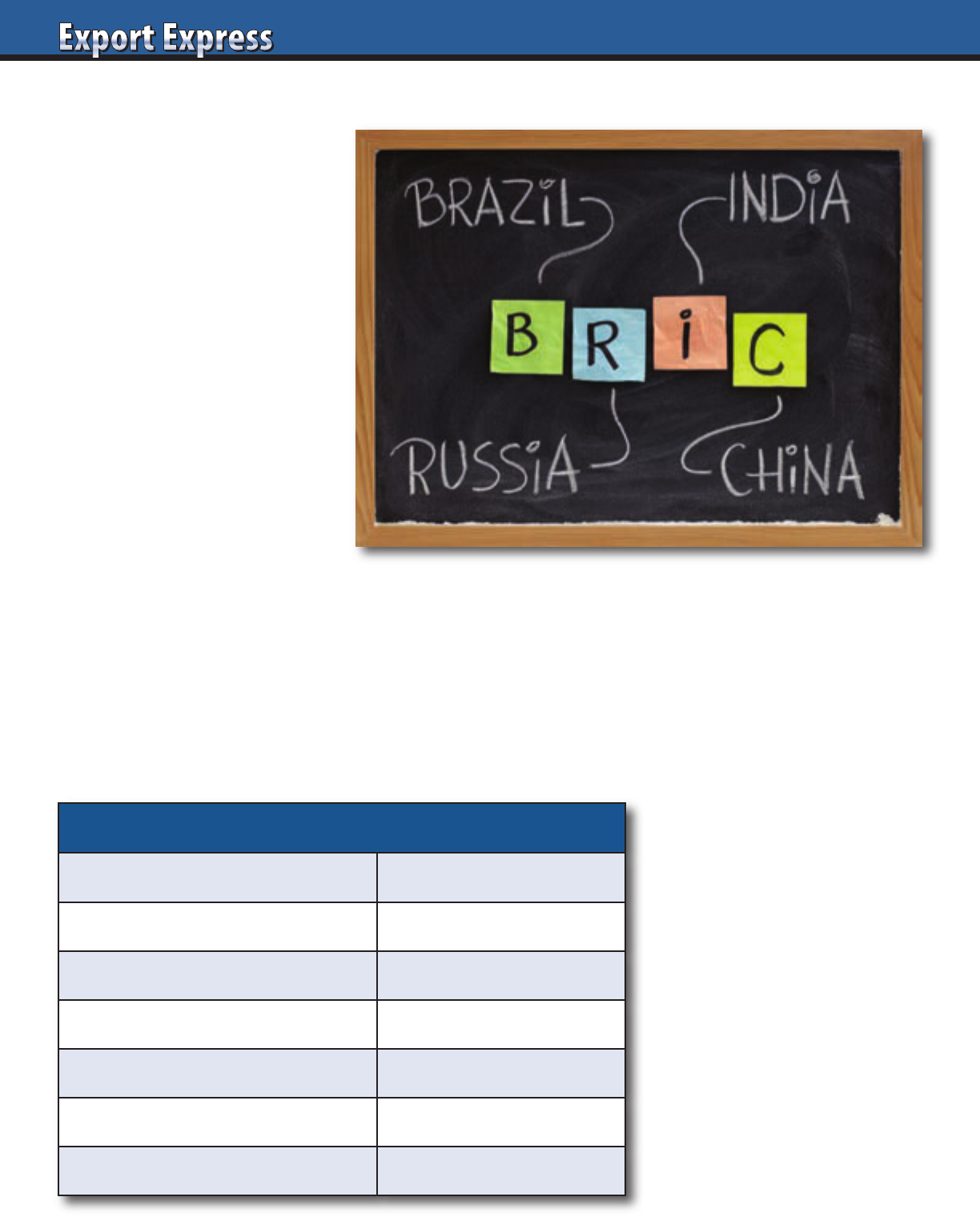
The state of California ranks as the world’s
8th largest economy, larger than India
or Italy. USA population expanded by
51 million people since 2000, an increase
greater than the size of Canada. Americans
are spenders by nature, with 85% of the
population able to regularly purchase
supermarket brands. All international
companies export to the USA, but per
capita sales levels are usually very small
relative to potential. Export Solutions
believes that many international brands
would see a higher return on investment
through efforts to build a stronger
franchise in the USA versus waiting
for “BRIC dreams to come true.”
Global Marketplace
Americans are spoiled with an
overwhelming assortment of food
options. An average USA supermarket
stocks more than 40,000 unique items
in a 50,000 square foot store. Shelves
showcase products from around the
world. During one week, a typical family
would enjoy a mix of Italian, Mexican,
and Asian food to supplement meals
based upon meat, vegetables, and
potatoes. American cuisine has
assimilated into international cuisine
reflecting the rich heritage of ethnic
diversity. This creates an open gateway
for brands from every continent.
Americans are receptive to new and
emerging flavors which is a significant
point of difference versus BRIC markets
which tend to remain glued to traditional
eating habits and choices.
13 Different Trade Channels
USA retail business exceeds 1 trillion
dollars, through 13 unique trade
channels. Each USA trade channel
maintains a unique set of buying
practices and selling experts. 40,000
supermarkets account for 52% of the
food business, followed by 4,000
Supercenters (primarily Walmart),
and 1,400 high volume Club stores.
Gourmet food stores such as Whole
Foods and ethnic supermarkets
represent core outlets for
international brands. Sales via the
internet are an emerging, high
growth, channel offering visibility
and availability. Homesick expatriates
and food enthusiasts now discover
hard to find products instantly online
versus the historical approach of
hauling overweight suitcases from
trips overseas. Foodservice is an
enormous channel, but focused
on commodity products produced
in the USA.
Three Phase Approach: Crawl, Walk, Run
Too many international brands are
misaligned with a focus to sell to
Walmart or even Kroger before they
have established a meaningful track
record with other retailers. A key
insight is a finely tuned strategy
focused on winning with a few high
potential, trend setting retailers prior
to approaching the “Giants.”
Normally, we recommend initial focus
on ethnic and gourmet retailers such
as Whole Foods and Fresh Market.
After success, consider expansion to
upscale supermarket chains such as
Wegman’s and Harris Teeter. Phase III
should provide a track record and
investment base to approach mass
retailers such as Walmart, Kroger,
and Albertsons.
USA: Bigger than BRIC?
USA Fast Facts
Population 333 million
GDP/Per Capita $69,069
Number of Supermarkets 40,000
Gross Margin (Supermarket avg.) 28%
Slotting Fee (avg. per store/item) $50
Food Brokers 566
Food Importers/Distributors 598
continued on next page
2
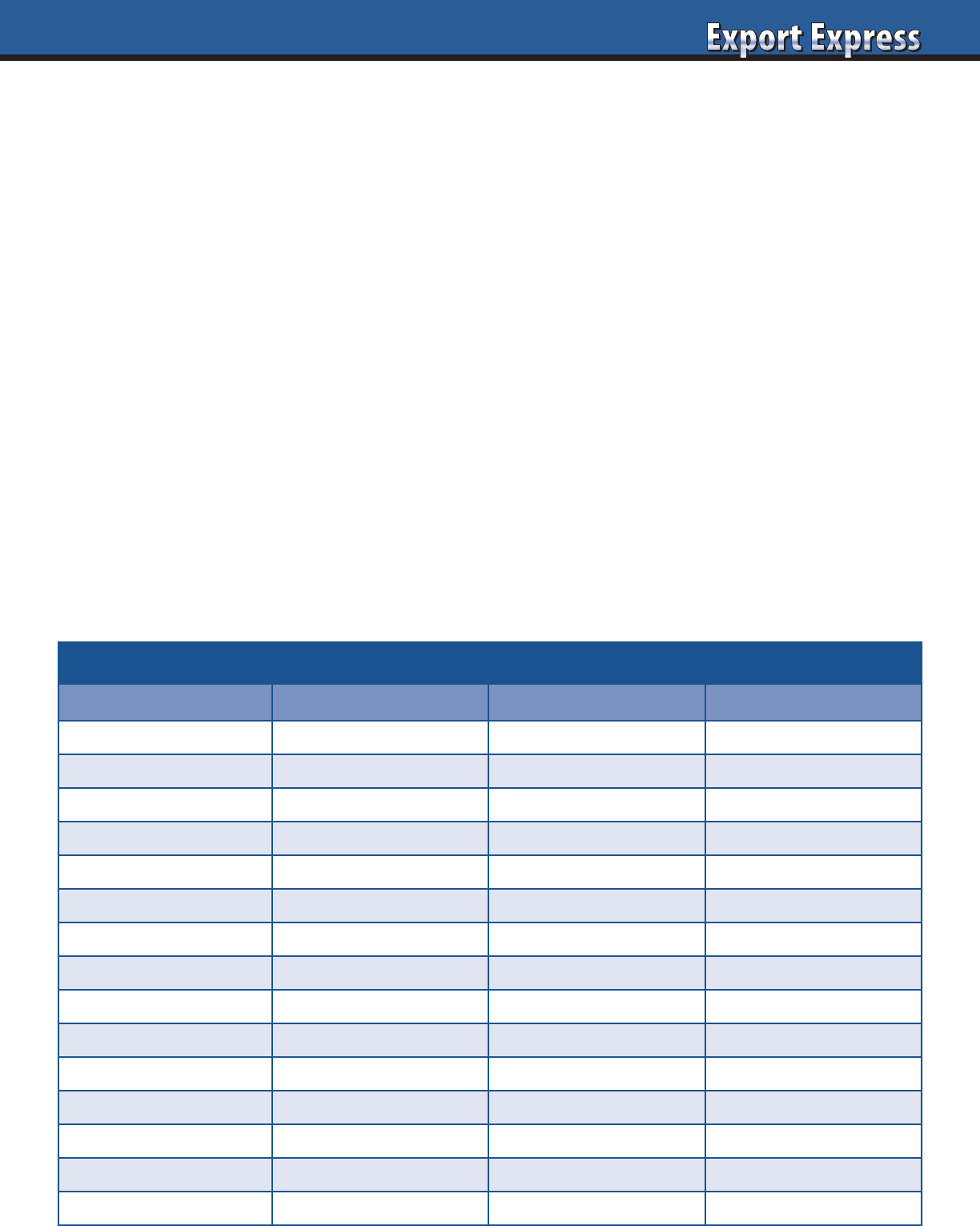
3
Who is Your Food Broker?
Food brokers dominate sales through the
USA supermarket channel. Brokers provide
critical mass and local relationships.
Services include key account sales, category
analysis, trade marketing, and essential
retail coverage. Store level representation
is mandatory to insure compliance with
headquarter authorized plans. Brokers
range in size from the massive “Big 3”
which feature more than 20,000 employees
each to smaller specialists focused against
one retailer. Export Solutions’ database
tracks over 566 brokers covering all markets
and channels. Leading USA importers
partner with brokers to provide the local
expertise and store merchandising services
required to succeed.
Calibrate Expectations to Investment
Imagine approaching Carrefour, Metro,
or Tesco with a new brand with “net, net
pricing” and limited marketing support.
The USA market is no different, with a
menu of account specific programs
required to build your brand. If you don’t
invest, you will always be anchored to
niche status at best. Retailers such as
Costco with their demo programs and
Shop Rite retain good reputations for
delivering incremental cases for your
trade spending.
Success Stories:
Barilla, Bonne Maman, and Walkers
Case studies exist for international brands
to successfully develop the USA market.
Barilla is the USA’s leading pasta brand.
Success strategy included building a USA
factory to offer competitive pricing,
highlighting their Italian heritage, and
alignment with a leading USA food broker.
Bonne Maman and Walker’s trajectory
followed patient paths. Both brands built
a base in the upscale retail sectors, before
moving mainstream to mass availability.
A core message was the ability to upgrade
category sales and profits with a high
quality, premium option. Both companies
invest in having USA based sales managers
versus managing via remote control from
Europe. Other European brands have
developed massive businesses through
unique programs dedicated to Costco.
USA Business – Next Level Strategies
European brands frequently hire Export
Solutions to provide insights on taking
their current USA business to the “next
level.” Our sales oriented approach
involves market analysis, “lessons
learned” and recommendations of
sensible options to grow your business.
Suggestions normally include laser
focus on brand building at high
potential customers plus best route
to market partners (importers/brokers)
by trade channel.
The USA still offers tremendous growth
opportunities for many international
brands. USA success requires the same
formula as BRIC markets. Higher levels of
investment may be required to win in the
USA. However, market dynamics are more
transparent than BRIC and purchasing
power ranks among the highest in the
world. Contact Greg Seminara at
[email protected] for more
information on taking your USA business
to the next level.
USA: Bigger than BRIC?
continued from previous page
Good USA Chains for International Brands
Retailer Type Sales (billions $) Stores
Ahold-Delhaize Supermarket 56 2,050
HEB - USA Supermarket 32 355
Meijer Supercenter 23 260
Wakefern/Shop Rite Supermarket 18 361
Whole Foods Gourmet 17 510
Hy Vee Supermarket 12 285
Giant Eagle Supermarket 11 216
Wegmans Supercenter 11 106
Harris Teeter Supermarket 8 260
Sprouts Gourmet 6 370
Raleys Supermarket 4 126
Fresh Market Gourmet 1.8 159
World Market Gourmet 1.0 242
Gelsons Supermarket 0.8 27
Kings Supermarket 0.4 19
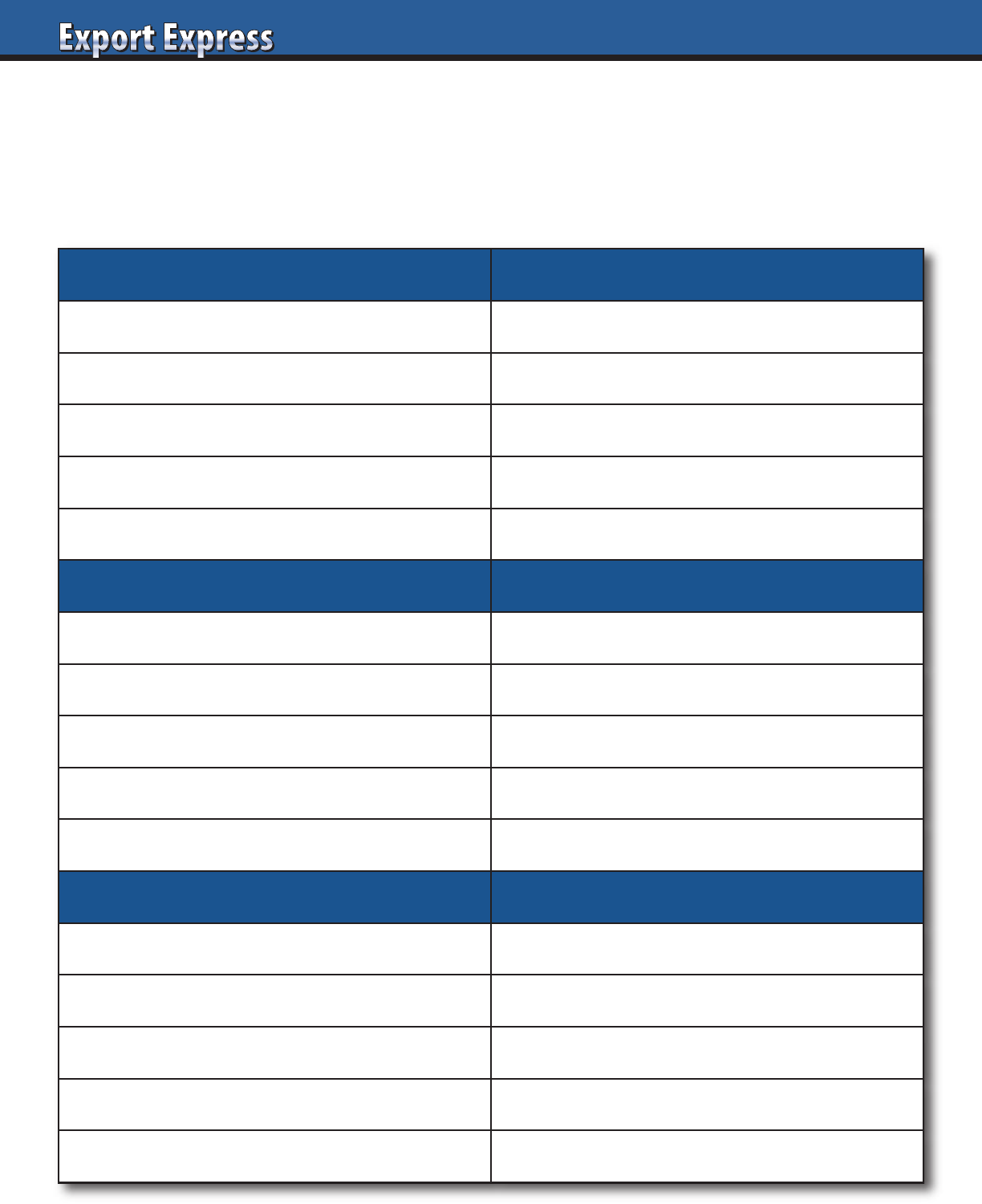
4
“The Right Way” – USA Launch
Retail buyers and distributors are receptive to brand launches from multinationals. Why?
Multinationals succeed, as they introduce new products “The Right Way.” Export Solutions recaps
30 components of launching “The Right Way.” Exporters create magic with limited budgets!
Winners check as many boxes as possible on “The Right Way” scorecard.
Product Retailer
o Meaningful innovation – not “me too” o Boost category sales, margin, and profit
o Consumer market research insights o Syndicated data (Nielsen) – category facts
o Technical confirmation of product differentiation o Invest in retailer “push” programs
o Reasonable retail price – premium (not sky high) o 4-6 high value promotional events per year
o Test market results – similar country or retailer o Retailer VP, broker/distributor CEO at intro call
Marketing Excitement
o 360 marketing plan: TV, in-store, social, PR o Launch party – memorable location
o Sampling o PR, social media, trade press
o Social media o Celebrity endorsement
o Displays: end of aisle and shelf blocks o Distributor sales contest
o Special offers – retailer fliers o Donation to local charity
Team Scorecard
o Broker/distributor – best in class o Year 1: invest; year 2: break even; year 3: profit
o Local manager – launch oversight o Sales volume (retail sell-out)
o Marketing, social media, PR agencies o Market share
o Brand/technical resource from headquarters o Retail availability (weighted distribution)
o Total distributor engagement: reps. to CEO o Year 2 commitment and enthusiasm
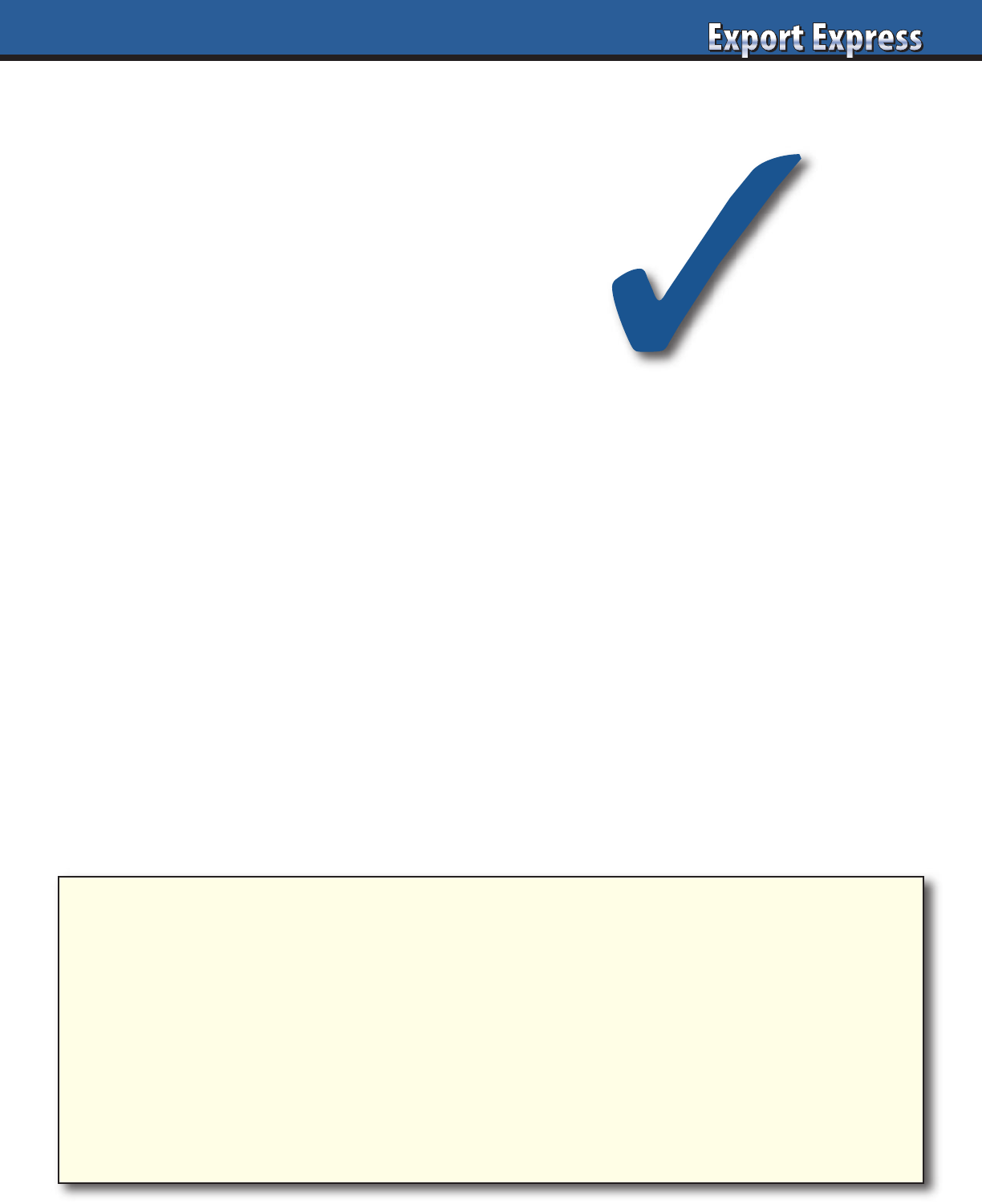
Export Solutions’ New Distributor Checklist
____ Contract/Agreement
____ Price Calculation Model
____ Business Plan: objectives, marketing,
spending, key dates
____ Category Review: Pricing, Shelf,
Assortment, Merchandising
____ Label Compliance
____ Shelf Life
____ Order Lead Time
____ Minimum Order
____ Pick up Point
____ Payment Terms
____ Payment Currency
____ Damage Policy
____ Product Registration
____ Forecast: Year 1
____ Pipeline Order & Inventory
____ Brand Facts
____ Product Samples
____ Appointment Letter
____ Brand Specifications in System:
Distributor & Customers
____ Training: Key Account Managers,
Retail, Administrative Staff, Warehouse
____ In Store Standards: Pricing, Shelf
Management, Merchandising
____ FAQ’s/Handling Common Objections
____ Key Account Presentation
____ Customer Appointment Dates
____ Category/Business Review:
Tailored to Each Key Account
____ Retail Sales Contest
____ Checkpoint Calls
____ Market Audit Date
____ Reporting: Track Distribution, Pricing,
Shelf Positioning, Merchandising, etc.
5 Critical Questions to Thrive in 2025
1. Are we willing to pursue USA acquisitions?
2. Would your company consider USA contract packing (versus export)?
3. Can we test a high spend investment plan (“The Right Way”) in a USA region?
4. Would your company invest aggressively in USA head count in advance of sales?
5. Can we implement the USA playbook? USA factory, broker network, competitive pricing,
USA team, channel strategy, 30-50% of sales on trade promotions?
5
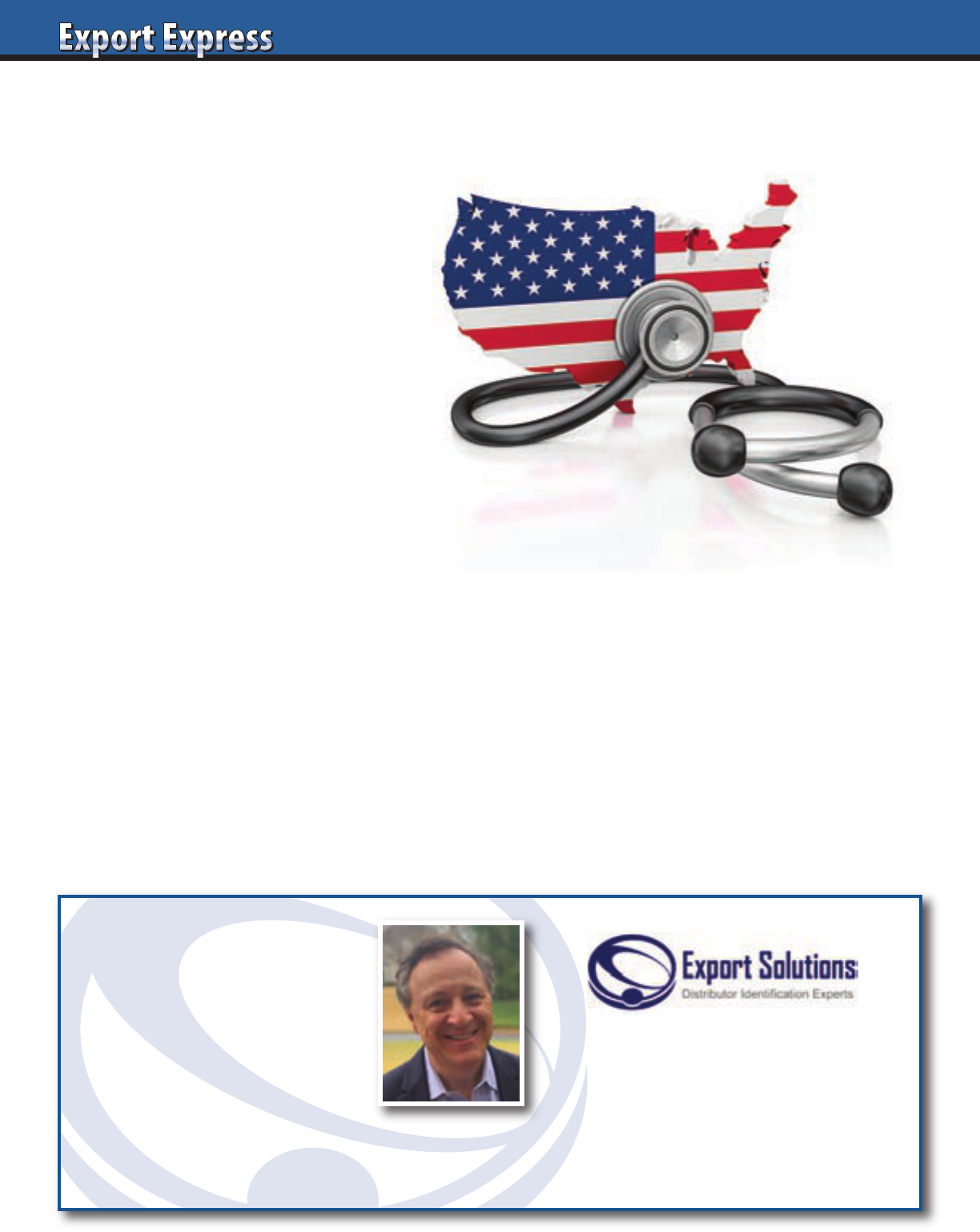
6
• Analyze USA opportunity
for your company:
Category review, gap analysis,
and “size of the prize”
• Next level development plan
for brands already selling in
the USA:
What’s working? What’s not
working? What to do next?
• Broker/Distributor/Importer
Identification:
National, Regional, or Trade Channel
specific solutions. Export Solutions
database tracks 566 USA brokers
and 598 distributors/importers.
• Develop strategic plan for USA:
Priority brands, pricing model, regions, customers, and partners.
• Are you ready for USA?
Label compliance, company credentials presentation in USA format, etc.
How We Help
Hire a USA Expert
• USA strategy recommendation
• Category analysis and
plan development
• Identify priority channels,
regions, and retailers
• Broker/Distributor
identification Specialist
• Have a USA pro with 20+ years experience on your team
Contact Greg Seminara at
(001)-404-255-8387 to discuss your
USA development project.
www.exportsolutions.com
Contact us for a copy of our Selling to the USA Handbook. This free guide is packed with practical insights,
market facts, and best practices to advance your business to the next level in the world’s largest market.
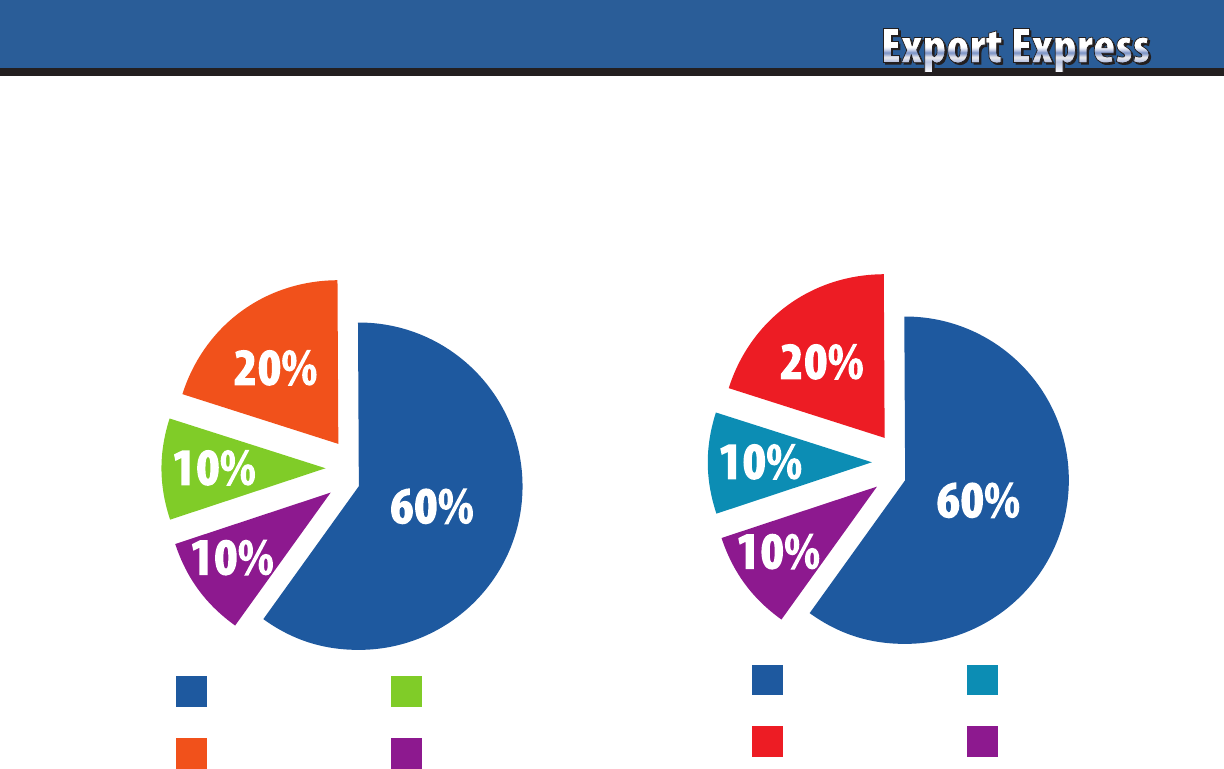
7
Made in USA Brands
Food products produced in the USA sell through 13 different
trade channels. Supermarkets always represent the largest
channel with 52% of sales. However, this represents a continuous
shrinkage from the dominant 85% share of food sales enjoyed
by supermarkets in the nineties. Walmart’s Supercenters are
the number one customer for virtually all mainstream USA food
brands, catering to the value oriented consumers. Kroger ranks
as the top supermarket chain reaching across the income
spectrum, but viewed in most markets as the supermarket of
the suburbs. Costco & Sam’s Club stores represent an important
customer for number one brands in large categories.
Imported Brands – Retail Destinations
Supermarkets still account for 60% of sales revenue for food
brands produced outside the USA. Frequently, international
brands derive their revenue from different supermarket chains
than the mass market. Imported brands naturally do well at
upscale supermarket chains like Wegman’s. Consider Shop Rite,
a 361 store chain that moves high volumes and their customers
love international brands. Gourmet retailers such as Whole
Foods and Fresh Market serve as prime showcases for foreign
products. I love Eataly’s six stores and Dean & Deluca’s three
deli’s but they represent a small fraction of Manhattan, let alone
the broader USA market. Ethnic grocery stores account for
important business for homesick expats missing their favorite
international foods. Amazon’s internet shopping platform is
an emerging destination for international foods.
USA Entry Cycle
Normally, international brands start first in the ethnic channel.
Demonstrated success creates opportunities to enter gourmet
stores like Whole Foods and upscale and regional supermarket
chains. Phase three provides critical mass to gain access to large
supermarket chains such as Kroger, HEB, and Publix. The final
step is to create demand for access to Walmart Supercenters and
mainsteam supermarket chains like Ingles and Acme. Brands
trying to “skip the cycle” and go to Walmart or Kroger too early
will probably be delisted quickly, preventing access when you
are ready.
OTC/Personal Care Brands Channels
Non-food brands including household products, personal care,
OTC, and general merchandise typically depend on different
channel splits. The “mass” channel which includes total Walmart
and Target may represent 50% of the business or more.
Pharmacies account for around 30% of the business for OTC
and personal care brands. Supermarkets also represent at least
20% of the business for all these categories, more for paper
goods, laundry and cleaning products.
National Versus Regional Retailers
There are no national USA supermarket chains. Top 10
supermarket retailers operate across multiple states, creating
challenges for targeted marketing. This provides further
validation for new entrants to focus on upscale regional chains
where they can test marketing investment alternatives. Walmart,
Target and “Big 3” drug chains are national.
Supermarkets Clubs
Supercenters All Other
Supermarkets E-commerce
Ethnic/Gourmet All Other
Sales By Channel: USA Brands vs. Imported
Sales By Channel
USA Food Brands
Sales By Channel
Imported Brands
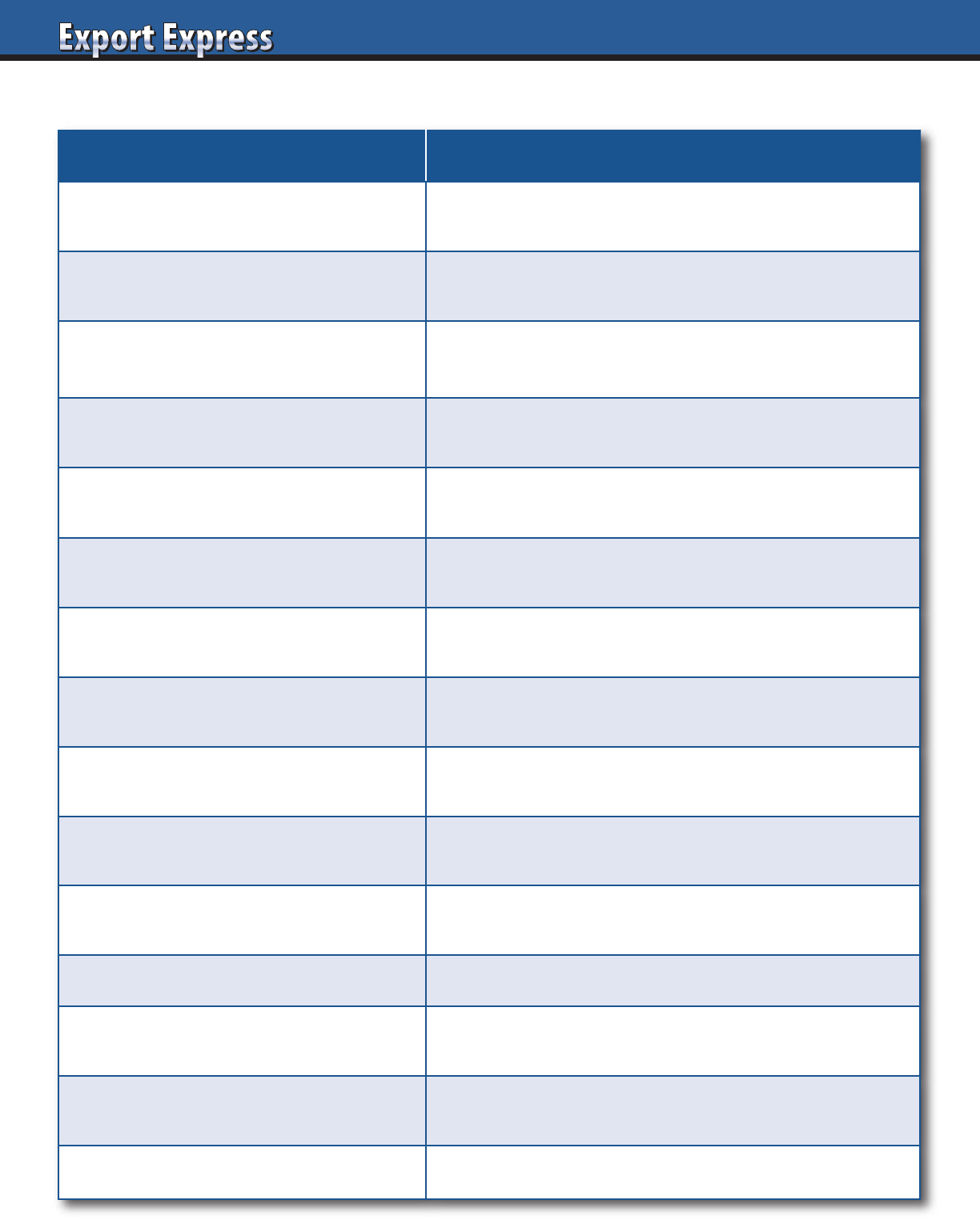
Export Solutions: 15 Common USA Issues
Key Issue Solution
Difficult to manage USA from abroad.
Hire one national sales manager to manage business.
Or consider contract sales management team like Ram Group.
Headquarter authorization for my brand, but
I can’t find it at retail.
Hire a broker for store level coverage.
Store level distribution may be 60% or less without broker coverage.
My brand sells well in New York, but not
elsewhere.
New York is unique and represents only 7% of USA population.
Markets like Atlanta, Dallas, Phoenix & Seattle are more representative.
Slow sales from the shelf for my product.
Try a coupon (Sunday insert or on-pack).
Increase TPR allowance level from 10% to 25%.
Walmart doesn’t want my product.
Walmart sells basic items for value conscious consumers.
Recommended focus: upscale retailers Whole Foods, Publix, etc.
My broker is a “one man” organization.
Large Brokers (Advantage or Crossmark) have 20,000 employees.
Find a broker offering retail coverage and category analysts.
My Importer (or Broker) claims sales to Kroger
or Albertsons, but sales are low.
Check number of chain stores where your brand is authorized.
Kroger has 2,726 stores. How many are you in?
Importer/Broker is not achieving objectives.
Export Solutions provides independent guidance on
assessing your business and providing realistic solutions.
Secure distribution without paying listing fees.
Target the ethnic channel and non-slotting retailers
like World Market & Trader Joes.
Fancy Food Shows not generating
quality buyer contacts.
Try Exhibitions focused on your Category.
Sweets and Snacks for Confectionery, NACS for Beverages etc.
Importer/Broker achieves results at East Coast
supermarkets, but struggles elsewhere.
Appoint channel and customer specialists.
No one importer or broker is successful everywhere.
How do I secure distribution at Costco? Great quality, large size pack, and commit to demos.
Is Private Label or Foodservice worth the effort?
Private label/foodservice dominated by local producers.
Focus energy on upscale supermarkets first.
I know a guy with connections at Kroger,
Walmart, etc.
200,000 + sales people in USA with customer relationships.
Partner with a “company” with valid business track record.
Brokers are not interested in representing
my brand.
Offer to pay a minimum pioneering fee, with a success bonus.
8
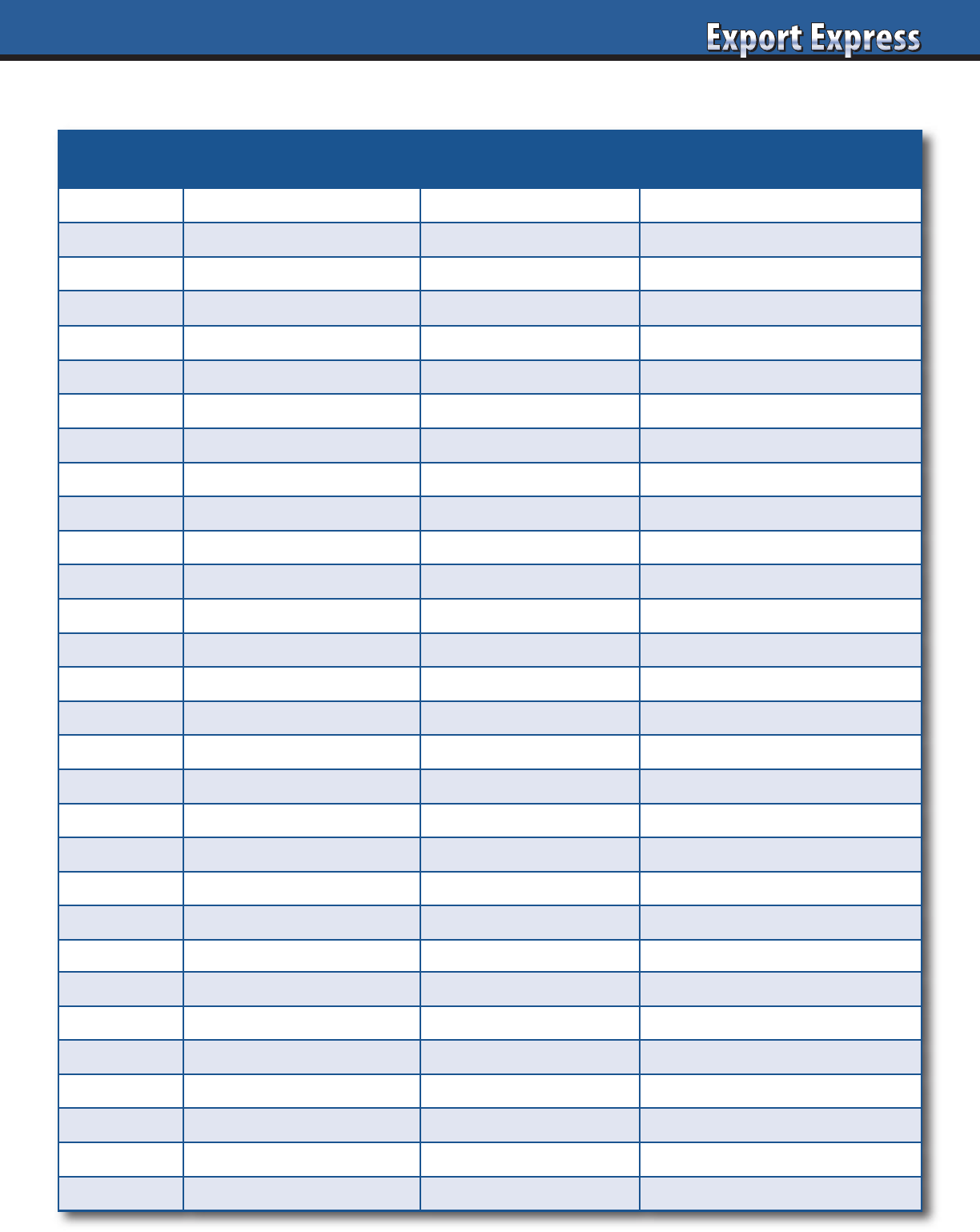
USA Retailers – 30 Channel Specialists
Channel Customer Dollar Sales (billions) Comments
Club Costco 140 Revenues from 575 USA stores
Club Sams 75 Revenues from 600 USA stores
Club BJ's 15 225 stores. Primarily North/Florida
Distributors UNFI 27 Supplies Whole Foods, Stop N Shop etc.
Distributors Kehe 5 Supplies Publix, HEB etc.
Distributors DPI 1 West/Mid-Atlantic
Dollar Dollar General 33 18,500 stores
Dollar Dollar Tree 14 7,850 USA stores
Dollar Family Dollar 12 8,100 stores
E-commerce Amazon 275 Online USA sales (ex. web services)
Foodservice Performance Food 45 Includes Core-Mark
Foodservice Sysco 44 National, reflects USA sales only
Foodservice US Foods 30 National
Foodservice Smart & Final 4 254 cash & carry outlets
Gourmet Whole Foods 17 510 USA stores
Gourmet Trader Joes 18 530 stores
Gourmet Sprouts 6 370 stores
Hard Discount Aldi 20 2,100 stores
Hard Discount Save A Lot 4 900 stores
Hard Discount Lidl 1 155 stores in East and South
Pharmacy Walgreens 115 9,020 Pharmacies
Pharmacy CVS 100 9,962 Pharmacies
Pharmacy Rite Aid 17 2,488 Pharmacies
Supercenters Walmart 370 Sales for 3,571 supercenters
Supercenters Target 105 Total sales for 1,900 stores
Supercenters Meijer 23 260 Stores in Central USA
Wholesalers C & S 30 Supplies 7,700 stores
Wholesalers Associated – Kansas City 12 South/Central USA
Wholesalers Spartan Nash 10 Central USA
Wholesalers Bozzuto’s 0.5 Northeast, supplies 1,200 stores
9
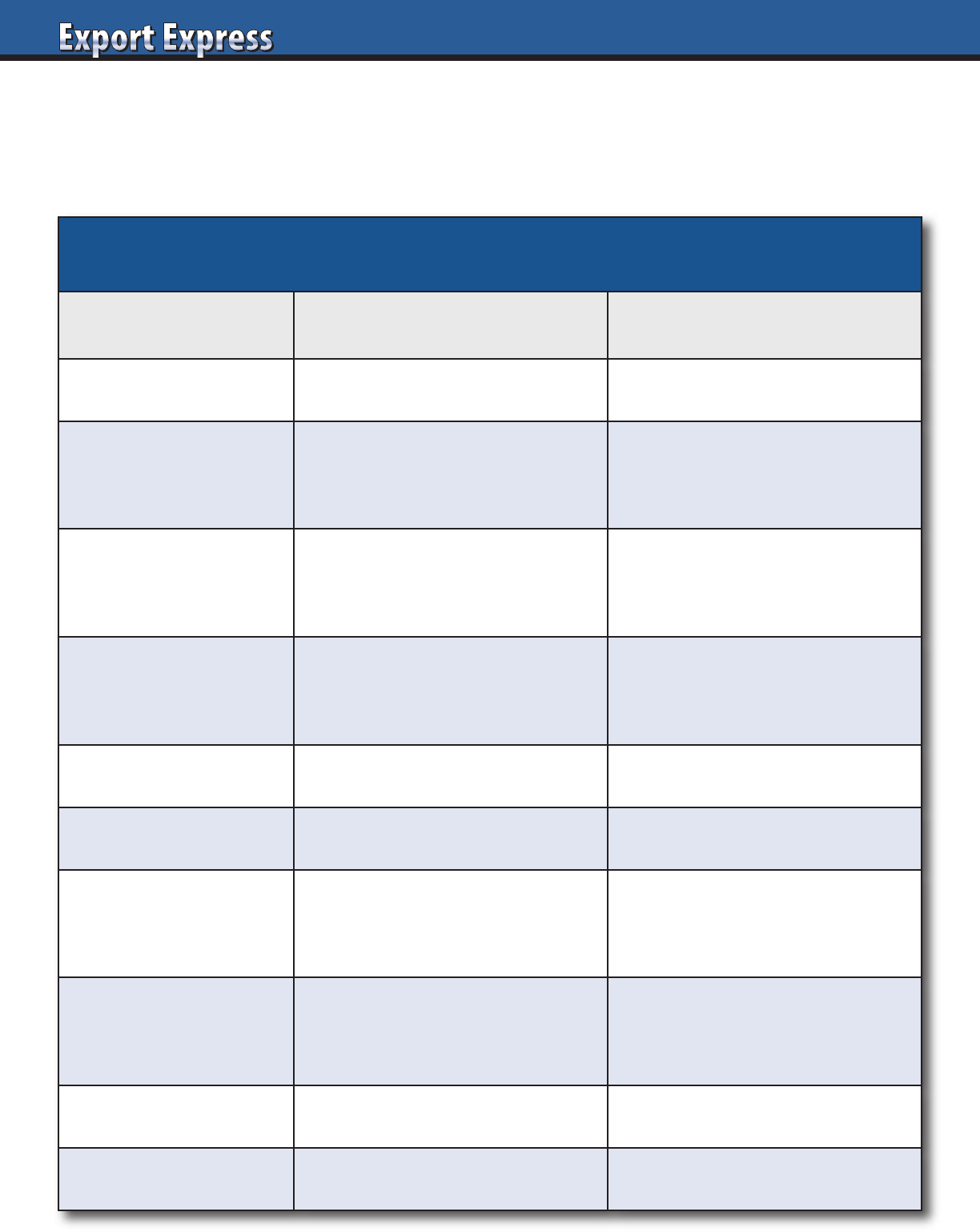
Retail buyers are challenged to maximize profits and sales from every available inch of shelf space. Every new item accepted must
improve on the performance of the brand currently occupying that space. Buyers are overwhelmed by new product offerings, all
with ambitious promises. Improve your chances of success by incorporating Export Solutions’ 10 point check list on how to excite
your category buyer about your new product.
How to Excite Buyers – New Product Checklist
Buyers: New Product Assessment
High Interest Low Interest
Category Opportunity Large or high growth Declining or niche
Brand Owner
Multinational or proven local.
Category expert
New foreign supplier
or start-up
Innovation
Something new, supported
by consumer research
“Me too” product
Profit Margin
Enhance current
category margin
Equal to or less than
current category margin
Sales Generates incremental sales Cannibalizes existing sales
Marketing Investment Sampling, social media, PR None
Trade Programs Invests in retailer “push” programs Periodic discounts/rebates
Brand Track Record Successful at other local retailers Unproven in the country
Terms/Conditions Attractive deal structure Typical terms/conditions
Representation Dependable local distributor Small, niche entrepreneur
10
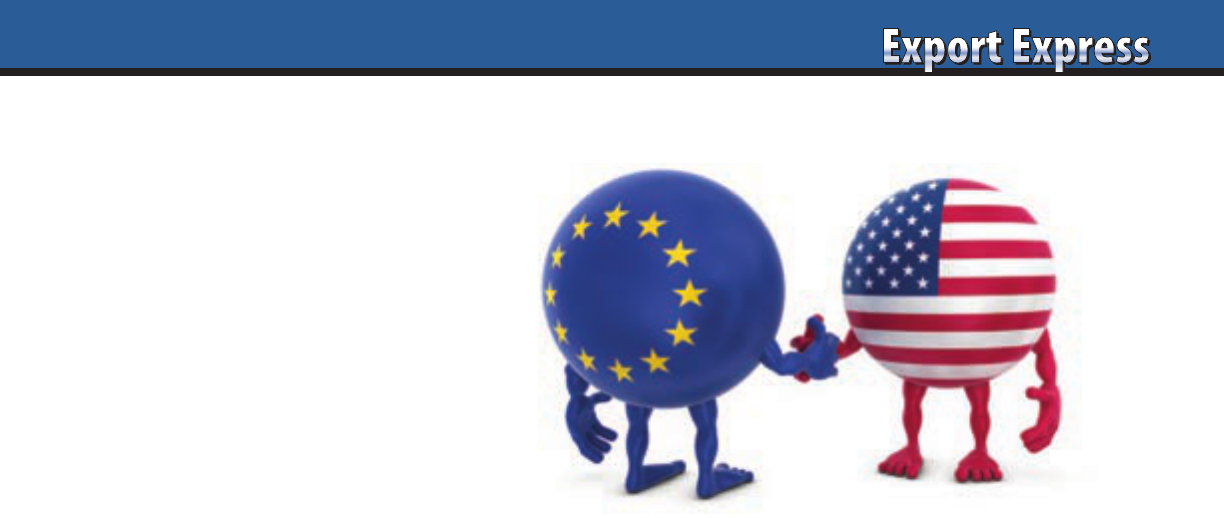
11
Europe and USA combined populations
exceed one billion people. These
developed markets serve as the source of
most of the innovation and inspiration for
the food and consumer goods industry.
Yet the clear fact is that most European
manufacturers sell minimal quantities
to the USA, and American brands are
virtually absent from European
supermarkets. Multinationals like Nestle,
Unilever, Coca Cola, and P & G are
exceptions and play in a different league.
Congratulations to brands like Barilla,
Tabasco, and Pringles that achieve strong
results on both sides of the Atlantic.
However, the list of winners on both
continents is short. This issue of Export
Express explores Lessons Learned and tips
for “Cracking the Code” in the worlds
“First Billion” consumer market.
Euro – USA Importance
Some brands avoid the battle and shift
strategic focus to high growth markets of
Asia, Latin America, and the Middle East.
This approach makes sense for companies
that view export as an opportunistic
source of volume or do not own leading
bands. For most, Europe and the USA
remain attractive targets due to the large,
affluent, populations concentrated in
organized markets. Consumers in
established countries value innovation
and maintain the disposable income
to purchase international brands.
An important point is that Europe
and the USA share many similarities
in eating, drinking, personal care
and home cleaning practices. This
environment creates instant consumer
understanding of our brands features
and benefits versus markets such as Asia
where the vast majority of consumers live
and eat differently.
Problem: “Me Too” Products
Many leading food segments maintain
similar development factors in the USA
and Europe. Supermarkets on both
continents dedicate significant space
to universal categories such as Cookies
(Biscuits), Coffee, Cake Mix, and Cereal.
Innovation sweeps the globe, so it is a
major challenge to differentiate versus
existing choices. In our home countries,
we enjoy the benefits of local
manufacturing, scale, and a tradition
of linkage with the consumer. However,
these benefits disappear quickly as a USA
brand attempts to sell to Europe or vice-
versa. In fact, drawbacks emerge
instantly, starting with overseas freight,
duties, and distributor service fees. These
routine costs translate to dramatic price
premiums where your product may cost
2-3 times on the shelf versus comparable
local brands with years of marketplace
heritage. In reality, your initial overseas
business base may consist of homesick
expatriates willing to pay any price
for their favorite candy or tea brand
from home.
Shopping Habits
A typical USA supermarket averages
50,000 square feet and stocks more than
40,000 unique items. Private Label is
present, but accounts for only 19% of total
sales. As a result, USA stores have plenty
of space for international brands willing
to “pay to play.” USA shoppers visit 4-5
stores per week across different trade
channels, always on the hunt for bargains.
Europe features a mix of large and small
stores, but the reality is that the common
supermarket is only half the size of a USA
store. Shelf space is very limited, with real
estate allocated to fast moving brands and
private label. Gaining entry to European
stores is a challenge for local producers,
let alone foreign brands.
What is Your Pull Strategy?
Congratulations! Your brand has been
listed at a European supermarket.
The good news is that you may achieve
a respectable level of sales simply by
being one of the small number of choices
on the shelf. Naturally, sales will be
proportional to your investment in
consumer awareness and trade promotion
activities. Globalists will argue that it is
much easier to get on the shelf in the
USA, but much tougher to “sell out.”
USA consumers face a sea of choices
and dedicate less than 10 seconds to
making a purchase decision. Success in
the USA demands investment in coupons,
trade ads and price reduction offers.
Investment Level
The USA market includes 333 million
consumers. German population hovers
around 83 million, with France and
the UK weighing in at 67 million and
67 million, respectively. Brand owners
should ask the fundamental question
of “What a $100,000 investment buys in
their country?” Then, that investment
should be divided by the number of
people in your target country. For
example, $100,000 allows some
meaningful activity in a country like
Denmark or Ireland or Chicago. On the
other hand, $100,000 is a small sum for
the entire USA or even Canada which has
38 million people. Best practice suggests
using your “$100,000” budget to drive
high impact promotions at a handful of
USA retailers or 1 or 2 European countries.
Brokers Versus Distributors
Food brokers are the dominant
outsourced model for selling to the
USA supermarket channel. Virtually all
companies from giants like Nestle and
P & G to start-ups hire brokers. Core
broker services are key account selling,
category management analysis and
mandatory retail merchandising. In the
USA, the term “distributors” refers to
wholesale distributors like UNFI who
handle slow moving specialty food
items. USA importers play a role for
international brands, but represent only
one percent of USA turnover. In Europe,
distributors serve as the key partners for
foreign brands. Distributors provide an
Europe vs. USA – Vive La Différence
continued on next page
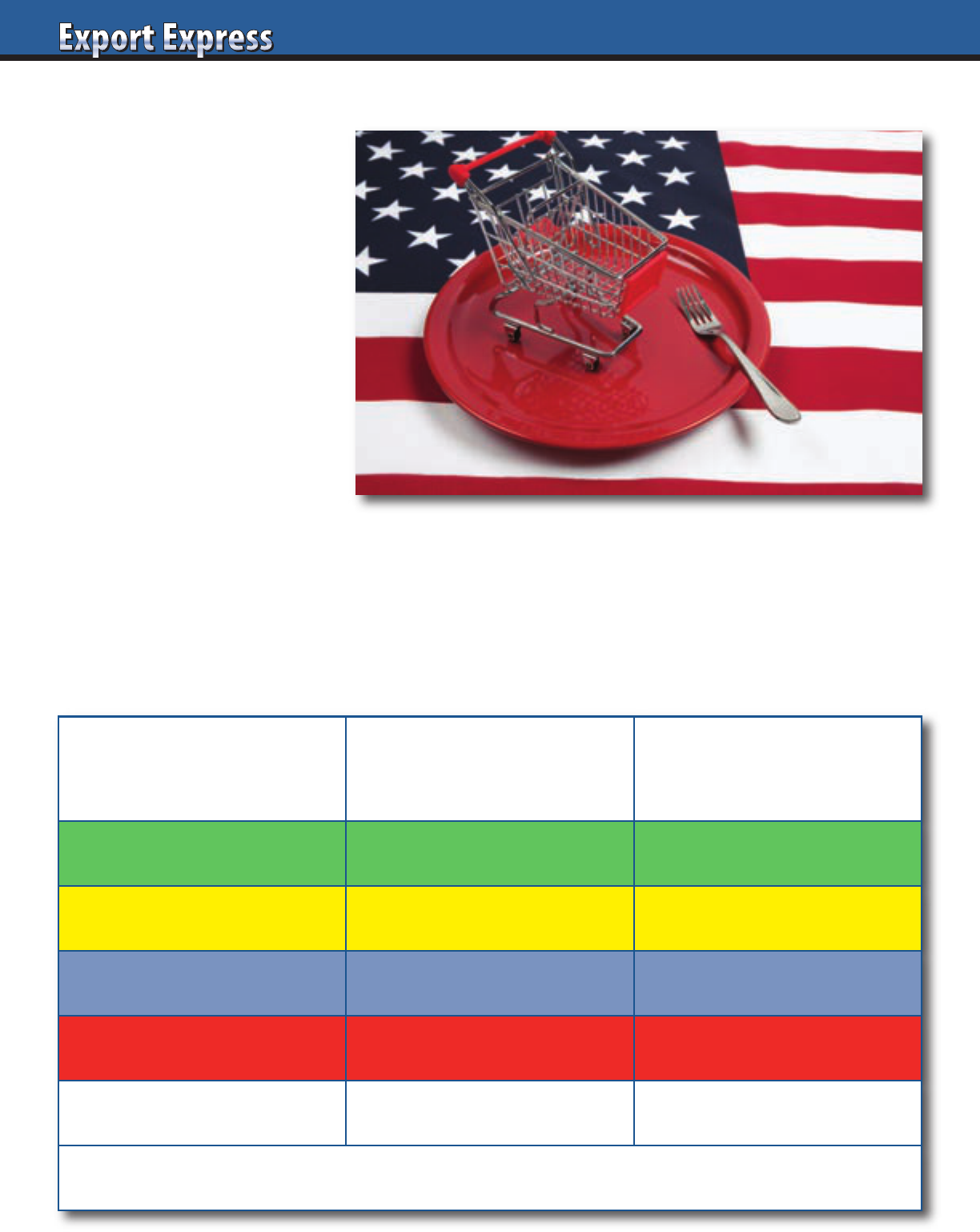
12
integrated portfolio of selling, logistics
and financial services. As with brokers,
there are significant differences in
capabilities between giant power
distributors and small “one man show”
companies. Export Solutions’ distributor
database tracks more than 2,840 European
distributors and 536 USA brokers.
Crawl, Walk, Run
USA brands looking to enter Europe
should target the UK and Ireland as their
first point of entry. Find a distributor with
a successful track record at importing
other USA brands. Waitrose, Whole Foods
Costco, and perhaps Asda (Walmart) may
be logical first customers. Next stop
would be the Nordic region which values
premium products and contains many
excellent distributor options. Many
European brands are already in the USA
with modest sales. Hire a USA based
employee and locate a “mid-size” broker
to handle your brands. Focus on a limited
number of upscale supermarket chains
with 50-150 stores each. Invest in trade
activities to do it right at these accounts
prior to expanding attention to giants like
Kroger and Publix.
Need a Hand?
Export Solutions can help on both sides of
the Atlantic! I have been a featured speaker
for ESMA, the European Distributors
Association and am well connected with
distributors throughout Europe. I have also
spoken to European manufacturer groups
in Germany, Italy, and the UK on USA
entry strategies. Export Solutions has
helped Italian, German, UK, and Dutch
companies on USA business development
strategies. Our approach is “sales
oriented,” focused on creating tangible
solutions to create new sales.
Europe vs. USA – Vive La Différence
continued from previous page
USA Population by Region Population (millions)
Percentage of USA
Population
South 128 38%
Northeast 57 17%
Midwest 69 21%
West 29 24%
Total 333
*estimated 2022
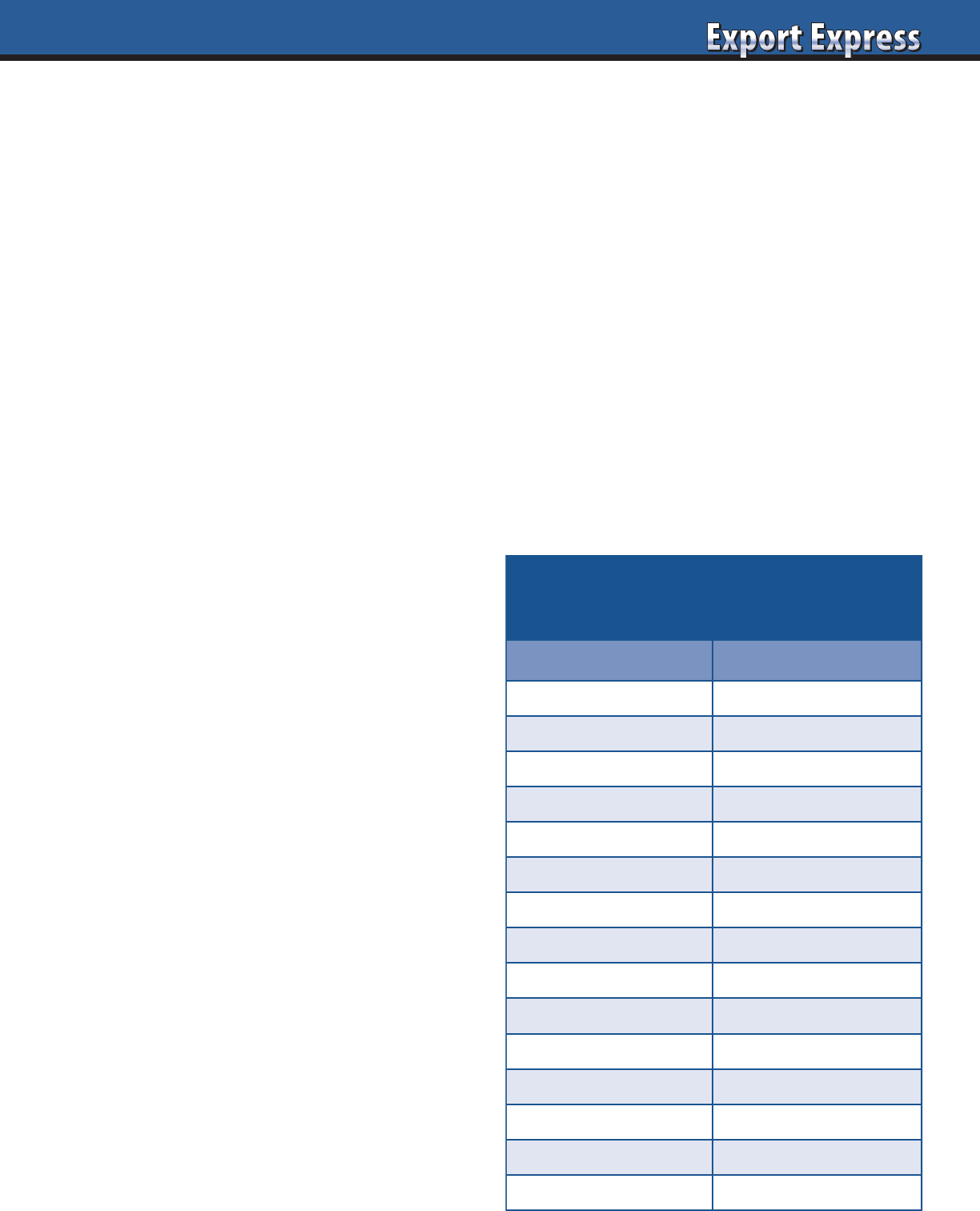
13
The USA represents the world’s largest market. A small market
share in the USA can represent a bigger business than owning
a 50% market share in a smaller country. Many international
brands fail to reach their potential in the USA as they treat it as
just another export market. Listed below are Export Solutions’
ten tips for improving your results in the USA, a consumer
market of 333 million people.
1. Develop a Channel Strategy
The USA Food business is segmented into 13 channels, with
supermarkets claiming an average of 52% of the business. Other
important channels include Supercenters, Mass, Foodservice,
Value, Club, Convenience, Natural, Gourmet, Internet, Military,
Gift, and Ethnic. One strategy is to concentrate efforts on winning
in one channel to gain traction, versus spreading efforts in too
many areas.
2. Optimize Results at Top 10 USA Retailers
Think Walmart, Kroger, Publix, and Food Lion that all operate
more than 1,000 stores. Many companies claim that they “sell to
Walmart.” The key question is to identify a chain’s store count
and measure how many of those stores your brand is available
in. Last year, an important European beverage brand told me
that they were “selling to Walmart.” Turns out that his follow up
investigation revealed that he was selling to only 46 of Walmart’s
3,571 supercenters.
3. Think Beyond New York
None of the top 5 grocery retailers maintain a presence in metro
New York. The USA has experienced a population shift to the
South and West, with the Northeast actually representing the
smallest of the four regions. Visit Atlanta, Houston, Los Angeles,
or Miami to get a more accurate gauge of industry dynamics.
4. Use a Broker
In the USA, the brokers play a unique role, touching virtually
every brand in the supermarket aisles. Even importers use
brokers to supplement their own efforts. Export Solutions’
database tracks 536 USA brokers, including the “Big 3.”
5. Retail Services are Required
Great news! You just received a listing at Kroger or Albertsons.
Your work has just begun. Planogram integrity is an enormous
issue in the USA. Compliance levels of new items at store level
may reach only 60% without a broker at store level to “cut in”
your product and monitor its availability.
6. Data Driven Decisions
The USA market is blessed with the most sophisticated analytic
tools that are used on a daily basis. This includes availability
of point of sale data at the chain (and sometimes store) level
to measure everything that scans. Business building and selling
incorporates use of post promotion analytic tools, market basket
studies, and brand sales by demographic cluster.
7. Try a Coupon
USA Sunday newspapers are jammed with coupons offering
consumers small discounts (.25 - $1.00) to purchase a product. Many
supermarkets up the ante, by doubling the value of the coupons.
This is a proven strategy to drive listings, generate trial, and repeat
purchase. A coupon can force a retailer to carry your product, as he
does not want to disappoint a customer with a coupon.
8. Hire a Sales Manager
An international company should place at least one person in
the USA to manage their interests. Hire a veteran sales person
and locate him in a home office in a city with a great airport like
Atlanta or Chicago. This role will allow him to manage your
distributor and broker network. You can also hire a contract sales
management group like Ram to perform this function. Hiring an
employee based in the USA signals that you are serious about
building your business in the USA.
9. TPR
This stands for Temporary Price Reduction. USA supermarket
aisles are filled with hundreds of these tags. The consumer
recognizes these tags to signal a special discount and “time
to buy.” TPR’s are normally 10% of everyday price and can be
an efficient spend particularly on a “scan down” program.
10. Ethnic Channel: First Stop
Your product will be well received in channels specializing
in your country’s products. There are well established retailers
specializing in Hispanic, Asian, British and Italian Foods.
Whole Foods and Cost Plus World Markets offer good
assortments of international brands.
Ten Tips for Foreign Brands: USA Growth Strategies
Good USA Chains for
International Brands
Retailer Stores
Ahold-Delhaize 2,050
HEB – USA 355
Meijer 260
Wakefern/Shop Rite 361
Whole Foods 510
Hy Vee 285
Giant Eagle 216
Wegmans 106
Harris Teeter 260
Sprouts 370
Raleys 126
Fresh Market 159
World Market 242
Gelsons 27
Kings 19
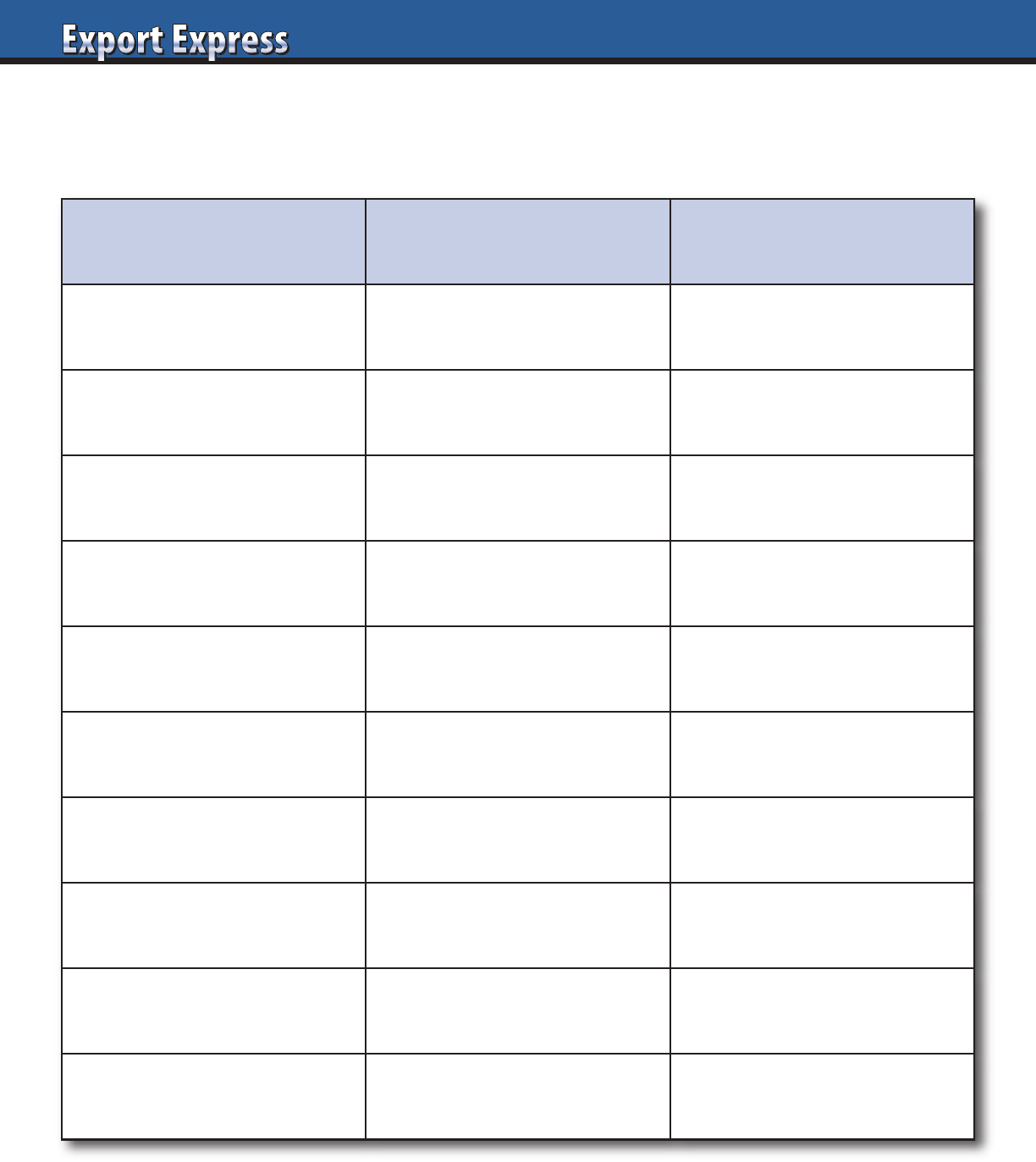
14
USA vs. Europe
Differences – Industry Fundamentals
USA Europe
Store Size (avg.) 50,000 sq. feet 20,000 sq. feet
Unique Items/store 40,000 18,000
Private Label Value Share 17% 25-50%
Price List (wholesale)
Same pricing model
for all retailers
Price may vary by retailer
Annual Negotiations Category Review Standard Practice
Organizational Model Food Brokers Food Distributors
Data Transparency Account/Store Level Data Country Level Data
Store Level Service
Merchandisers required
for compliance
Conditions controlled by
Chain Headquarters
Retail Coverage National/Regional Unique retailers by country
Sunday Coupons Popular Practice In-ad only
Note: Every market maintains differences. However, industry manufacturers
everywhere share the common goal of securing more shelf presence while retailers
demand more discounts.
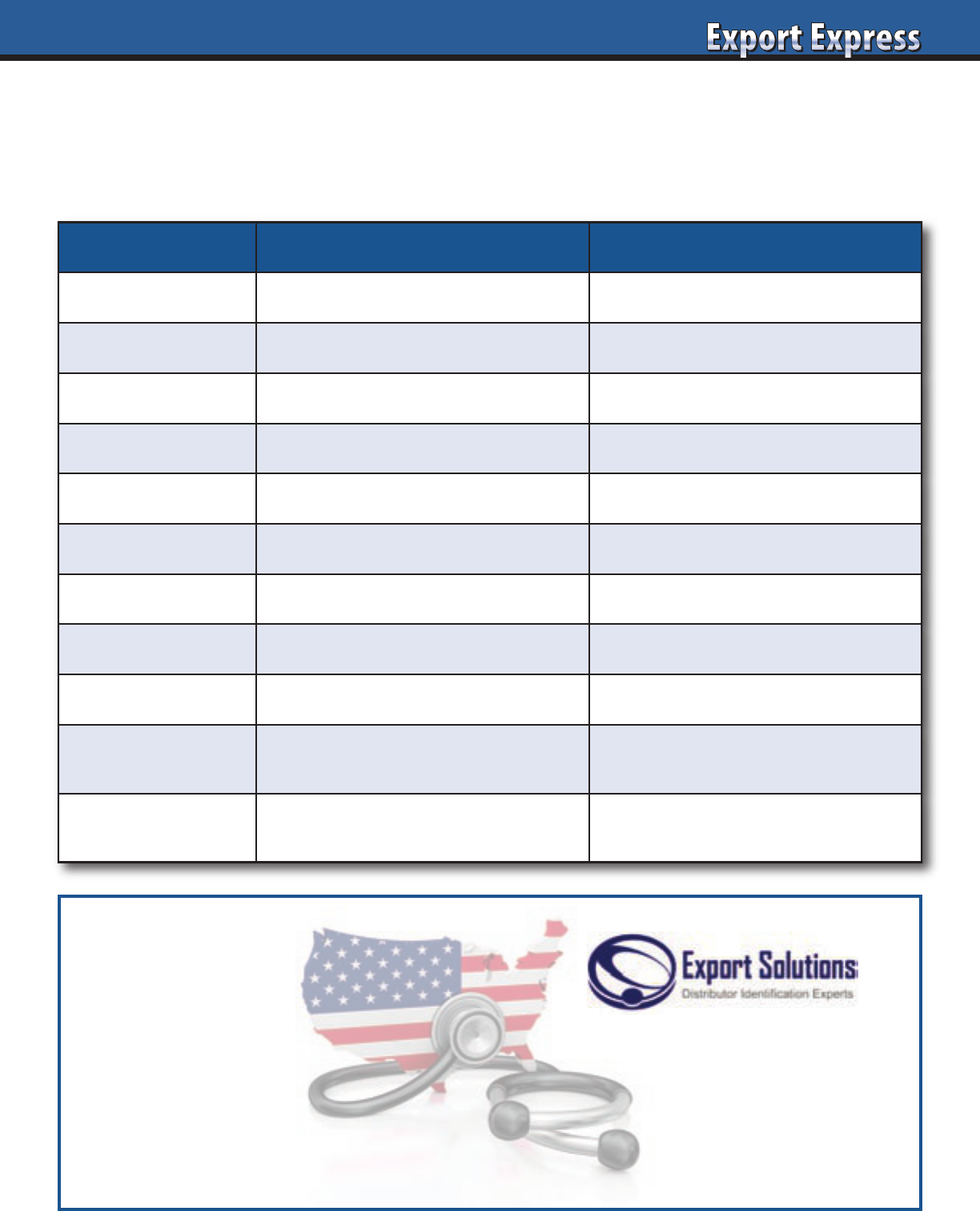
15
USA Sales – Next Level Strategies: 10 Tips
Most European brands remain frustrated by their lack of progress in the USA market. Many companies completed a first step,
with listings at World Market and Eataly (6 stores), but failed to gain traction at big chains with 200+ stores.
June Fancy Food optimism fades by October. Your boss is committed to the USA, but demands better results before bigger investments.
What do you do? Call Export Solutions!
Assessment Area Considerations Insights
Consumer Target
Who is your target consumer? Millennials, foodies, homesick expats
Channel Strategy
Unique strategy required: upscale supermarket,
e-commerce, specialty, and mass retailers
Priority: Upscale supermarkets, gourmet stores,
ethnic stores, e-commerce
Route to Market
Channel, regional, and customer experts required Determine ideal broker profile.
Focus first on good brokers, then buyers.
USA Manager
Mandatory oversight of your USA development Results proportionate to salary.
Locate close to distributor or Atlanta, Chicago
Trade Promotion
Customer specific plan required Invest in strong programs at 10 key retailers.
15% TPR promotions will not excite anyone.
Export Solutions
USA market development helper for
European brands
Point of difference: Retail reality focus.
Targeted, logical road maps. Sales oriented.
Cost to Serve
Implement strategies to reduce price gaps versus
“Made in the USA” products
Evaluate options to create more efficient cost
structure: factory gate to store shelf.
Digital Savvy
What is your social media plan?
How much are you selling through Amazon?
Digital is targeted and cost effective.
Amazon grocery: growing 30% + in USA.
Lessons Learned
What is working? Why has business not scaled?
Barriers to progress?
Independent validation and solutions provided
by USA market expert.
Benchmark Brands
Which overseas brands are winning in USA? Study best practices: Barilla, Bonne Maman,
Colavita, Filippo Berio, Lee Kum Kee, Rana,
San Pellegrino, Walkers Shortbread
Retail Safari
How do I accelerate sales in the USA? Export Solutions retail safari program yields
tailored insights and best practices for succeeding
in the mainstream USA market.
Hire a USA Expert
• USA strategy recommendation
• Category analysis and
plan development
• Identify priority channels,
regions, and retailers
• Brok er/Distributor
identification Specialist
• Have a USA pro with 20+ years
experience on your team
Contact Greg Seminara at
discuss your USA development project.
www.exportsolutions.com
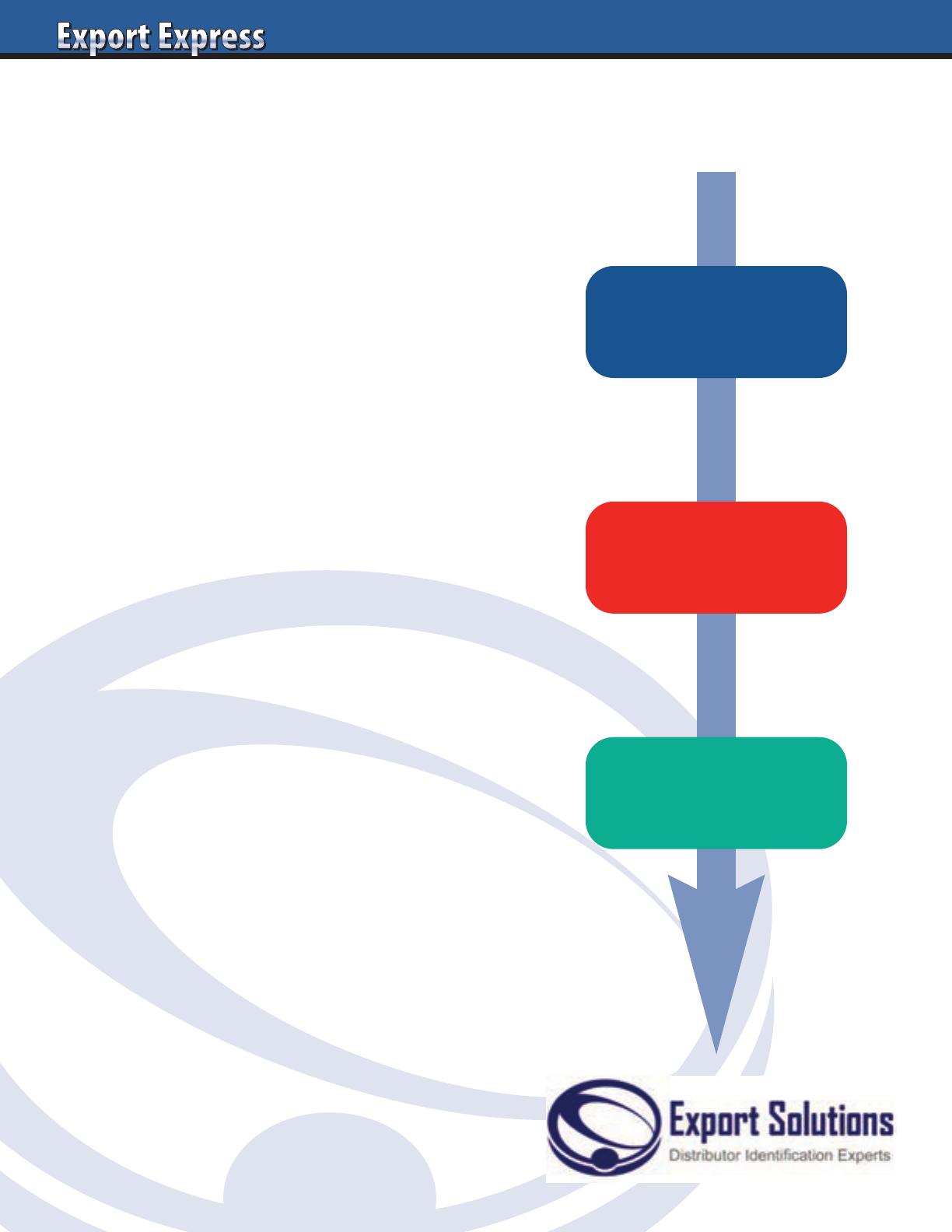
16
Take Your USA Business to the Next Level
Export Solutions Services
Current Business Assessment
Opportunity Gap Analysis
Customer/Channel Prioritization
Broker, Importer, Distributor Identification
USA Entry Plan
Measures: Concept to Shelf
Consumer/Trade Promotion Plan
Connect with Channel/Retailer experts
Team staffing and recruitment
Double Your Business Plans
“Spend time Selling to Distributors
versus Searching for Distributors”
www.exportsolutions.com
Analysis
Partner
Sell
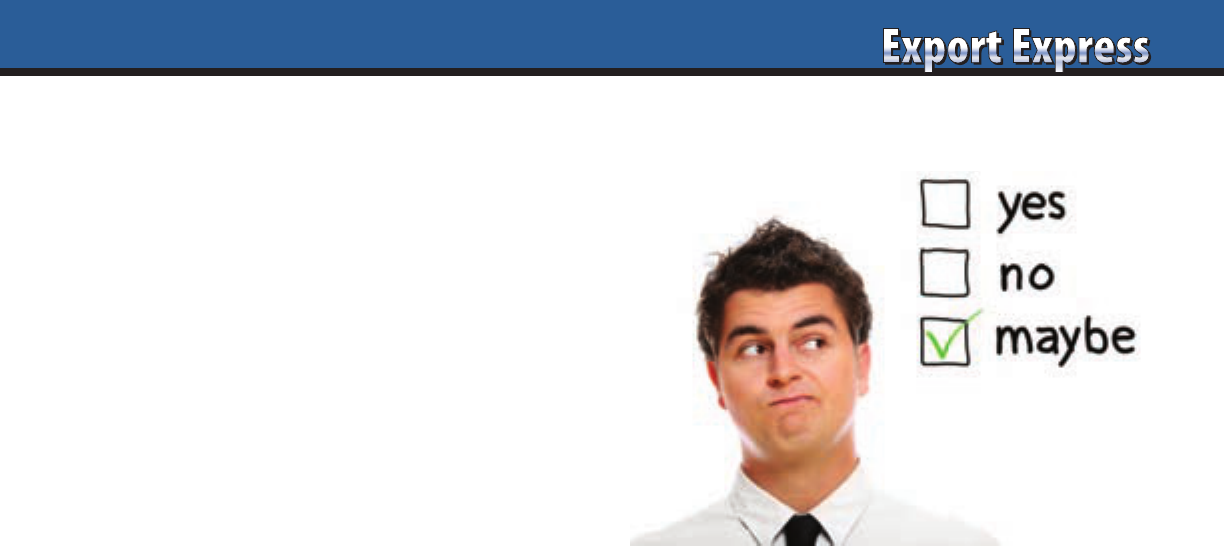
17
Outsourcing of sales functions to channel specialists is a common
organizational strategy in the USA. Third party service providers
include Food Brokers (now formally known as Sales & Marketing
Companies), Distributors, Importers, and Merchandising Service
Organizations. Most retail channels require a unique approach.
How do I determine the right strategy for my brand?
Project Sales by Trade Channel to Determine the Source of Your Volume.
In the USA, there are 13 trade channels: Supermarket,
Supercenter, Mass, Club, Ethnic, Natural Foods, Convenience,
Drug, Dollar Store, Gourmet, Gift, Internet, and Military for most
food products. Hardware is important for Non-Food products
and department stores for personal care brands. Normally,
supermarkets account for 52% of sales for a food brand, but only
30% of sales for “non-food” categories like cleaners, personal
care, or health care.
Determine the Services Required and the Complexity
of Ongoing Maintenance.
Certain categories require a high focus on store level activity
and speed to shelf. In other categories, it is sufficient to “sell in”
at headquarter level and let the retailers’ systems execute for
their stores. Brokers and MSOs are the primary options for
performing in store work.
Evaluate Your Internal Resources.
How many direct people will your organization have focused
against customer development and sales execution? What can
your own organization realistically handle? Do you have people
based locally close to the retailer and people with experience
against leading retailers or trade channels?
Determine the Channel Specialists
Many companies employ a food broker for the supermarket
channel (at minimum: retail services) but prefer to deal directly
with Club, Drug, and Dollar Store channels. Importers and
Distributors function well for natural food products, gourmet
specialty foods, ethnic foods, and imported brands.
Hybrid Approach May Be Optimal
Walmart prefers to negotiate directly with its vendors. Many
manufacturers hire a broker for retail services at Walmart to
supplement their own activity at headquarters. Merchandising
Services Organizations excel at dedicated, short term projects
and handling time consuming reset work.
USA Distributors Act As Wholesalers
The USA distributor model is different from the international
model. USA distributors are wholesale distributors providing
selling, logistics, and collection services. However, they rarely
import and do not necessarily work on an exclusive basis
by category.
Importers Need Broker Services Too
Importers provide a valuable service for international brands.
They offer an integrated service portfolio. The larger importers
partner with food brokers for better penetration of the
supermarket channel. As a rule, an importer alone will not
serve as a complete solution for the USA supermarket channel.
A Broker provides local customer expertise on a national basis
plus essential retail services.
Avoid “One Man Shows”
Size matters. There are more than 200,000 sales people in our
USA industry. Everyone claims a “great relationship” with a
specific account. This is a start, but the preferred route is to
partner with a broker organization that offers critical mass,
category management, and retail services.
Big Brokers – Big Brands
“Big 3” USA brokers maintain over 20,000 employees and
impressive sales, marketing, and administrative services.
The Big 3 performance may exceed the capabilities of even
the largest multinationals. In the USA, P & G, Kraft Heinz,
Nestlé, and Unilever all depend on brokers for certain
categories and services. However, most Big 3 brokers are
reluctant to pioneer new companies or represent brands
with modest sales revenues.
Battle for Broker’s Attention
Most outsourcing to third parties represents a “shared
services” approach where the manufacturer is effectively
“renting” a portion of the broker or distributor’s sales force
time. These third parties profit by reselling this sales force
to many manufacturers, sometimes up to a 1,000 companies
in the case of a Big 3 broker. A constant battle exists for a
manufacturer to get their “fair share” of the sales force’s time.
On the other hand, manufacturers must be realistic on their
performance expectations relative to their amount of
compensation to the third party.
Conclusion
The old adage that “no one can execute better than yourself”
does not apply in most cases in the United States consumer
goods industry. In every sector, there are local specialists with
significant critical mass that can execute a well defined brand
proposition in an effective and efficient manner. Manufacturers
should focus their attention on direct relationships with global
leaders such as Walmart & Costco that require a high level
of senior management interaction. International brands may
require a variety of outsourced partners to optimize results
in distinct channels.
USA Market Entry Alternatives: Broker versus Importer versus Direct?

18
Everyone wants to sell to Walmart.
This is logical, as they rank as the
number one retailer in the USA and
Latin America, plus good presence in
the UK, China, Japan, and South Africa.
Walmart’s International business
(outside the USA) is bigger than the total
turnover of Carrefour or Tesco. Selling
to countries where Walmart has stores
makes sense for USA producers.
However, Export Solutions always advocates a strategy of making export
decisions based upon what’s best for the entire country, versus the preferences of an
individual retailer, even if it is Walmart.
Walmart’s Central American buyers have been speed dialing leading brands pursuing
direct purchase agreements. These offers may be hard to resist, but manufacturers must
be fully aware of the implications. Selling direct to Walmart International allows you to
bypass the “distributor system.” This provides Walmart with a cost advantage at store
level of around 15%. This may create a situation where it is difficult to sell to other
market customers, because their list price resembles Walmart’s shelf price.
I visited Guatemala and Costa Rica recently. Walmart places many Direct Import brands
in one aisle, away from the product’s normal category placement. These Direct Import
brands are not supported by the armies of in-store merchandisers that are common in
Latin America. I remember the story of when I served as Director of Sales for Clorox in
Buenos Aires, Argentina. Someone from corporate sold my favorite Hidden Valley Ranch
salad dressing to Walmart International and it magically appeared on the shelves of my
Walmart. I was thrilled, but apparently was the only happy customer. Most in Argentina
had never heard of Hidden Valley Ranch. Without advertising, promotion, and
distributor support, the brand gathered dust and was discontinued.
I am an advocate of partnering with distributors to sell to Walmart’s international
divisions. These local companies sell and merchandise at Walmart and all market
customers everyday. Distributors focus on brand building and can provide the muscle
at store level to push your brand. Retailers benefit because they can reorder any day
versus waiting for the container to arrive from the USA. In my opinion, the distributor
model is usually the preferred route to market to create a sustainable business in these
fast growing countries.
Many European companies are anxious to sell to Walmart's 3,571 USA supercenters.
Slow down! Walmart’s USA supercenters specialize in category leaders and fast moving
brands. Their consumer base consists of middle and lower income customers who have
limited spending power to purchase super premium brands from overseas. Also,
Walmart tends to be the “low price” leader. This may damage your ability to sell to
upscale supermarkets, as they may be hesitant to stock an item that Walmart is carrying
and selling for 15-25% less. My humble advice for European brands is to create a base
business with mid-upscale USA supermarket chains. Approach Walmart at a later stage
with your track record of market success.
Walmart is the world’s number one retailer and will serve as a major factor in our
strategic decisions. It is flattering and encouraging that Walmart wants to sell our
brands. The key is to devise the optimal route to market that builds your brand equity
and facilitates your business development to all market customers, including Walmart.
www.exportsolutions.com
“Spend Time Selling to Distributors versus Searching for Distributors”
Selling to Walmart – When and How?
Greg Seminara
404-255-8387
Strategic Services
Contact Us for
Export Solutions
1. Identify Best in Class
Distributors: 96 Countries
2. Best Practices
Export Strategy
3. Distributor Management
Workshops
4. Export 101:
Let’s Get Started
5. New Market
Prioritization
and Launch Plan
6. Personal Distributor
Introductions:
96 Countries
7. Walmart International
8. Distributor Contracts,
Margins, and Fees
9. Meeting Speaker
10. International
Strategy Expert
Strategic Services
Contact Us for
Export Solutions
1. Identify Best in Class
Distributors: 96 Countries
2. Best Practices
Export Strategy
3. Distributor Management
Workshops
4. Export 101:
Let’s Get Started
5. New Market
Prioritization
and Launch Plan
6. Personal Distributor
Introductions:
96 Countries
7. Walmart International
8. Distributor Contracts,
Margins, and Fees
9. Meeting Speaker
10. International
Strategy Expert
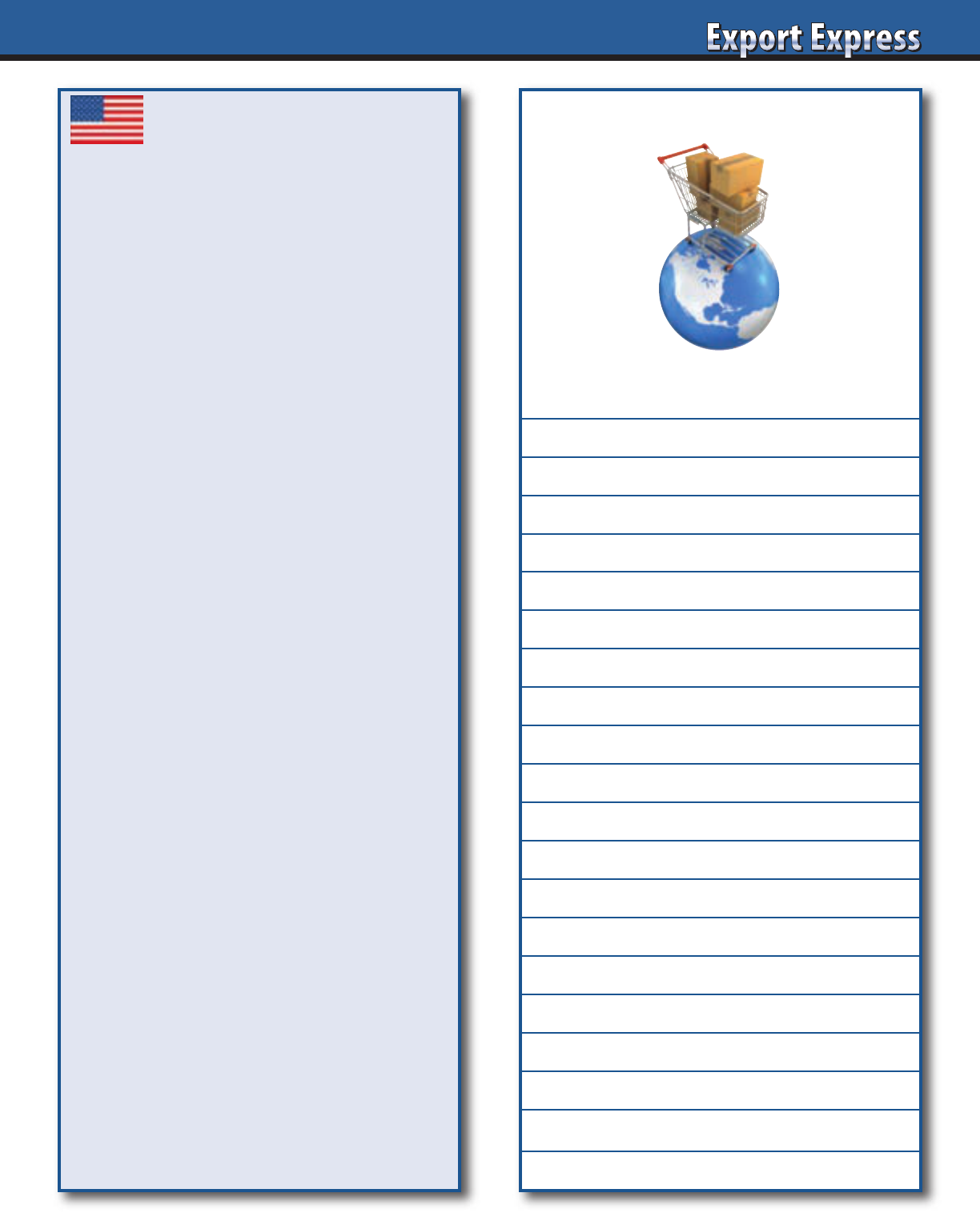
19
USA Case Studies
Export Solutions helps International brands
improve their USA sales or gain initial entry
to the USA
Client: Leading European Canned Food Brand
Project: Design USA entry strategy
and arrange meetings with
leading importers.
Client: European Ethnic Food Brand
Project: Arrange meetings with potential
importers,distributors, and brokers.
Client: Global Beauty Care Brand
Project: Organize and select
USA importer, distributor, and
broker network.
Client: UK – Non-Food Brand
Project: Design USA market entry
strategy. Hire USA manager. Arrange
meetings with leading USA brokers.
Client: Global Confectionery Brand
Project: Design strategy to improve sales
to the USA Market. Analyze category
and hire USA broker network.
Client: Asian OTC Brand
Project: Identify OTC importers
or brokers.
Client: Leading Italian Food Brand
Project: Analyze market to take sales
to next level.
Client: Your Brand
Contact Greg Seminara at
(001)-404-255-8387
to discuss your project.
www.exportsolutions.com
Top 20 USA Grocery Chains
USA Sales
Retailer ($ billions) Stores
1 Walmart SC. 370 3,571
2 Kroger 138 2,726
3 Albertsons 70 2,278
4 Ahold Delhaize 56 2,050
5 Publix 48 1,300
6 HEB - USA 32 355
7 Meijer 23 260
8 Shop Rite 18 361
9 Hy Vee 12 285
10 Wegman’s 11 106
11 Giant Eagle 11 216
12 Winco 10 135
13
Southeastern Grocers
8 419
14 Demoula’s 6 90
15 Save Mart 5 208
16 Stater Brothers 5 172
17 Ingles 5 198
18 Price Chopper 4 131
19 Weis 4 198
20 Raleys 4 129
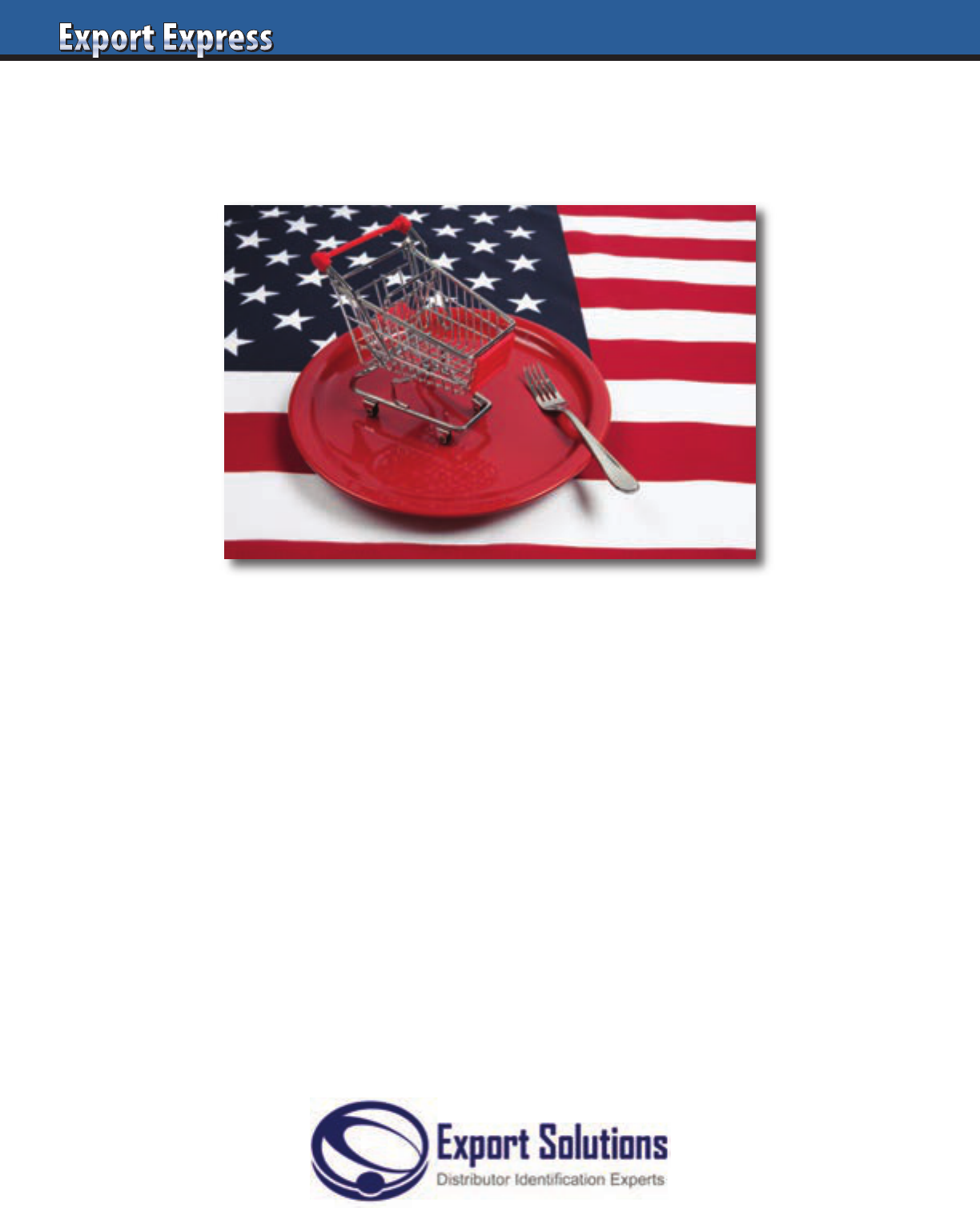
390 USA Customers
How many are you selling to?
Export Solutions Retail Database Covers 390 Customers
258 Supermarket Chains 29 Natural Foods
46 Convenience Chains 28 Wholesalers
Features
3
Up-to-date store counts
3
Direct link to retailers’ web sites
3
Financial information for publicly traded retailers
3
86 Canadian retailers plus 2,200 retailers in 94 other countries
3
Free sample access
Order now: www.exportsolutions.com
20
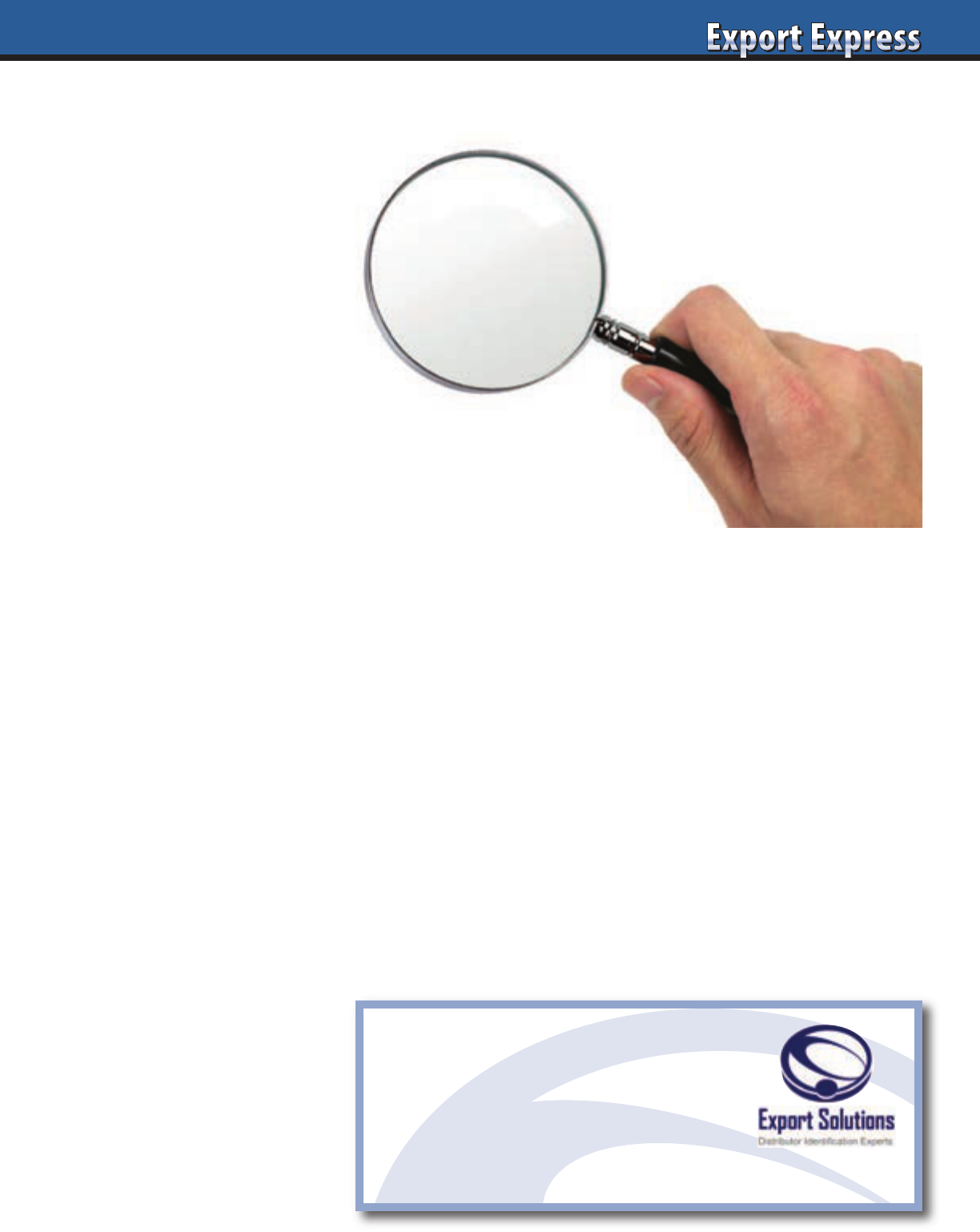
Hiring the right local partner is
the third most important step in
optimizing your sales. This follows
creating a product with a unique
consumer value proposition and
willingness to invest in brand
development activities. Listed below
are some practical tips on selecting the
right company to represent your brand.
Identify a Pool of Preliminary Candidates
Create a large group of potential
candidates. This could include distri-
butors, importers, brokers, or local
producers of related products. Highlight
companies that are specialists in the
market sector that you are aiming
at. Export Solutions streamlines this
process with our online directory of
more than 9,200 distributors, importers
and brokers for 96 countries.
Establish Partner Selection Criteria
What are the key attributes of
your ideal candidate? Product
specialization? Service portfolio?
Existing results for current brands?
Choosing a Large, “Best in Class”
partner versus a “Small, Hungry”
company willing to pioneer a new
brand is an important preference.
Determine Candidates Preliminary
Interest Level
Send a brief summary of your product
proposition and company credentials
to the 5-10 most promising candidates.
A follow-up phone call to your top
candidates is an appropriate personal
connection. Brokers expressing an
interest should complete a brief
company overview recapping their
corporate capabilities: Sales, Logistics,
Marketing, etc.
Schedule a Meeting in the Candidates Office
Normally, we recommend interviewing
at least three candidates depending
on the size and scope of a project.
Schedule the meeting 3-5 weeks in
advance. Provide a specific agenda
at least 2 weeks in advance, including
pre-work such as category market
analysis. Meet the broker’s team that
would work on your business, as well
as senior management. A broker’s
office provides clues on company
culture, scale, and capabilities.
Prepare Interview Questions
and Assessment Grid in Advance
Create a list of key questions to ask
each candidate. Topics could include
local category dynamics, cost of entry,
and Distributor success stories. Create
a standard grid to evaluate and
compare all candidates on a common
platform. See page 25 for ten sample
questions for every broker interview.
Conduct an Independent Evaluation of
Candidates Performance for Existing Brands
Visit target outlets for your product
to observe category conditions. At the
same time, evaluate each candidate’s
performance for his existing clients.
Do his current brands maintain a
strong presence in the market? Or are
his brands hard to find? Conduct these
visits to leading retailers independently,
as an accompanied visit may lead you
to select stores which may not be
representative of marketplace reality.
Reference Checks Represent
an Important Next Step
Request references of 5 of the broker’s
top 10 clients. Call at least three references
and request insights into performance
and capabilities. Acknowledge that
these are likely to be positive references,
but they always provide significant value.
Run a Dun & Bradstreet or other type
of credit report on leading candidates.
Export Solutions is often hired to
conduct independent, confidential,
reference checks.
Invite Top Choice to your
Corporate Headquarters
The visit should include meetings with
senior management, factory tour, launch
planning, and mutual commitment. The
trip serves as an important bonding and
relationship building experience between
your company and your new partner.
My Way: Finding and Selecting the Right Broker or Importer
www.exportsolutions.com/ExportTips
300 Free Articles
Export Strategy
Distributor Management
21
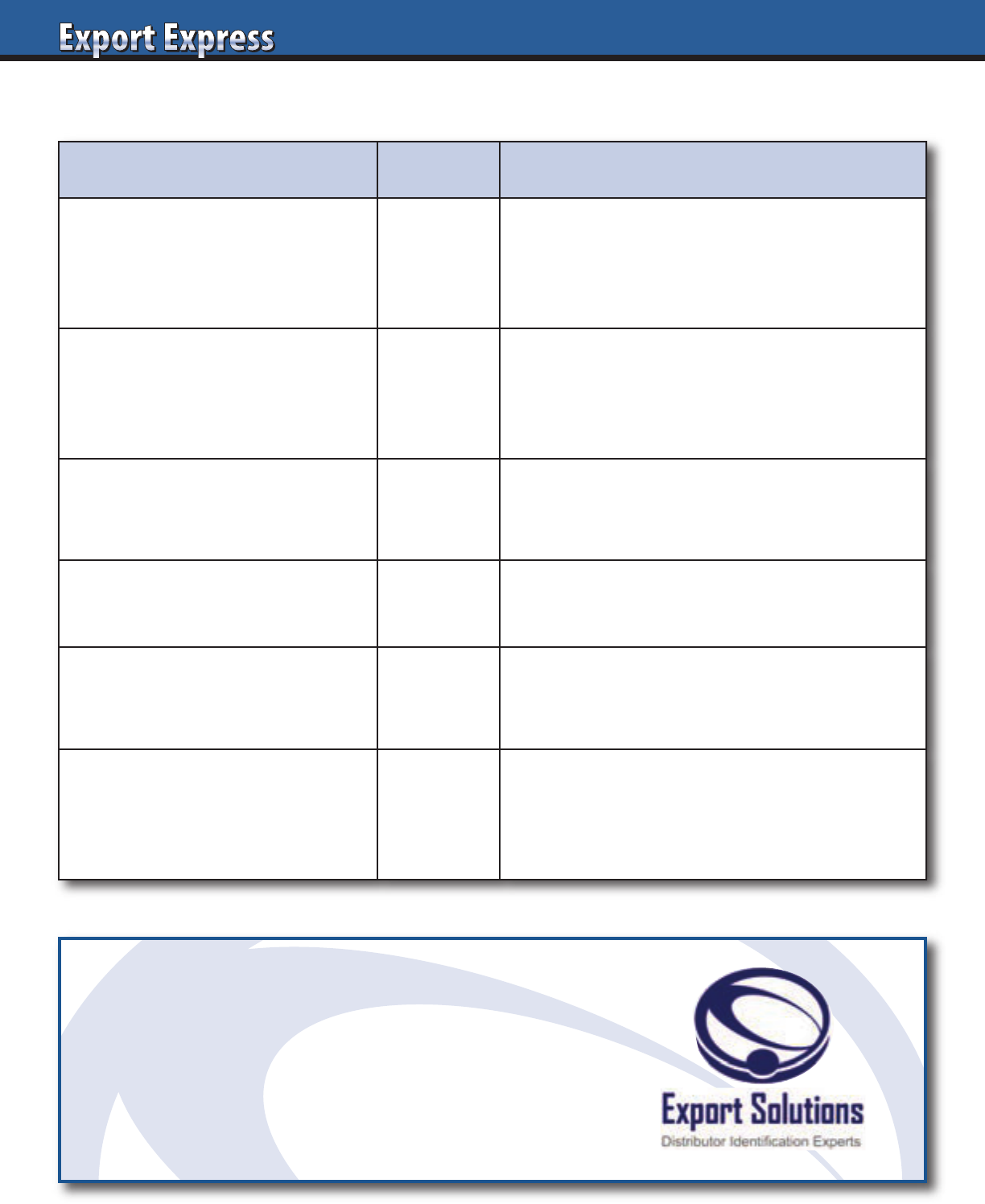
22
Criteria (weighting)
Rating Evaluation Factors
Corporate Credentials 30%
Size, sales force, # employees.
Reputation (reference check existing brands).
National coverage. Key account teams.
Multi-channel coverage.
Category Expertise 20%
Sells brands in my category.
Shelf space for existing brands.
Current brands selling to target retailer.
Category analysis and insights.
Brand Building 15%
Ideas to build or launch my brand?
Marketing plan, cost, timing.
Success stories.
Cost to Serve 15%
Fair, transparent model relative to size
of business, brand investment, and
work required.
Enthusiasm for
My Brand 20%
Advance preparation, CEO involvement.
Follow-up on commitments.
Alignment with your vision.
X Factors: People, Admin.,
Professionalism, etc.
+/-
CPG/FMCG background for leaders.
Efficiency of scheduling meeting.
Office environment.
Do you enjoy the people?
Export Solutions Broker Assessment Grid
Evaluating Distributors or Brokers?
We can help!
Export Solutions performs
Distributor Search in 96 countries.

23
Strong consumer goods brokers
and importers are deluged with
representation inquiries from around
the world. The emails are usually
supplemented by a product catalog and
promise to mail a price list! In a best case
scenario, this type of approach may lead
to a request for more information from a
good broker. More likely, the broker will
skip your inquiry and move on to the
next opportunity in his mailbox. Listed
below are Export Solutions tips for
“breaking through the clutter” and
providing the right information to
generate excitement and interest from
the broker and importer community.
1. What is your Brand USP
(Unique Selling Proposition)?
USP defines your competitive edge
versus all other brands battling for the
same shelf space. The USP can revolve
around quality, value, assortment,
or packaging. However, you need
to validate your claims. For example,
a statement such as “tastes better than
competitors A & B” should be supported
by market research of consumers or blind
tests of a sufficient panel group that backs
your quality claim. Similarly, a retail price
review can demonstrate a “better value”
position. Your USP must also pass the
litmus test: Is your USP relevant to the
purchaser and consumer? For example,
you might offer the only coffee with
orange and lemon flavors, but is anyone
really looking for this product?
2. Have you done your homework
on my market?
The food/consumer goods industry
is relatively transparent. Typically,
brand owners simply need to visit the
leading supermarket chains to obtain a
“snapshot”of local category assortment,
pricing and merchandising practices.
The assortment and shelf space allocation
will provide clues regarding consumer
preferences from a taste/usage
standpoint and potential gaps in the
market. Syndicated data providers
such as Nielsen and Euromonitor supply
reams of data tracking category sales and
trends. New brand representation offers
to brokers that demonstrate a degree of
understanding of local category market
conditions will always receive an
appreciative response.
3. What will the brand owner invest?
The most important consideration after
the USP definition! A broker believes that
he needs the right financial spend levels
to aid him in achieving the results that
he is capable of. The correct spend level
usually reflects an appropriate mix of
trade development funds (listing
fees/shelf space/flier participation)
and consumer awareness activities
(sampling/pr etc.) The brand owner
must acknowledge that there are fixed
fees to enter virtually every market. Some
brokers are willing to split these fees.
It’s usually not enough to case rate
spending unless you have a very strong
proposition. Bottom line: If you are
unwilling to invest in your brand…why
should the broker invest his time and
resources building your brand?
4. Where has your brand been successful?
Your track record at building brands
counts! Share your record proudly,
particularly if the target country or
retailer is well known. On the other hand,
a “Produced in Europe” success story
may not be impactful if you don’t intend
to duplicate the conditions that brought
you success such as local production and
measurable marketing investments.
5. How tough is the job to launch your brand?
Are you attempting to enter a competitive
category dominated by heavy spending
multi-nationals? Or are you aiming at
an attractive niche? What are the brand
owners expectations in terms of product
availability and sales volume?
6. Can the broker make money
with your brand?
Brokers seek to obtain a fair profit for
their activities to support your brand.
Profit must be measured in dollars
contributed versus percent of sales.
Brokers rarely make money during year
one of an introduction as they allocate a
disproportionate share of their resources
to launch a brand. On the other hand,
new brands in current categories for
the broker can bring new profits with
minimal incremental effort. Globally
recognized brands bring prestige to a
broker’s portfolio and may serve as
a magnet to attract other brands. Brand
owners must present a convincing case to
the broker on the incremental profits that
your company can deliver to the broker’s
bottom line.
Brand Owners: What Every USA Broker Wants to Know
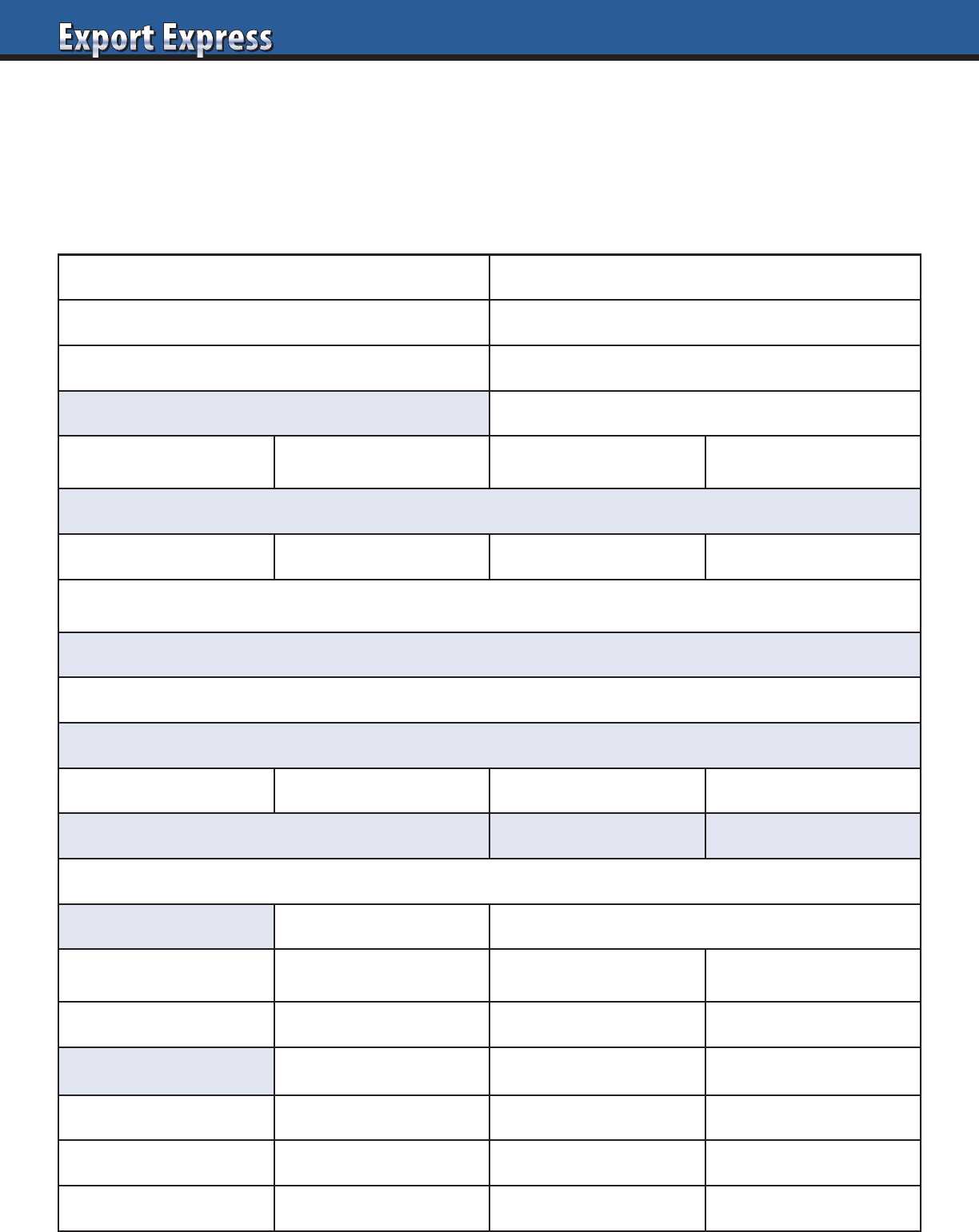
24
Key Contact: Telephone:
Web Site: Email:
Founding Date: Ownership:
Annual Sales: Total Employees:
0-$50 million $50 million - $250 million $250 million- $1 billion $1 billion +
% Sales International:
0-10% 10-25% 26-50% 50% +
Exporter Classification/Description:_________________________ (#1-10, based upon Export Solutions’ scale)
Core Product Range:
Unique Selling Point:
Market Share:
Home Country: Country A: Country B: Country C:
Current Business in Distributor’s Country: Yes/No: Size $:
Current Customers (Distributor’s Country):
Investment Model: Listing Fees*: Yes/No *average $35 per item,per store
Trade Promotion Budget: Dead net price: 10% of sales: Mass:
Marketing: Digital: Sampling: 360 degree:
Ambition/Size of Prize: Sales: Market Share:
Year 1
Year 2
Year 3
Exporter Data Sheet
What Distributors want to Know about Your Company
New Business Opportunity: _____________________________________
(Company Name/Country)
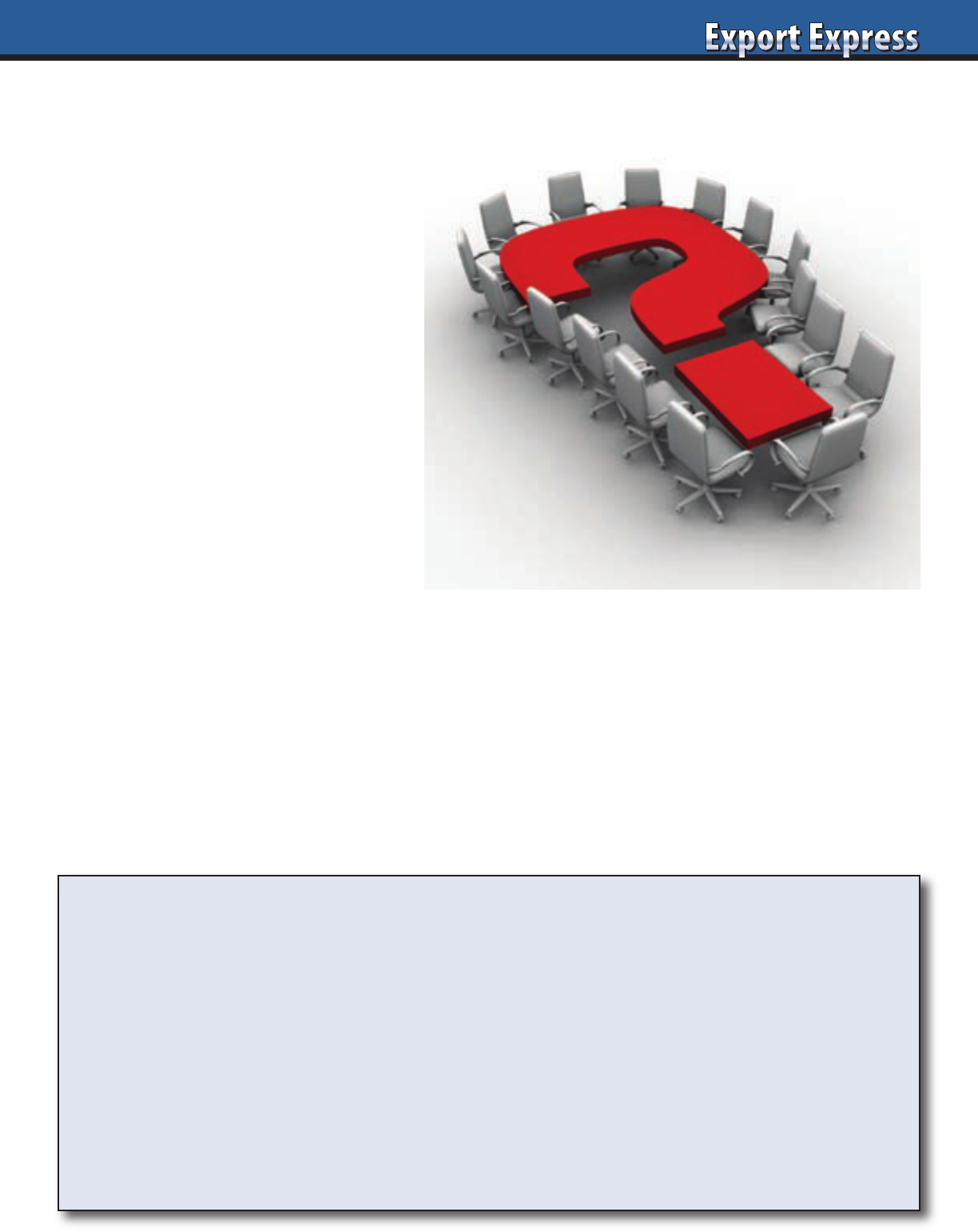
25
10 Questions for Every Broker Interview
1.Company History
How long have you been in business? Who are the
owners? How many direct, “payrolled” employees
do you have? Approximate annual sales volume?
2. Company Brand Portfolio
What are your top 10 companies/brands represented?
For which channels do you represent each brand?
How long have you represented each brand?
Can you provide senior level references at each
“brand owner?”
3. Key Account Buyers
Who is the buyer for our category at the largest
retailers in your market? What other brands do you
sell to our buyer? How frequently do you visit each
major customer?
4. New Product Launch Success Story
Provide a recent example of a new brand
launch success story. Key retailer acceptance?
Cost of entry? How long did it take? Key elements
of the success strategy?
5. Creative Selling
Provide an example where you took an
assigned marketing/brand support budget
and created a successful local program. How
do you measure success?
6. Retail Servicing
How many full time employees do you have visiting retail
stores? Are they located countrywide or just in the capital city?
How do you measure a “good store” in terms of brand presence
versus a “bad store?” Describe your retail reporting system.
7. People
Who would be our point of first contact? Would our contact also
“sell” our brands to major accounts? What other brands is our
contact responsible for? How do we insure that we get our fair
share of attention from your sales force?
8. Business Planning Model
What would your action plan be if we made an agreement to
start with your company? First steps? 90 Day Plan? Reporting?
9. Cost to Serve
How do you model your broker commission? Range
of commission for our brands? How do you manage
trade spending budgets?
10. Enthusiasm for our Company
Why is our brand a good match for your company?
Why are you the best partner in the market for our brand?
What commitment are you willing to make?
3 History of Success pioneering other international brands
3 Strong retail presence for current brands handled
3 Logical launch plan, category analysis, and cost structure
3 Positive references from existing brands and Dun & Bradstreet
3 Enthusiastic about your brand and the business
Greg's Guidance: Broker Assessment Criteria
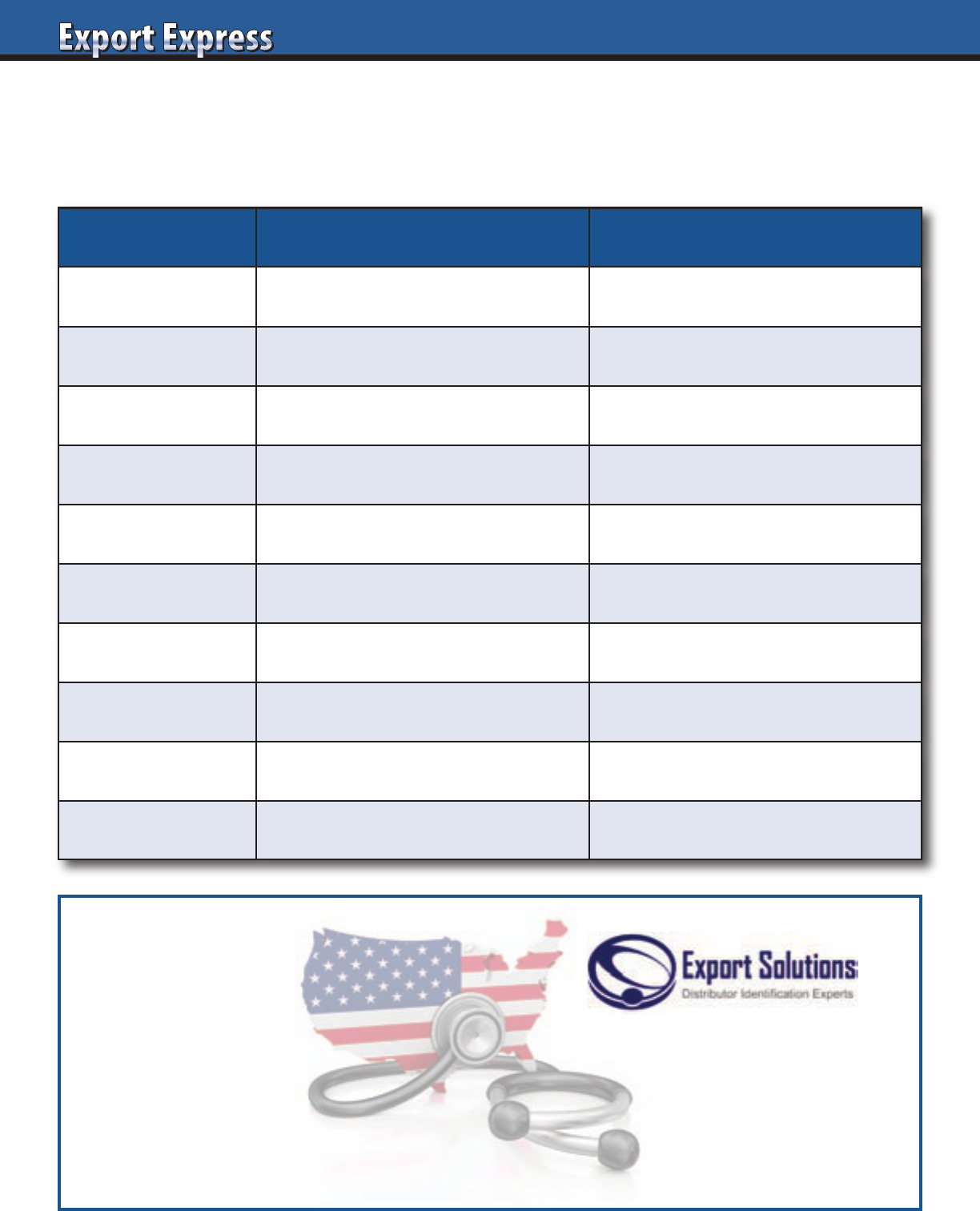
26
USA: 10 Priority Investments
USA development remains a top opportunity for many European brands. Most companies sell to the USA, but maintain sales levels
far below potential. The USA is complex, with 12 trade channels, 390 retailers, 50 states, and food brokers controlling sales. Which
investments will deliver the greatest return?
Investments Strategy Insights
USA-Based
Sales Manager
Mandatory oversight of your USA development. Base salary range: $130 to $200 K.
Location: Atlanta, Chicago or close to importer.
Broker Network
Upgrade channel and regional broker networks. Brokers sell to most customers, not importers.
Bonus brokerage model works!
High Class Retailers
Build sales base with laser focus on retailers
catering to upper income consumers.
Whole Foods, Fresh Market, Harris Teeter.
"From High Class to Mass."
Trade Promotion
Customer specific promotions. Invest in retailers preferred promo vehicles.
15% TPR promotions do not excite anyone.
E-Commerce
Hire Amazon broker to create visibility.
Establish budget for pay-per-click investment.
Amazon: primary source for "homesick"
consumers looking for their favorite brand.
Export Solutions
USA market development helper for leading
European brands.
Point of difference: Sales oriented.
Targeted, logical road maps; USA solutions.
Supply Chain
Analyze options to create more cost efficient
supply chain. “Factory gate to store shelf.”
Consider USA factory or co-packer.
Regional third-party distribution centers.
Sampling
Maximize consumer trial. Direct to consumer,
multi-product, sample boxes are popular.
Everyone loves free trial sizes.
Costco sampling drives sales volume.
Data
Leverage category data to sell your brand.
Nielsen and IRI are respected.
USA buyers require detailed analytics for new
listings, not just a nice story.
Retail Safari
Spend 25 percent of your time visiting stores.
"Retail University."
"Retail Reality", not board room promises.
Atlanta, Dallas, LA = real USA (not NYC/Miami).
Hire a USA Expert
• USA strategy recommendation
• Category analysis and
plan development
• Identify priority channels,
regions, and retailers
• Broker/Distributor
identification specialist
• Have a USA pro with 20+ years
experience on your team
Contact Greg Seminara at
greg@exportsolutions.com to
discuss your USA development project.
www.exportsolutions.com
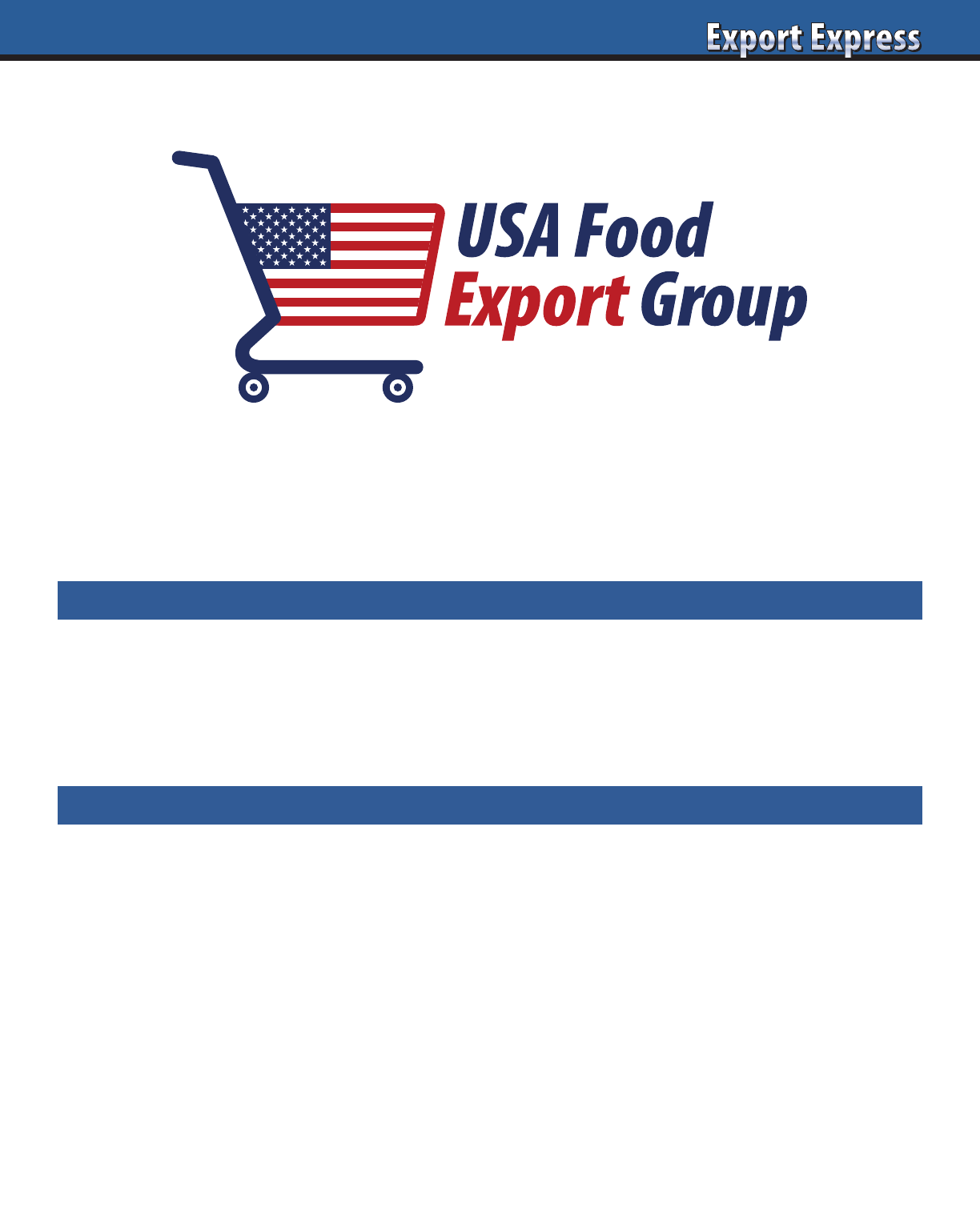
27
Introducing
America’s Favorite Brands
Executive Board
Export Solutions Smucker’s Tabasco
Greg Seminara, CEO Danny Berrios, President Megan Lopez, Vice-President
General Mills Sun-Maid
Eric Saint-Marc Carsten Tietjen
Advisory Board
Bazooka Candy Blue Diamond Bob’s Red Mill
Santiago Ricaurte Dale Tipple Jan Chernus
Bush Beans Campbells Church & Dwight
Dave Bauman Julio Gomez Arun Hiranandani
Ferarra Candy Heartland Idahoan
Daniel Michelena Tom Theobald Ryan Ellis
Johnsonville Sausage Kao USA Keurig Dr. Pepper
Cory Bouck Julie Toole Billy Menendez
Mizkan Reynolds Welch’s
Noel David Chris Corey Marc Rosen
19 Companies | 200+ Top Brands | $80 Billion Combined
View our activities for export managers – www.usafoodexport.com
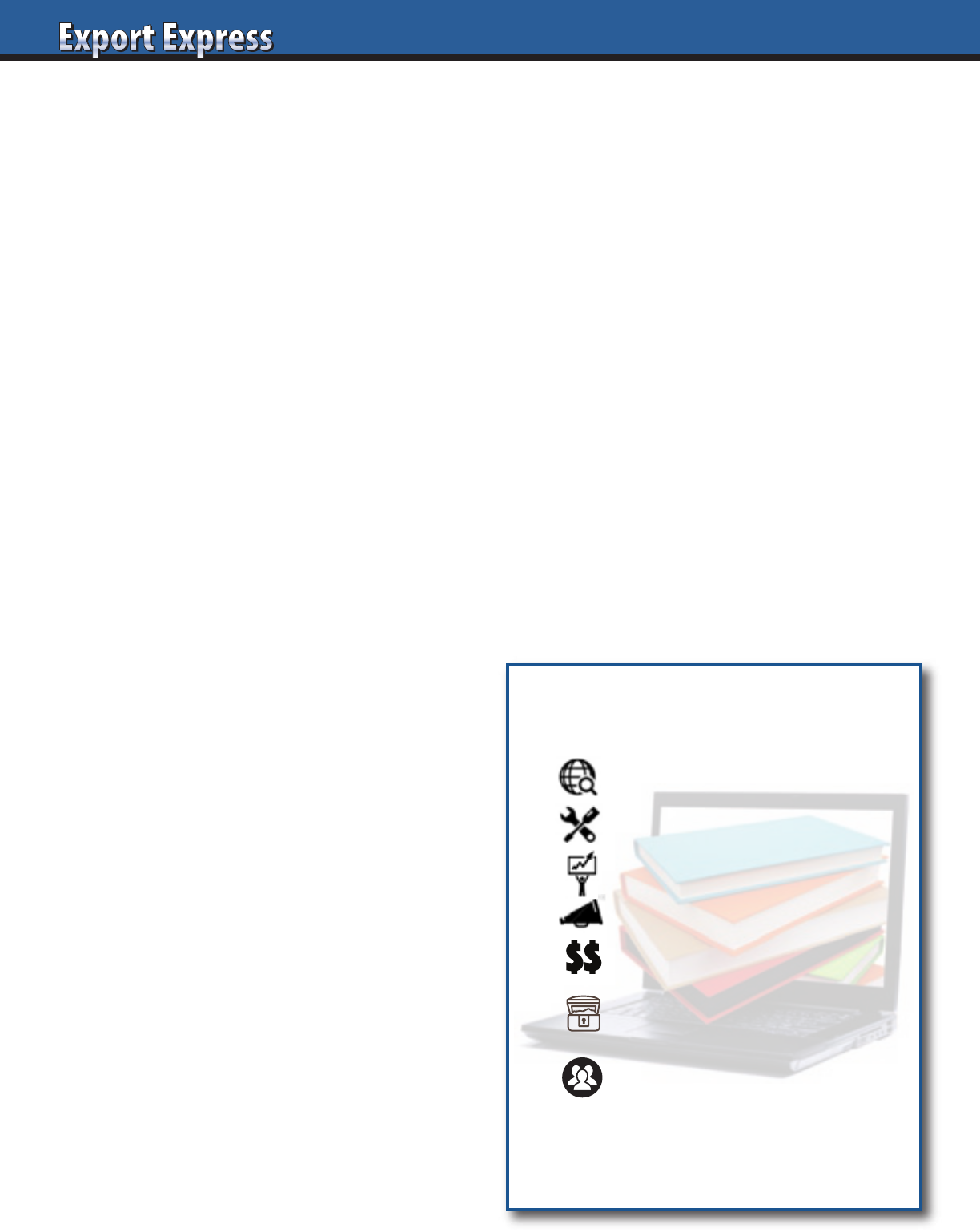
2828
Slotting allowances, listing fees or as the Irish say “Hello”
money are all real estate rental fees charged in advance by
retailers for access to their limited shelf space. Many retailers
assign their buyers “budgets” for this type of incremental fee
income. Store owners seek to obtain maximum productivity
from each shelf facing and fixed entry fees are a tactic to gain
immediate income from new products without an established
sales history. At the end of the day, it’s a cost of doing
business. Our objective is to allocate as little money
as possible to listing fees to redirect our investments
to consumer awareness and trial generating activities.
Recapped below are Export Solutions’ Ten Tips on
minimizing listing fee payments.
1. Exclusivity
Some large retailers will waive listing fees in order to achieve
first in the market status with an exclusivity arrangement.
Normally, this extends for three to six months. Beware, you
may upset other customers who become “locked out” during
the exclusivity period.
2. Pay Fees Over One Year
This approach reduces your initial outlay and also increases
the likelihood that the retailer will keep your product on
the shelf for at least one year. This may also allow you to
structure the payment as a percent of case cost versus a
“lump sum” payment.
3. Free Goods
Our net cost of “Free Goods” may range from 30-50% of a
product’s retail price to the consumer. The retailer recoups
his listing fee when the product is sold. Some retailers are
hesitant to accept this option, as a slow moving brand may
force him to wait to receive his money.
4. Approach “Non-Slotting” Fee Retailers First
Every country includes retailers and channels that do
not demand slotting fees. Create a success story with these
customers first. Your track record may validate the larger
investment in paying the fees at a bigger account or success
may help you negotiate more favorable terms.
5. Create “All Inclusive” Annual Plan
Ultimately, the retailer has many “profit centers” to reach their
internal financial targets. Customers respect a solid, year one
plan, with investments in their other programs like advertising,
sampling, shelf rental and display. You may secure your product
listings as part of your annual agreement.
6. Negotiate Reductions – Multiple Items
My experience is that many retailers have published standard
prices for listing fees. However, net payment often depends
on your distributor’s clout. Big distributors, representing
multinational’s and a wide variety of brands know the difference
between what is requested and what is really paid on high profile
brand launches where the retailer needs the new brand to be
competitive. The most frequent “discount” is receiving a reduced
fee for multiple items: example, paying a full listing fee on first
two items and receiving authorization for two extra items as part
of a group listing.
7. Retailer Entertainment
Most countries still permit buyers to socialize with suppliers.
The cost of a few tickets to a high profile sporting event is far less
than most listing fees. A VIP plane trip to view your factory or
your category in a “resort” country is another way to gain access
to the shelves without writing a big check.
8. Higher Everyday Margin
Total category margin is a key assessment metric for most buyers.
Some may consider a lower listing fee, if your brand delivers a
margin higher than the category average.
9. Distributor Contribution
Some “hungry” distributors may cover or co-fund listing fees.
There are options to “case rate” fixed fees into the distributor
margin calculation. Ultimately, distributors benefit from increased
sales and margin contribution from a new product listing.
However, many are reluctant due to short term contracts. Most
maintain policies related to brand owners retaining 100 percent
responsibility for listing fees and consumer marketing activities.
10. Beg! Claim Poverty
Buyers are human and realists too. They may “bend” in their
demands if they like your brand and know that you represent
a small company. Long term distributors can request the
occasional “favor” from a friendly buyer. Most retailers have
programs to provide “low cost” chances to entrepreneurial
new or local suppliers.
Ten Tips: How to Minimize Listing Fee Payments
Create Your Own
Export Library
All Guides available free at
www.exportsolutions.com
in the Export Tips section.
Distributor Search Guide
Export Handbook
Selling to USA Handbook
Distributor Management Guide
Finance & Logistics
Export Treasure Chest
My Favorite Templates & Forms
People Power
Strong Teams Build Great Brands
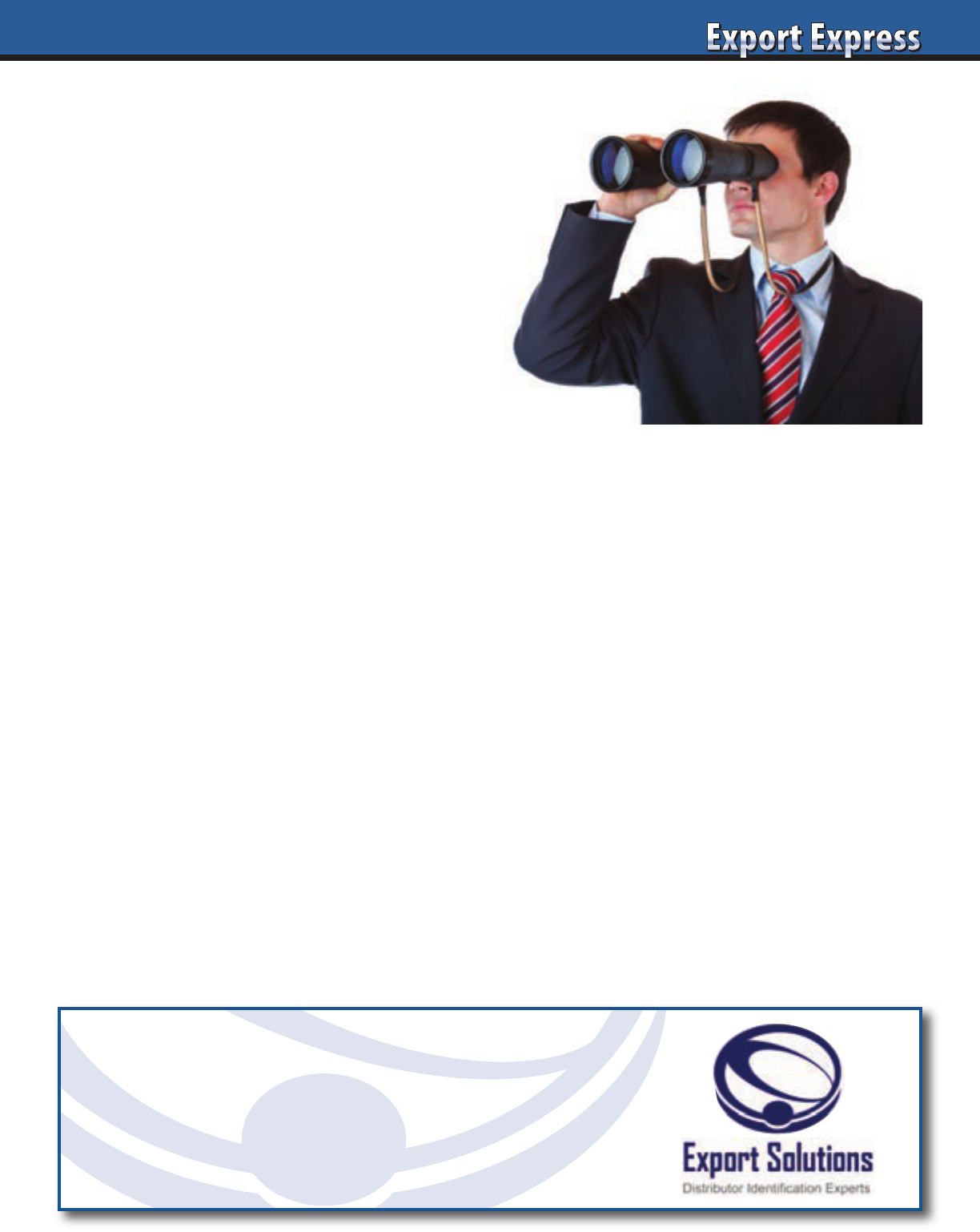
29
1. Case
Manufacturer supplies a business case
confirming brand “aspirations” for the
country: Key items in portfolio, estimated
base pricing, volume/market share
expectations, and investment model.
2. Category Review
Distributor supplies a local review
of category competitors, pricing,
and merchandising practices.
3. Capabilities
Distributor shares detailed organizational
capability and customer coverage. Could
include references from existing suppliers
represented. An important step when
there are two or more candidates
under consideration.
4. Commitment and Costs
What is the Year 1 Plan and Forecast?
Targeted listings, marketing activities,
launch budget and volume estimate
associated with the spending plan.
5. Calculation – Value Chain
Line by line, build up from port to retail
store shelf. Include currency assumptions.
6. Compliance
Highlight product registration and
label requirements. Typical timelines
for compliance?
7. Captain of Team
Who will be our day-to-day brand manager or
first point of contact? Which senior executive
will serve as our “Brand Champion?”
8. Contract
Options include formal contract, letter
of understanding, or handshake deal.
Begin this process early!
9. Consumer Marketing
What are planned activities to generate
consumer trial and repeat purchases?
Trade marketing, consumer marketing,
social media, etc.
10.Calendar /Close
Distributor supplies a detailed timeline
of all activities. When can we expect first
order and delivery to support launch?
Frequent checkpoint calls or meetings.
10 C’s – Cooperation Model
Looking for Good Distributors?
Export Solutions’ database covers
9,200 distributors in 96 countries.
www.exportsolutions.com
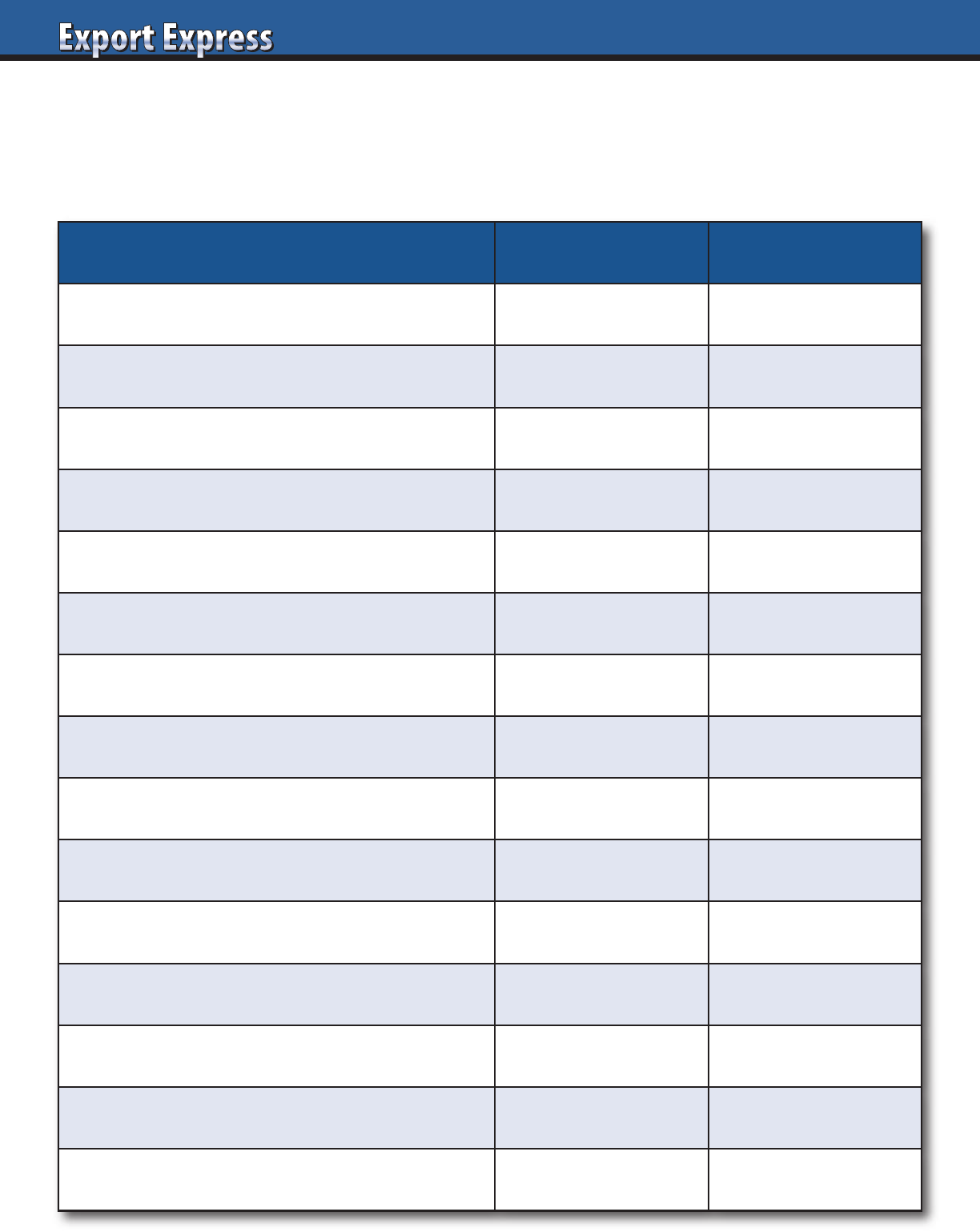
30
Year One Scorecard Example
Brand owners and distributors enter new relationships with great expectations.
Most partnerships succeed, but some under deliver leaving both parties disappointed.
Export Solutions Year One scorecard helps both parties align on KPI’s.
Objective Goal Results
Shipments to Distributor
Distributor Sales to Customers
Top 5 Customers
Region: Sales Split by Area
Channel: Sales Split by Channel
Market Share
Listings: Top 5 Customers
Retail Pricing
Shelf Positioning
Shelf Space
Sampling
Social Media
Displays
Manufacturer Investment
Brand Manager Performance
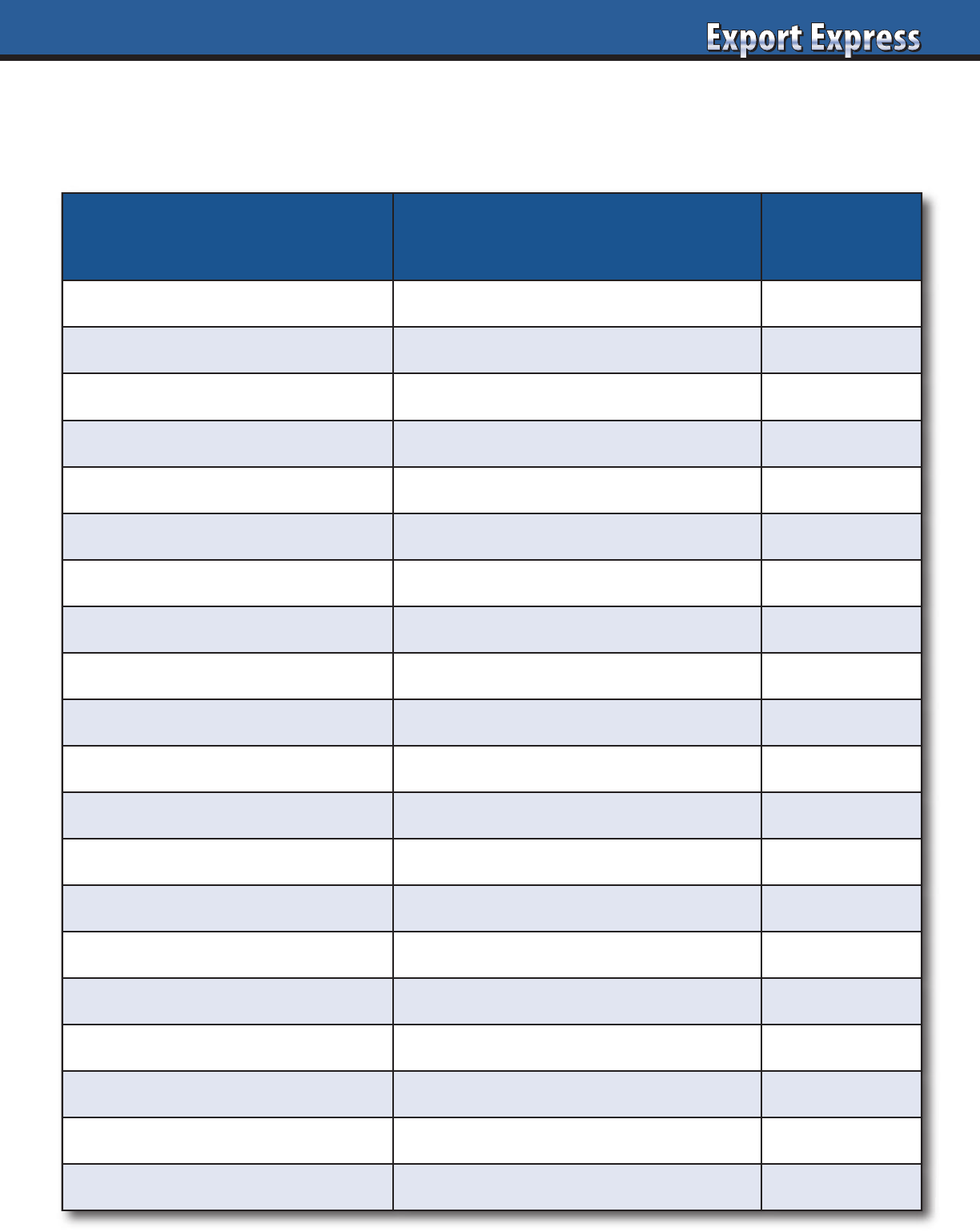
31
Preferred Supplier Scorecard
Distributors deliver their best results for their favorite principals. How do you rank?
Supplier Assessment Considerations
Rating:
(10 = Best)
Annual Sales Revenue • Percent of total distributor sales
Annual Profit Generated ($)
• Net sales times gross margin
Years of Service • New to 20 years or more
Compound Annual Growth Rate
• Flat to 10% or more
Supplier Investment Level • Zero to 25% of sales
Celebrates Success
• Awards, dinner, thank you notes
Shares Best Practices
• Serves as category expert
Logistics Service Level
• Target 98% on time, complete orders
Visits Retail Stores
• Never to full day every visit
Reimbursement of Billbacks • 2 weeks to 3 months
Senior Management Relationship • None to long term partners
Export Manager Experience • New hire to 10 years or more
Response Time • Same day to one month
Supports Distributor’s Ideas
• Invests in local ideas
Good on Customer Calls
• Avoids calls to customer favorite
Admin Requirements • Orders only to multiple reports
Supplier Visit Frequency • Never to weekly
Relationship: Entire Team • Finance, logistics, administration
Respects Fair Profit for Distributor • Healthy distributor is profitable
Achieves Joint Business Targets • Creates culture of success
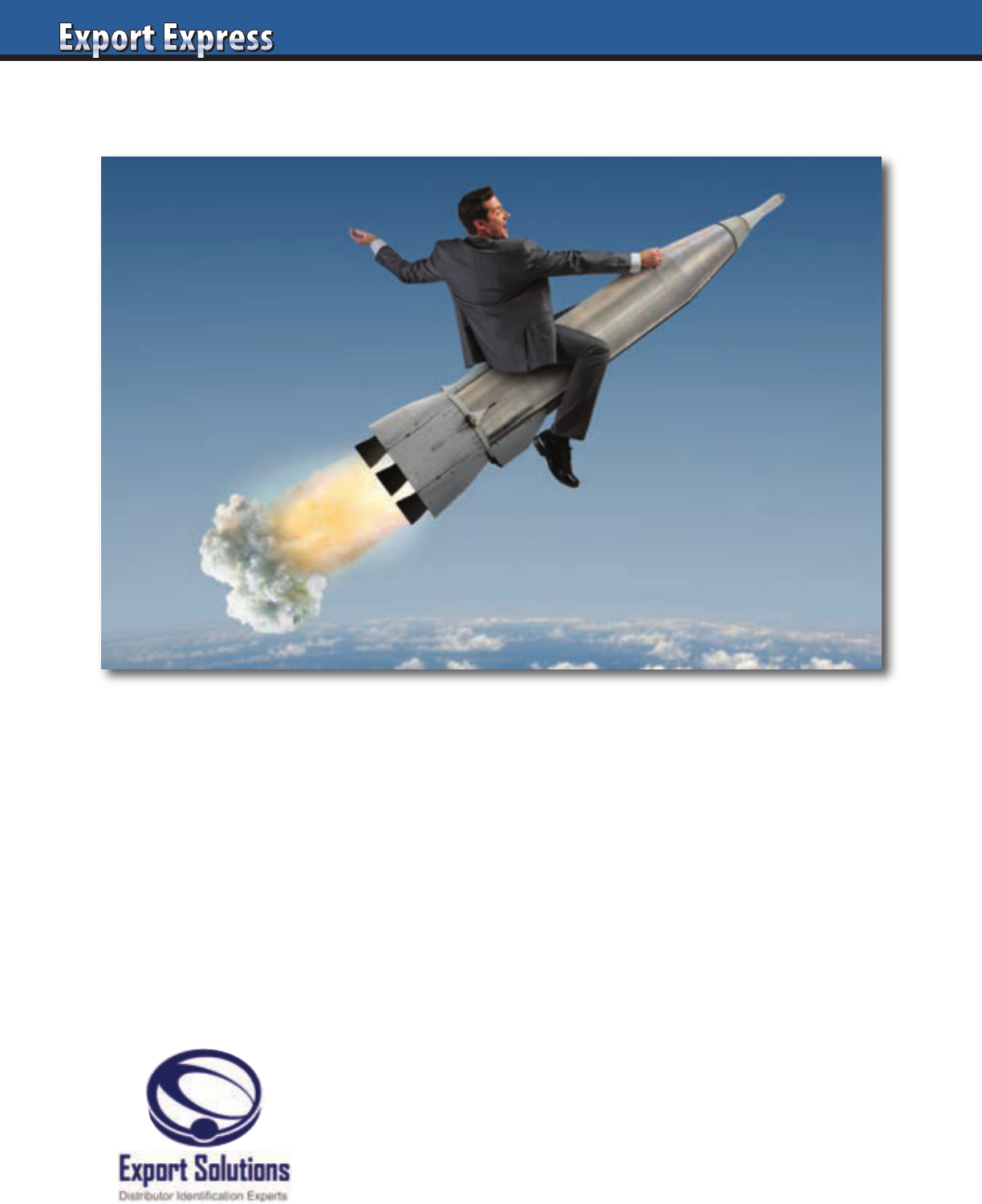
Export Accelerator
Contact Us for Distributor Search Help in 96 Countries
Greg Seminara • greg@exportsolutions.com
“Spend time Selling to Distributors versus
Searching for Distributors”
32
Why have Barilla, Pringles, Nature Valley, Starbucks, Duracell,
Nestlé, Tabasco, Pepperidge Farm, and other leaders used
Export Solutions as a distributor search consultant?
• Powerful distributor network: owner of industry database
9,200 distributors – 96 countries
• Professional 10 step due diligence process
• Results! We make Export Managers’ lives easier!
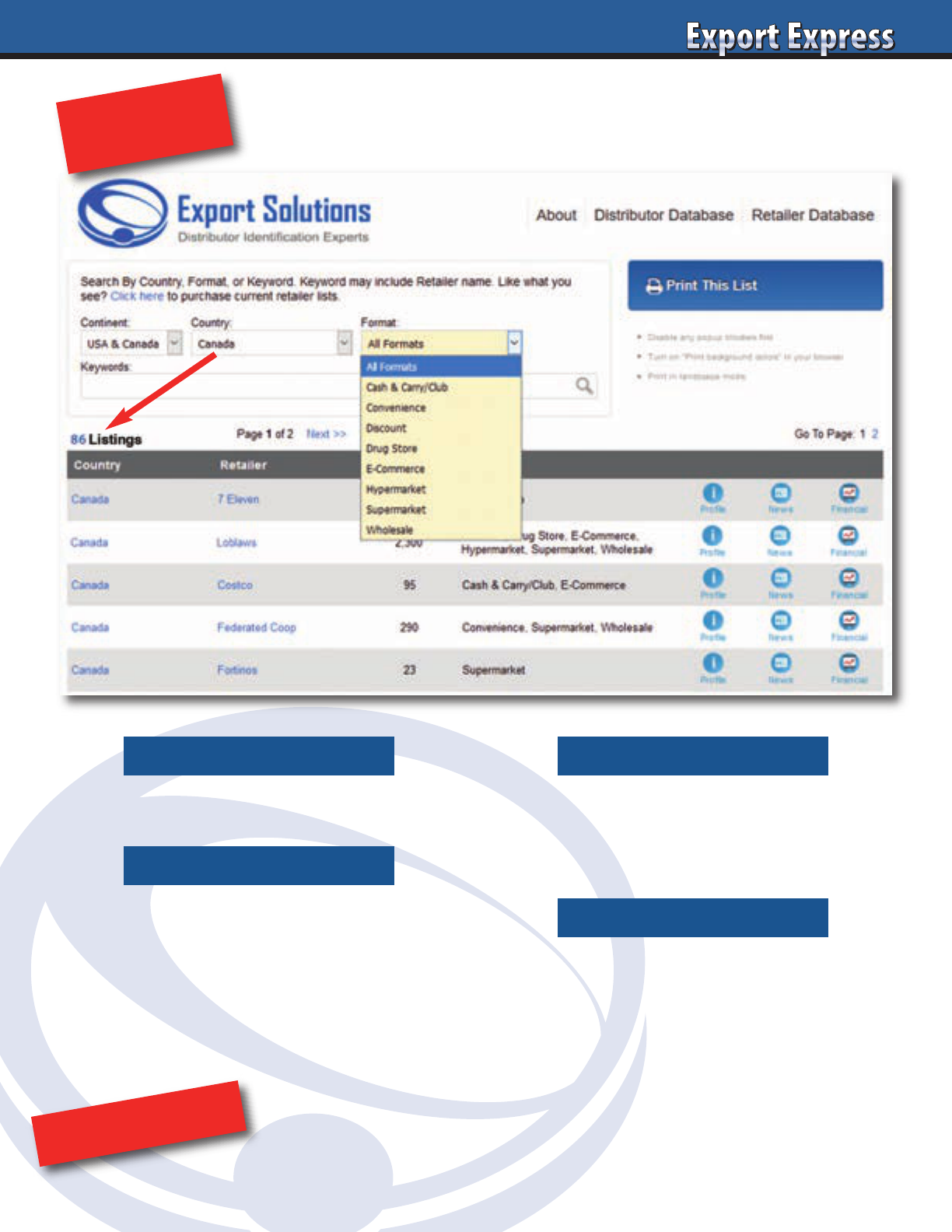
Coverage: 96 countries and 2,700 retailers
Supermarket
Convenience
Drug Store
Natural Food
Club, Cash & Carry
Supplying profiles, store counts, formats,
news and info for Top 100 international
retailers plus all overseas branches
Example 1: Who are supermarket
retailers in Canada?
Example 2: How many stores does Loblaws
operate by banner, in Canada?
NEW!
ORDER NOW!
33
Search by Retailer NameSearch by Country
Combo Search
www.exportsolutions.com
Search By Format
Retailer Search Made Simple
Canada Example
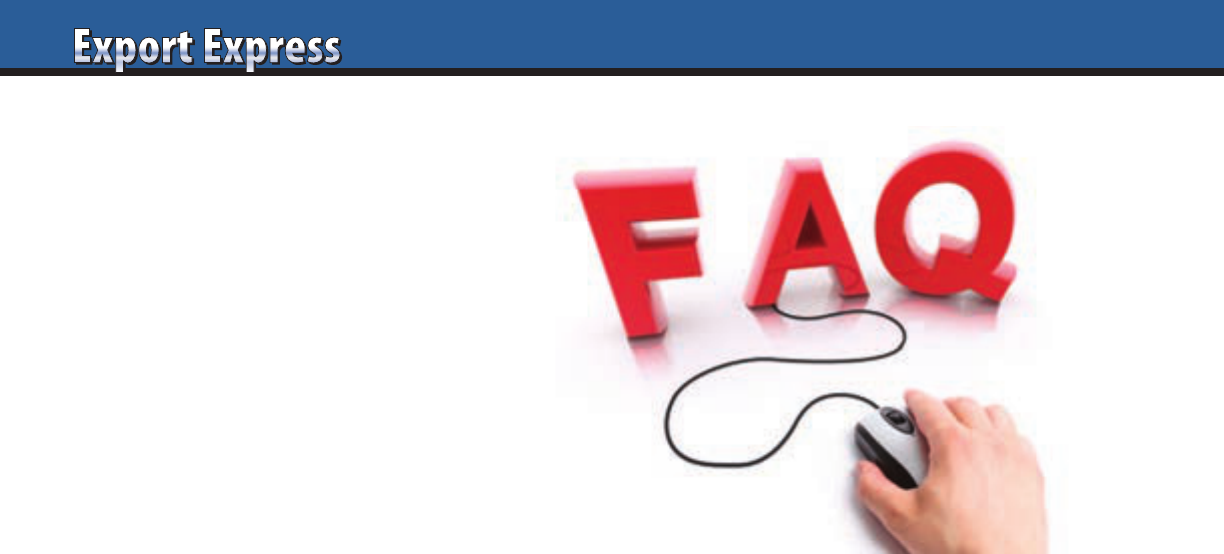
34
Why did you create the retailer database?
Export managers dedicate a lot of time
to researching countries, retailers and
preparing business plans. A standard
KPI measure is tracking product listings
for key customers. I believe that our
industry could benefit from a global
retailer database to instantly locate
retailers and their store counts in
96 countries. The retailer database
is a logical extension of our leading
distributor database which has helped
more than 3,000 companies build export
sales during the last 10 years.
What is your geographic coverage?
96 of top 100 GDP countries worldwide.
This includes most Asian, Middle Eastern,
and European countries. Our database
covers every country in the Americas.
In Africa, we cover South Africa.
What is your format coverage?
Excellent coverage of chain supermarkets,
hypermarkets, clubs, cash and carry,
and convenience formats. Solid initial
coverage of drug stores, natural food
stores, and e-commerce channels.
Our database does not cover
DIY/hardware, toy, office, liquor,
or sporting goods channels.
Retailer database: featured info
Profile – Retailers profile and link to their
internet home page.
Formats – Retailer’s stores segmented
by format and banner.
We track supermarkets, hypermarkets,
cash and carry, convenience stores,
discounters, drug stores, natural food
stores, and e-commerce retailers.
News – Latest retailers’ news. In some
cases (Asia), we substitute a link to the
retailer’s latest promotional flyer.
Financial – Many leading retailers are
publicly traded. A link is provided to
their latest financial results. We do not
offer estimated financial information for
privately held or family owned retailers.
How is your coverage of global retailers?
We offer total coverage for top 100 global
retailers. This includes all of their
branches and banners. Searchable!
Use filters to research Walmart, Costco,
Carrefour, Tesco, Metro, Casino presence
by country. Database covers retailer’s
total store outlets as well as a breakout
by banner and format.
What can I use the retailer database info for?
• Obtain an instant snapshot of an
average of 24 retailers per country
for 96 countries.
• Track presence of global retailers like
Walmart, Carrefour, and Metro AG.
• Create country specific listing maps
where distributors measure brand
authorization by retailer.
• Conduct home office based
international category reviews
and price checks from retailers’
e-commerce sites (not all retailers).
• Prepare annual reviews and reports
with up-to-date information on leading
retailers and channels.
Searchable
The database offers filters allowing you to
search by country, format, or retailer name.
You can also use a combination of filters for
your research.
Can I get a free sample of the retailer database?
Sure! Check www.exportsolutions.com
for a complete profile of United
Kingdom retailers.
Do you provide retailer’s annual sales
or market share information?
Accurate annual sales information is
available through the financial link for
publicly traded companies. We do not
provide estimated financial information
for privately held and family owned
retailers. Channel blurring occurs between
supermarket, convenience, e-commerce,
and even natural food operators. We do not
provide market share due to difficulty to
accurately isolate and define channel
market share information, particularly
with so many privately held retailers.
How accurate is the retailer data?
Export Solutions’ retailer database is
updated weekly, so information is highly
accurate. Retailer names, web sites, and
formats rarely change. This makes the
database 99% accurate at the company
level. New stores open every day,
resulting in store counts that may be
95% accurate. We intend to update store
counts on a regular basis.
How much does retailer database access cost?
An annual subscription to the retailer
database is $975. This supplies one year,
unlimited access to more than 2,700
retailers in 96 countries. Special offers
available for our distributor database
customers. Note: special pricing for
government trade organizations.
How do I access the retailer database?
Visit www.exportsolutions.com and click
the retailer database page. You can place
a subscription or individual continent
(i.e., Europe) into a shopping cart.
Register and check out via credit card.
The process takes two minutes and we
automatically send you an invoice.
About Export Solutions
Export Solutions was founded in 2004
and is based in Atlanta, Georgia in the
USA. Export Solutions serves as a leading
provider of business intelligence to the
food and consumer goods industries.
Our distributor database covers 9,200
distributors in 96 countries and has
been used by more than 3,000 clients.
Our Export Express newsletter has a
circulation of 9,800 and is viewed as an
important source of insights, strategies,
and templates for international
development. www.exportsolutions.com.
FAQ’s – Retailer Database
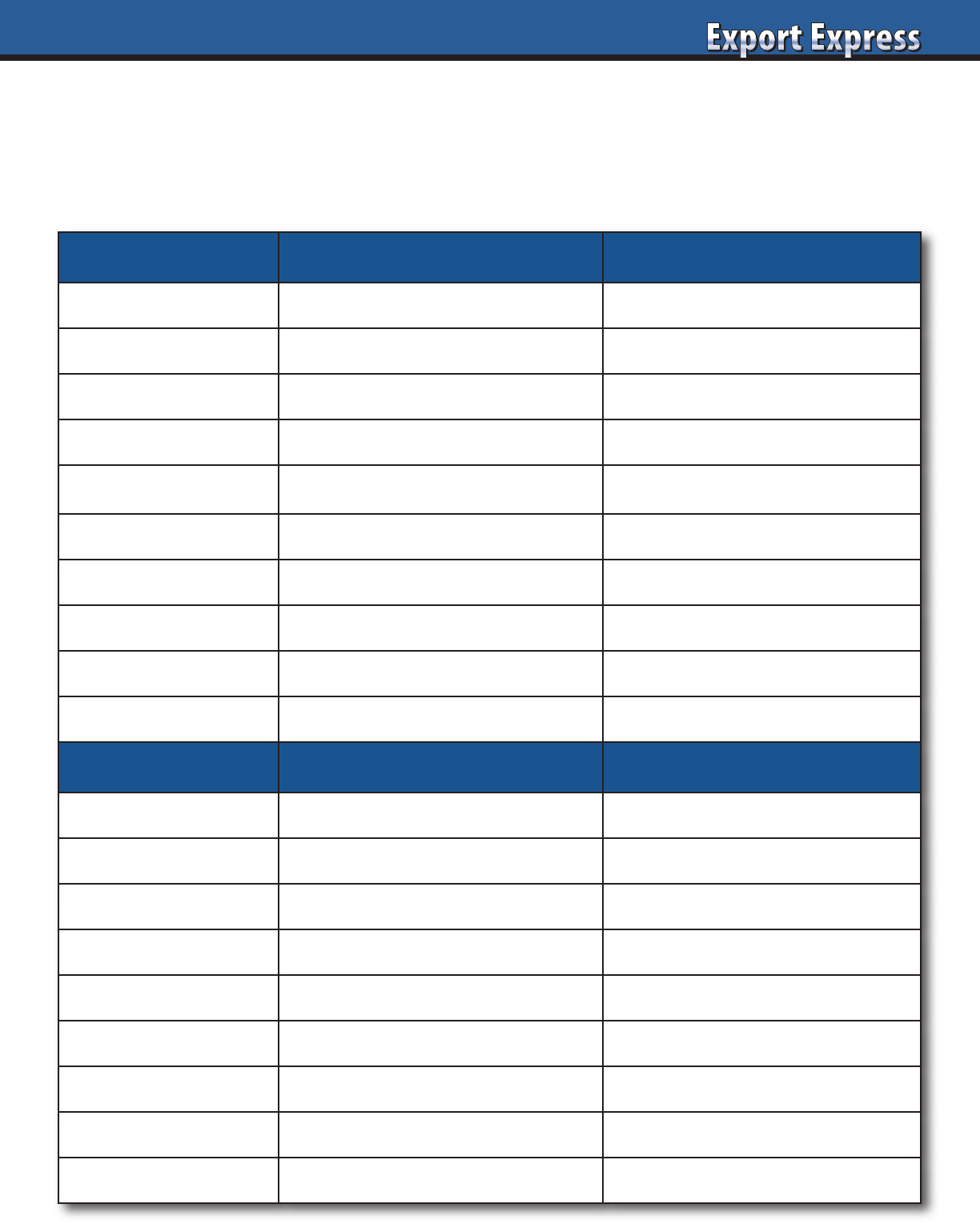
35
Tactical Exports vs. International Brand Building
What are your realistic aspirations for a country? There is a big difference between tactical exports
and strategic brand building. Companies can win in smaller countries with an “export only” strategy.
Brand building requires a financial commitment. Either option works. Companies need to align market
ambitions with their investment plans.
Export Brand Building
Market Research None Local consumption habits
Product portfolio Best sellers from home market Tailored to country/region
Packaging Standard packs stickered Native language
Factory Corporate headquarter based Offshore
Marketing Investment
Trade marketing only (10 percent of sales?) TV, 360 marketing 20-30 percent of sales
Retail Pricing Premium to super premium Equal to competitors
Route to Market Distributor Direct team or distributor
Oversight Periodic visits Dedicated country manager
Market Share Ambitions Niche Player
Complexity Low High
Export Countries Brand Building Countries
Caribbean USA
Malta, Cyprus, Portugal Western Europe
Middle East Mexico
Central America China
Hong Kong/Singapore Japan
Taiwan India
Nordics Russia
Baltics Turkey
Chile, Peru, Ecuador Brasil
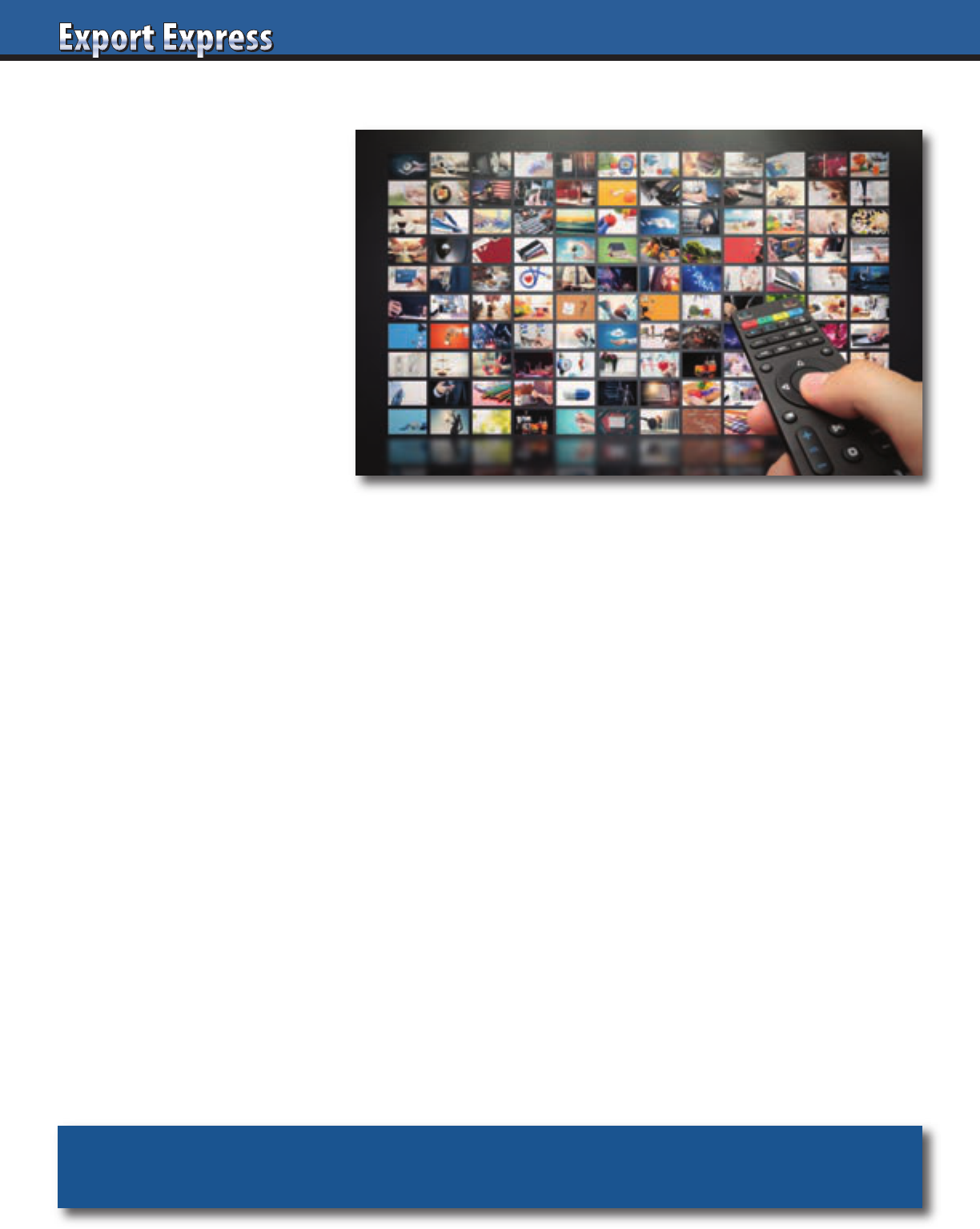
If you launched a premium new brand,
would your first customer be Walmart
or a chain of upscale supermarkets?
Export managers frequently target the
largest overseas retailers, forgetting the
high cost and activation requirements
to develop a meaningful level of repeat
sales. A viable route to market exists in
every country for those with a rational
alignment of ambition and investment.
A key to success is an approach based
upon channel specific, retailer profiling.
Retailer Profiling
Every country contains similar
channel dynamics: value supermarkets,
mass grocers, upscale supermarkets,
e-commerce, hypermarkets, discounters,
convenience, gourmet, ethnic, natural
foods, drug stores, and specialty
retailers. Foodservice is dominated
by wholesale distributors and cash and
carry outlets. Bigger countries feature
well evolved channels with clear lines.
In smaller countries, channel blurring
exists, with conventional retailers
striving to serve as a “one stop”
shopping destinations.
A worthwhile exercise is to conduct an
analysis to segment your overseas sales
by channel and supermarket type. This
learning could supply a best practice
road map when entering new countries
or implementing a business
improvement initiative.
On-Ramp
Prime prospects normally lead us to
upscale supermarkets, ethnic stores,
e-commerce, and gourmet outlets.
These channels tend to cater to consumers
that are more adventurous and affluent.
Their shoppers are less price sensitive
and search for brands not stocked by
mass supermarkets. Frequently, buyers
at these retailers study category dynamics
and seek to be first in the country to
support an innovation from overseas.
Listing fees continue to soar and
spread across emerging markets.
Many “on-ramp” retailers appear
more concerned with product attributes
than up front payments.
Upscale Supermarkets
High end stores serve as showrooms
for international brands. Other local
retailers look to them for inspiration and
execution. These special supermarkets
create a pleasant shopping environment
with well established programs for
product tastings and consumer
education. Your first stop in any country.
E-Commerce
In the past, homesick expatriates would
lug big suitcases from home or scan
their adopted city for treats from home.
Now, it’s possible to log in to Amazon or
other e-commerce players and find your
favorite brands from home in a few
clicks. For example, I just searched
Amazon UK’s grocery store for USA
food and discovered more than 1,000
results from Jif peanut butter to Jiffy
corn muffin mix to the beloved Jelly
Belly. Other online specialists like
americanfood4U.de exist in Germany.
Ethnic Stores
These are stores dedicated to products
from overseas. In the USA you can find
stores dedicated to Italian, Mexican,
Asian, British, and German food
products. In Europe, there are fantastic
stores like Taste of America in Spain,
featuring all your favorites from back
home. These retailers are all about
“availability” and are anxious to partner
with leading brands from the home
country or successful innovations.
Priorities
Discounters, small shops, and value
oriented supermarket chains tend to be
tough channels to penetrate in the initial
stages of your export development.
Most brands plan to sell to all retailers.
This is a logical ambition in your home
country where your brand owns critical
mass. In new countries, expanding too
fast creates risks. Where does your target
consumer shop? Support these retailers
with marketing investments. Your brand
will “die” on the shelf without high
impact promotional activity.
From High Class to Mass
The head of India’s distributor association
described export development as the
journey from “high class to mass.” Look
for clues in the requirements to gain shelf
access at target retailers in your home
country. Remember that you are the
premium newcomer from overseas, not
the local incumbent. “Crawl, walk, run.”
Channel Your Exports
Need more information? Visit www.exportsolutions.com.
36
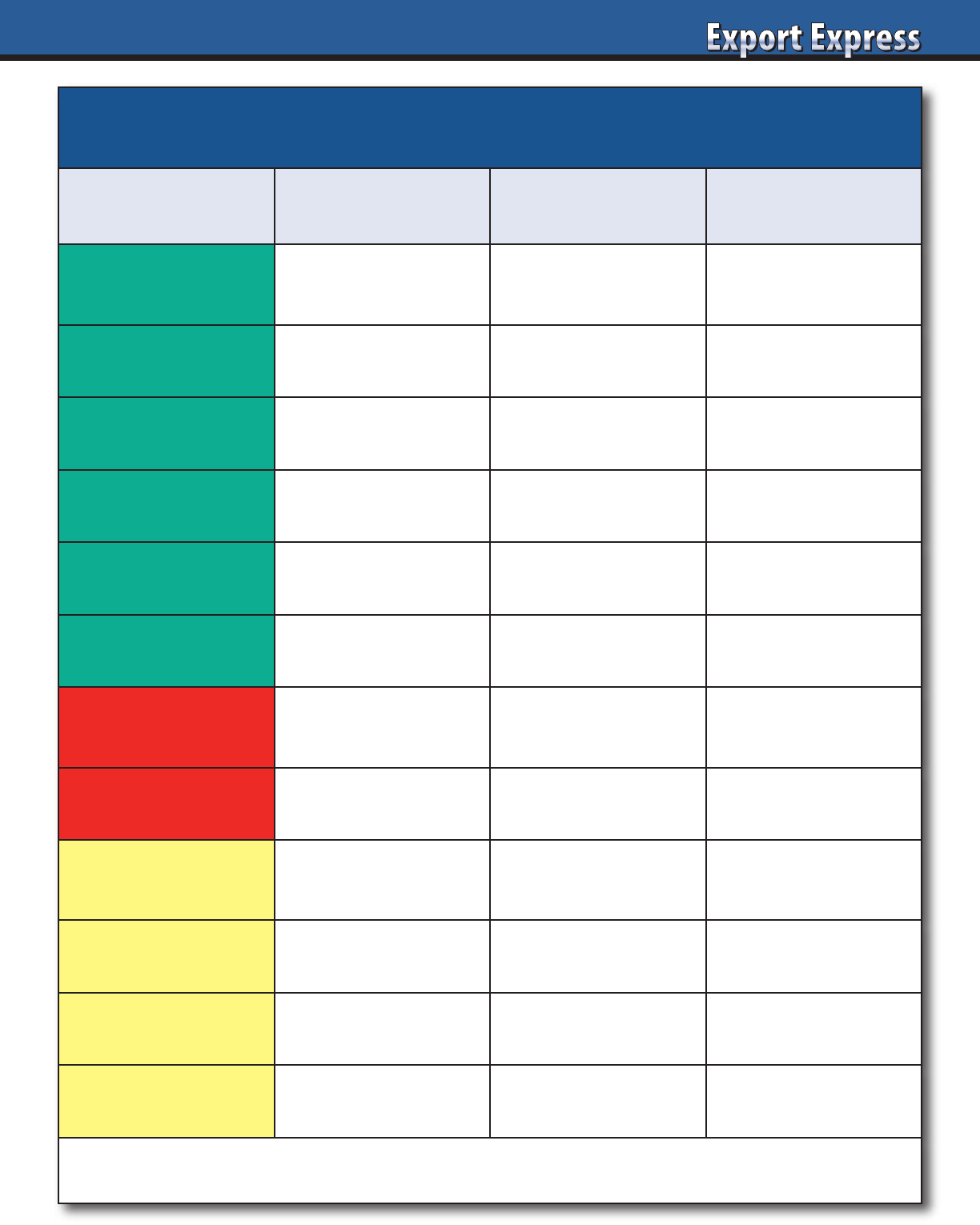
37
New Country: Retailer Segmentation & Prioritization
Priority* Channel USA Example New Country
Phase 1
Upscale
Supermarket
Harris Teeter
Phase 1 Ethnic 99 Ranch Market
Phase 1 E-Commerce Amazon
Phase 1 Gourmet Whole Foods
Phase 1 Specialty World Market
Phase 1 Natural Food* Natural Grocers
Phase 2
Mass
Supermarket
Kroger
Phase 2 Hypermarket Meijer
Phase 3
Value
Supermarket
Food Lion
Phase 3 Convenience* 7-Eleven
Phase 3 Foodservice Sysco
Phase 3 Discount Aldi
*May vary by supplier
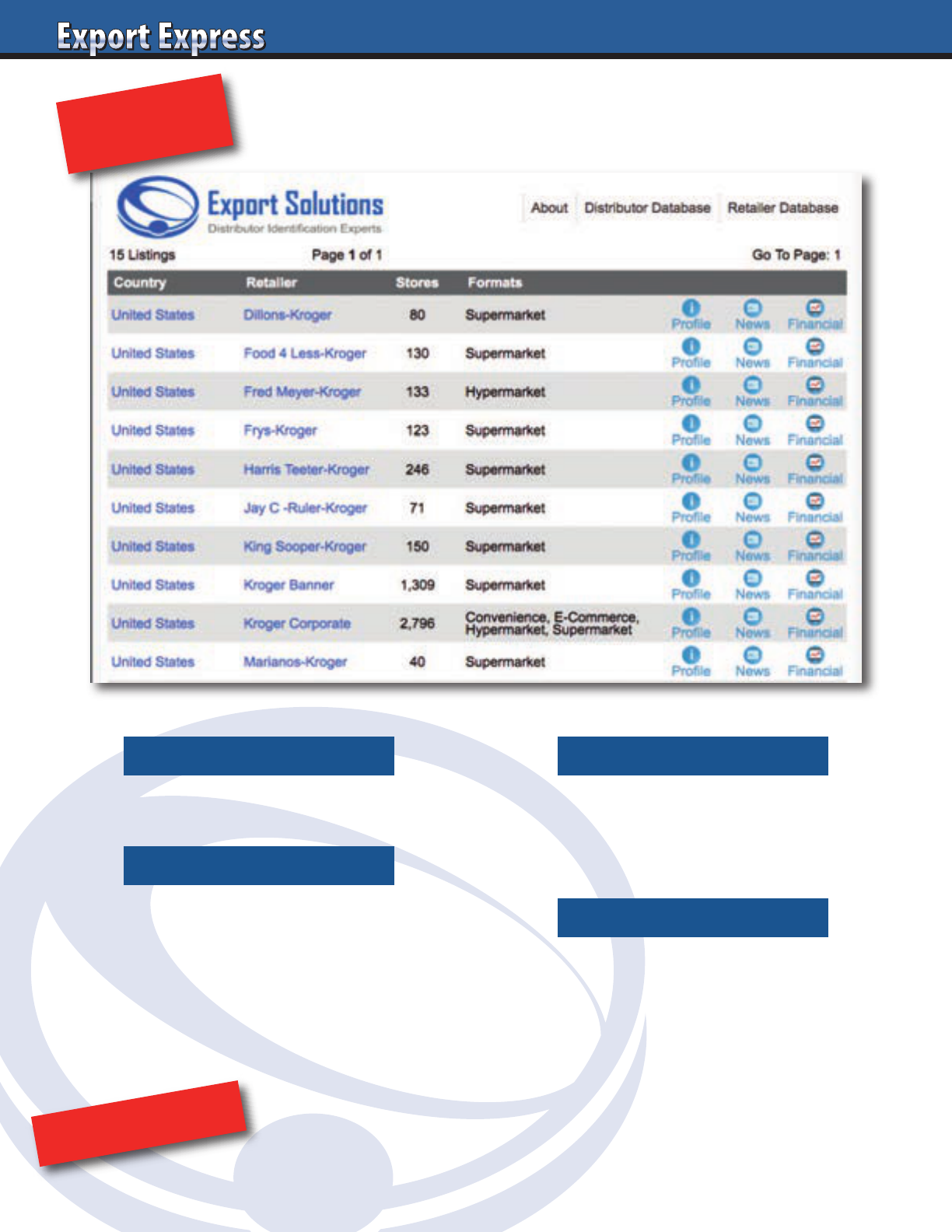
38
Coverage: 96 countries and 2,700 retailers
Supermarket
Convenience
Drug Store
Natural Food
Club, Cash & Carry
Supplying profiles, store counts, formats,
news and info for Top 100 international
retailers plus all overseas branches
Example 1: How many Harris Teeter stores
are there?
Example 2: How many stores does
Kroger
operate by banner, in the USA?
NEW!
ORDER NOW!
38
Search by Retailer NameSearch by Country
Combo Search
www.exportsolutions.com
Search By Format
Kroger USA
15 Banners – 2,726 Stores

39
Picking the right distributor is not an exact
science. I know that each of us experiences
moments of frustration when we question,
“why did we ever pick that distributor?”
Believe me, an equal number of examples
exist where a distributor may share the same
emotion about your company! Frequently,
a partnership is christened by a positive
distributor interview or enthusiastic meeting
at a trade show. Everyone is always in a
hurry to negotiate prices and a contract and
secure the first order. However, in many cases the decision to work together is cemented
without a formal business plan where expectations, road map, and KPI’s are established.
Unfortunately, one year later both parties may find themselves pointing fingers at each
other due to disappointing results.
I recently completed a distributor search project in the Middle East. We interviewed a
number of good candidates and identified two with high potential. Last month, I was
notified by the export manager that he selected one of the candidates. I supported his
decision, but questioned how the plan proposals for the two distributors compared?
The vague response confirmed no plans, just that he liked one distributor better.
This year, another project brought me to a country where a new distributor had been
appointed less than one year earlier. Initial results were severely below expectations.
The first question I asked the brand owner related to the reconciliation versus the
original one-year business plan. What happened? In this case, there was general
understanding about the direction of the partnership, but never alignment around
a one-page scorecard with KPIs and a logical road map.
Launching a new distributor relationship is like the birth of a child. A mother rarely
leaves the side of a baby, providing comfort, safety, and nutrition until the infant is
healthy and able to survive without constant oversight. The same philosophy must
apply to a distributor partnership. During the first few months, there must be frequent
communication, care and visibility from the supplier with the new “brand parents.”
This approach results in a healthy brand. Too many times, I see a new distributor
appointed without anyone from the manufacturer committed to visit the country
for the sales launch meeting or conduct a retail sales audit within the first sixty days.
Parents bring their newborn to the doctor frequently for checkups.
Listed below are Export Solutions’ tips on creating a clear annual plan for each country
and distributor partner.
1. Select new distributors based upon the quality of their year one plan:
targeted listings, volume forecast, and retail penetration.
What is their written commitment and timeline for achievement?
2. Current distributors should also have a confirmed one page plan.
Merchandising events, new listing targets, spending, and shipment targets.
Many brand owners treat distributors as good customers which is a smart approach.
The distributor is paying your invoice, not a retailer. Successful distributor partnerships
thrive when both parties are aligned and committed to a simple, one-page plan.
Looking for a sample format? I’ve prepared a one-page business plan template that
is freely available in the Export Tips section of my web site or simply email me.
What is your annual plan for each country?
www.exportsolutions.com
Greg Seminara
404-255-8387
“Spend Time Selling to Distributors versus Searching for Distributors”
What is the Plan?
Strategic Services
Contact Us for
Export Solutions
1. Identify Best in Class
Distributors: 96 Countries
2. Best Practices
Export Strategy
3. Distributor Management
Workshops
4. Export 101:
Let’s Get Started
5. New Market
Prioritization
and Launch Plan
6. Personal Distributor
Introductions:
96 Countries
7. Walmart International
8. Distributor Contracts,
Margins, and Fees
9. Meeting Speaker
10. International
Strategy Expert
Strategic Services
Contact Us for
Export Solutions
1. Identify Best in Class
Distributors: 96 Countries
2. Best Practices
Export Strategy
3. Distributor Management
Workshops
4. Export 101:
Let’s Get Started
5. New Market
Prioritization
and Launch Plan
6. Personal Distributor
Introductions:
96 Countries
7. Walmart International
8. Distributor Contracts,
Margins, and Fees
9. Meeting Speaker
10. International
Strategy Expert
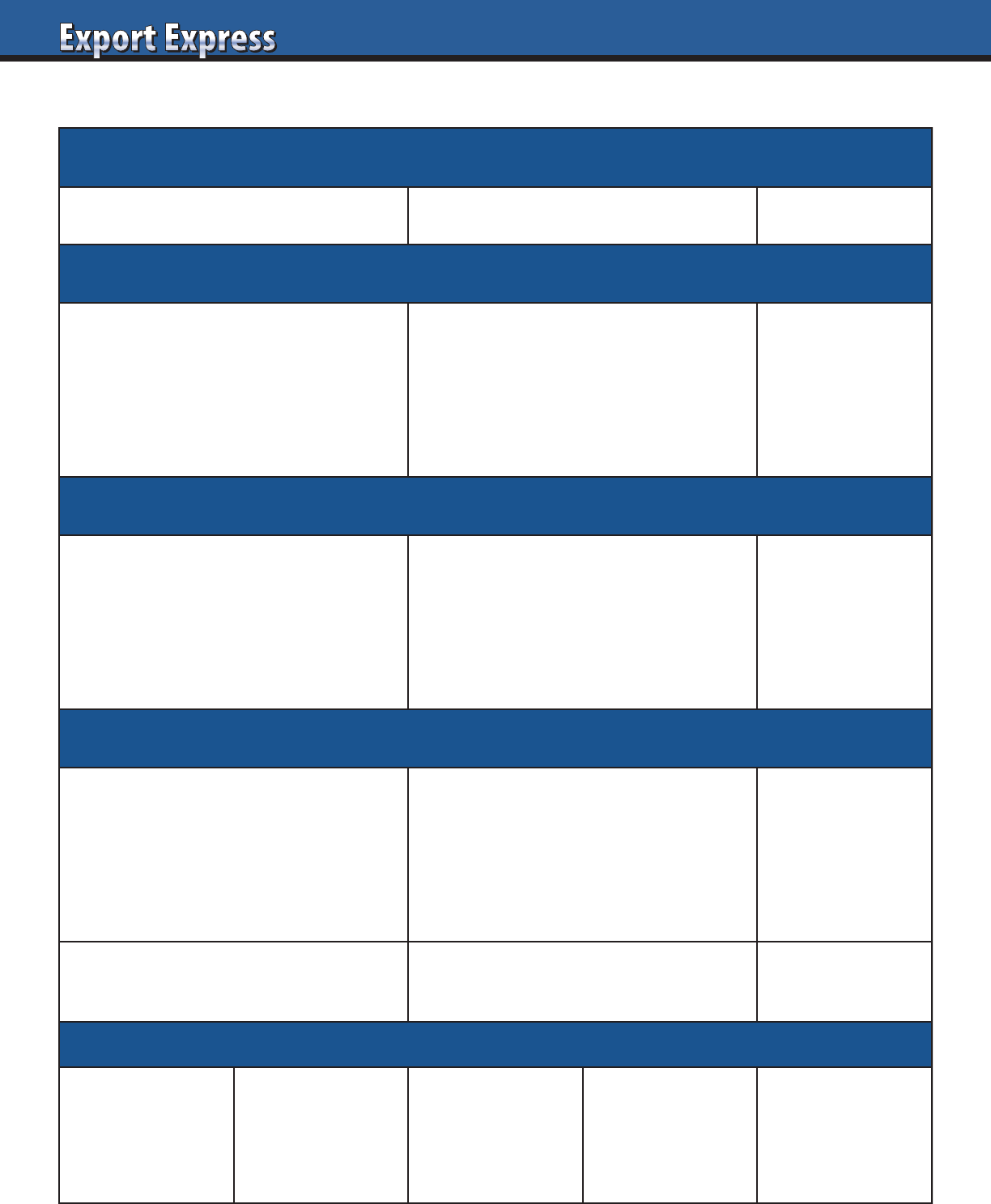
40
Launch Plan Proposal – Year One*
Brand Objective
Volume: _______________ Wtd. Distribution: _______________ Share: ________
Consumer Marketing Activities
Activity
1.
2.
3.
Rationale Cost
Trade Marketing Activities
Activity
1.
2
3.
Volume Cost
Listing Fees
Customer
1.
2.
3.
# SKUs, Space, Promotion Support Cost
Total Year One Volume Total Year One Cost Wtd. Distribution
Distribution Achieved with Above Spend Level
Customer
1.
2.
3.
Stores % Country # SKUs Volume (annual)
*Feel free to attach other pages to support your recommended launch plan.
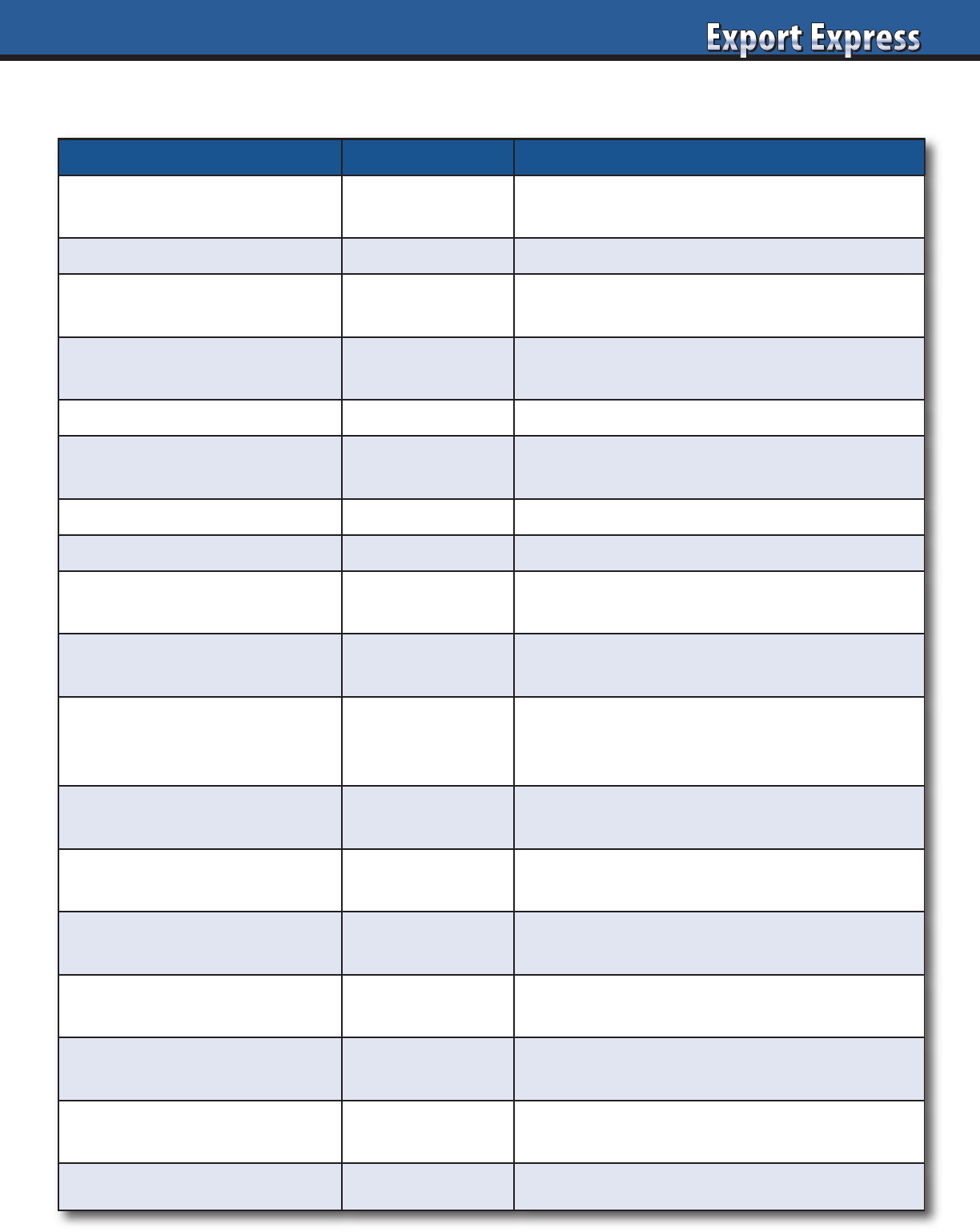
41
Price Calculation Worksheet
Item Amount Comments
List Price (factory or port)
Compare to your domestic list price?
Avoid diverting risk.
Exchange rate Watch bank rate vs. distributor rate.
Freight (sea, truck or rail)
Target full containers.
Consolidation is costly.
Duties
Apply correct Harmonized (HS) code.
Confirm Free Trade Agreements.
Customs clearance, insurance Money and time!
Inland freight: port to distributor
Translate actual costs to case rate.
Avoid flat percentage rates.
Landed Cost
Product Stickering Select countries.
Listing Fees
Flat fee. One time only.
Usually not in calculation.
Marketing fund accrual
Typically, 10-20% of list price.
Part of calculation or manufacturers price.
Distributor Margin
Normal range: 15-35%.
Depends on size, complexity of brand, services,
and “what trade spend is included.”
Other Distributor Fees
Should be part of distributor margin.
Avoid hidden profit centers.
Price to Retailer
Fair and transparent model.
Incentives for large customers, extra performance.
Retailer promotions,
incentives, rebates
10 – 20% depending on the country.
Other Retailer Fees
At times for merchandising or central distribution.
Should be allocated from distributor margin.
Retailer Margin
Global average: 28%
Range: 15% -45% based upon category, brand.
Sales Tax/VAT
Included in price in many countries.
USA sales tax is on top of shelf price.
Consumer shelf price Everyday prices and promotional prices.
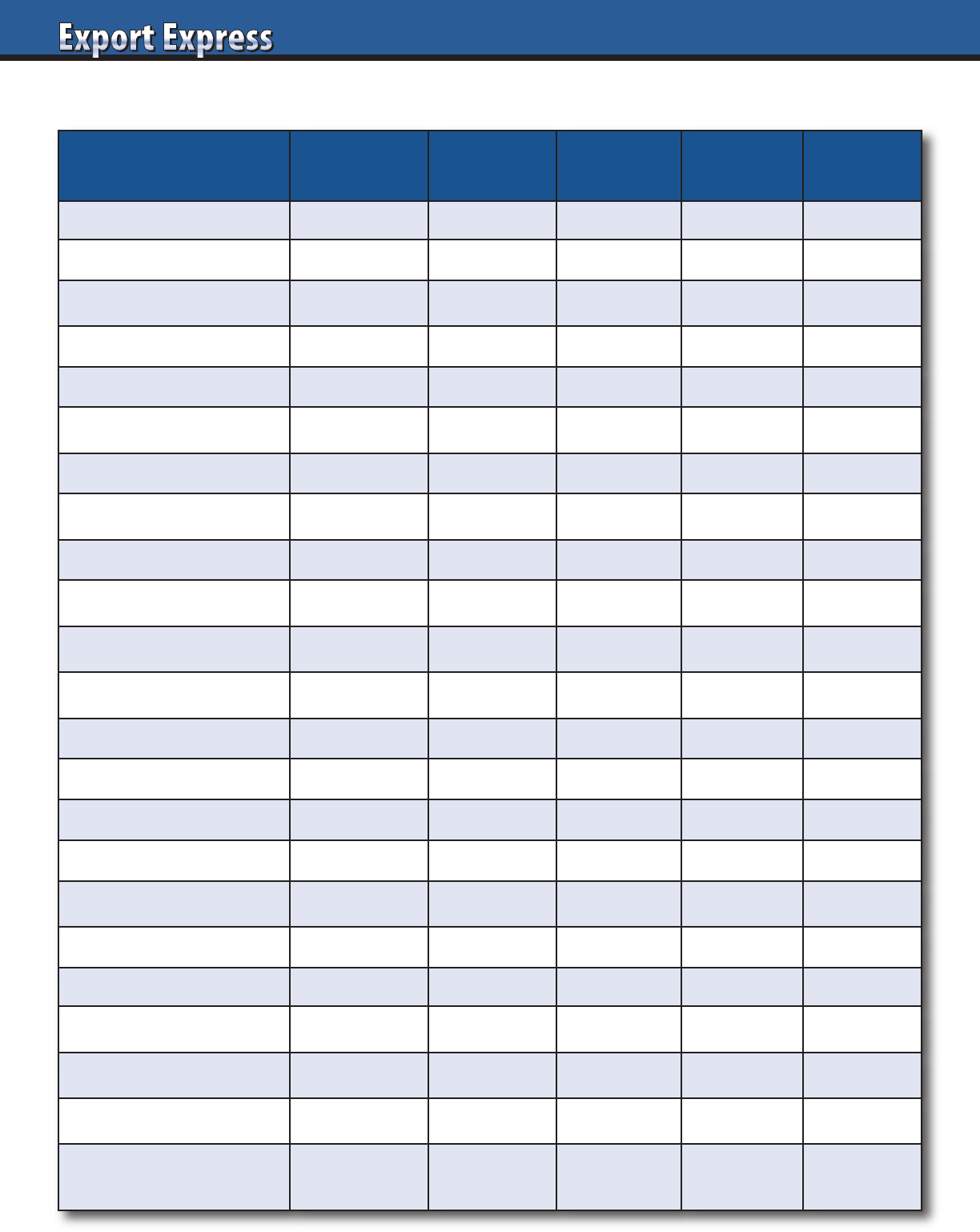
42
Channel Confectionery
Gourmet
Food
Food/Grocery Beverage Non Food
E-commerce x x x x x
Meal Kits x x x
Ethnic – “Homesick” x x x x
Gift Basket x x x
Natural Food x x x
Gourmet, Deli x x x
Liquor x x
Farmers Markets x x
Gift Channel x x
Toy, Party Stores x x
Movie Theaters x
Hardware, DIY, Office x x x
Duty Free x x x
Fundraising x x
Theme Parks, Stadiums x x
Airlines x
Butchers, Fishmongers x x x
Coffee Shops x x
Military x x x x x
Department Stores x x
Kitchen Supplies x x x
Dollar, Close Out x x x x x
Discount Clothing
(Marshalls, TJ/TK Maxx)
x x
New Channels: Prime Prospects, By Category
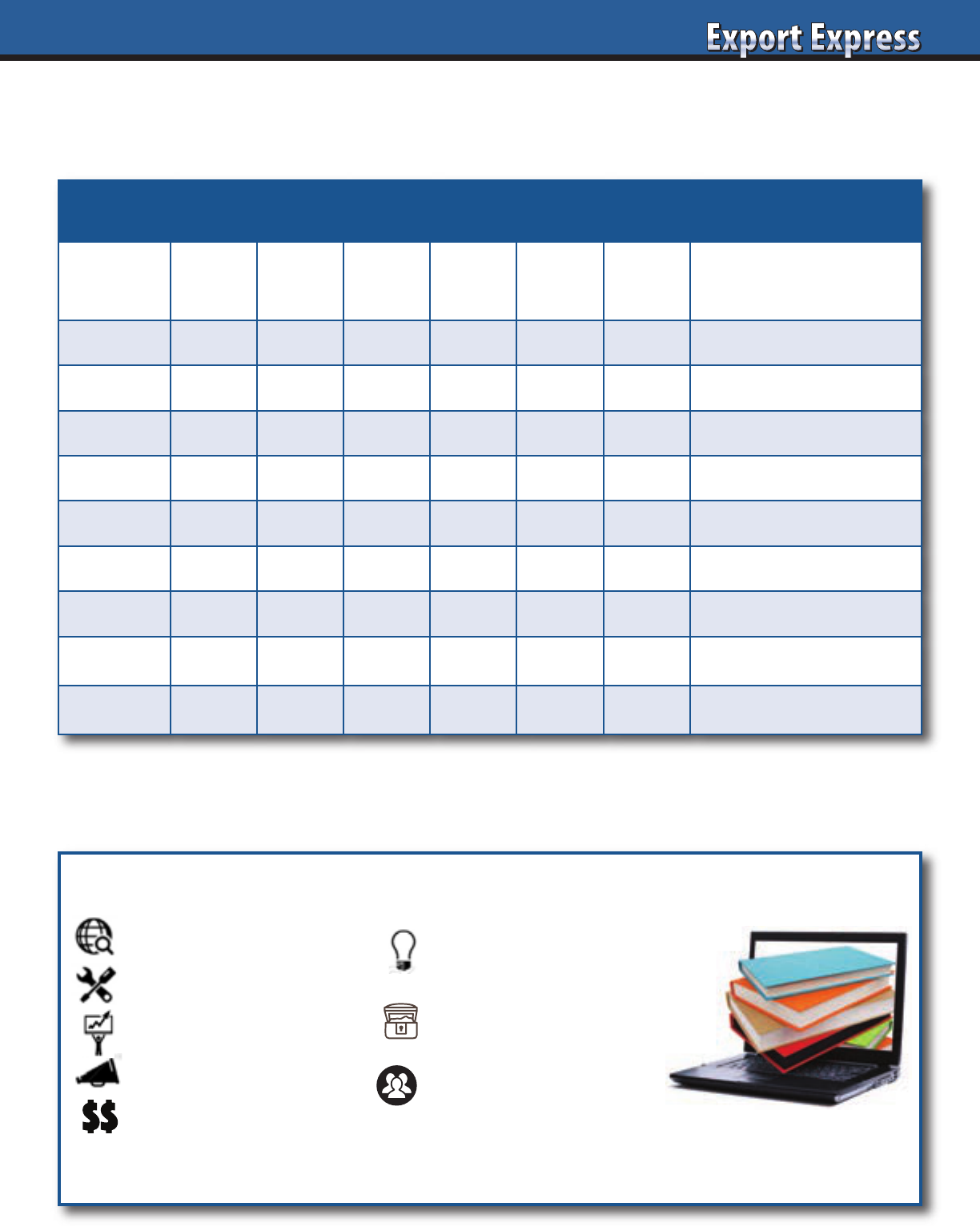
Country Listing Map – USA Example*
“Required Template for Every Country”
Retailer Stores SKU 1 SKU 2 SKU 3 SKU 4 SKU 5 Comments/Plans
Walmart SC 3,571 x x x
SKU 1, 2, 3 stocked at only
2,000 Supercenters
Costco 575 x Special SKU 5 for Costco
Kroger 2,726 x x x x Category Review March
Albertsons 2,278 x x x New shelf set
Publix 1,300 x x x BOGO Ad November
Ahold-FL 2,050 x x x x New SKU 4 listing
HEB - USA 355 x x x Category Review March
Meijer 260 x x x x Holiday Display Program
Shop Rite 361 x x x x New SKU 4 listing
Giant Eagle 216 x x x SKU 4 delisted
*Instructions: List top 10 customers for every country. List all your key SKUs (items).
“X” indicates item stocked at customer. Blank space represents a distribution void.
43
Create Your Own Export Library
Distributor Search Guide
Export Handbook
Selling to USA Handbook
Distributor Management Guide
Finance & Logistics
All guides available free at www.exportsolutions.com in the Export Tips section.
Idea Guide:
New World – New Business
Export Treasure Chest
My Favorite Templates & Forms
People Power
Strong Teams Build Great Brands
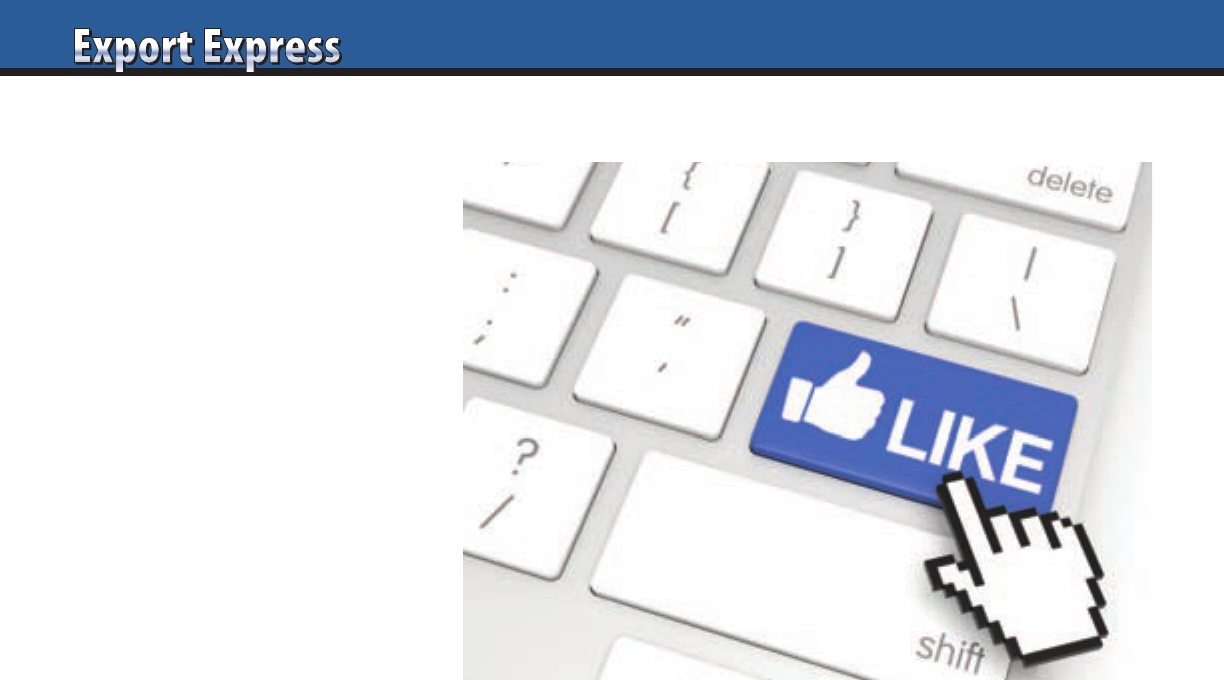
44
1. Respect For Their Right
to Make a Reasonable Profit
Brokers have profit targets just like
manufacturers do. Brokers measure
total supplier contribution, defined by
sales multiplied by gross margin. How
much value do you receive from your
brokers relative to your contribution
to their profits?
2. Investment in Brand Support
Brokers love companies that invest in
above the line activities such as television
advertising, radio, social media, print,
and sampling. Distributor volume is
proportional to your investment in brand
support activities. More marketing
dollars usually translates to greater
sales and profits for the distributor.
3. Awards
Most brokers proudly display their
Distributor of the Year awards in their
office lobby or executive conference
room. Recognition can be given for
distributor of the year, or achievement
of $1 million in sales, most improved
store conditions, or ten years of service.
4. Market Visits (But Not Too Often)
Periodic market visits allow you to share
ideas, monitor progress, and discuss
issues. These trips serve as motivational,
relationship building events, particularly
if you can spend time together “out of
the office.”
5. Endorsement of Local Marketing Events
Best in Class partners maintain the ability
to create unique local programs to build
your brand. Voting with your marketing
dollars stimulates the team to deliver and
continue to bring you their best ideas.
6. Trip Contests – Quota Makers Club
Many believe that achieving your annual
target is a job standard. This is true, but
watch brokers ship cases like crazy
when trying to qualify for a trip to a
resort location! Plus, the trip generates
incredible goodwill and all vow to meet
their objective to return “next year.”
7. Market Research
Brokers aspire to appear as category
experts. Access to syndicated data
from Nielsen plus local consumer
research allows them to distinguish
themselves from other vendors armed
with hollow words and broad claims
on a PowerPoint presentation.
8. Invitation to Your Corporate Headquarters
A trip to the USA or Europe is a dream
come true for distributor brand managers
in emerging markets. Treat them like a
VIP, and they will be loyal forever.
9. Lunch for the Support Staff
Order processing, customer service,
and other administrative people form
the hidden backbone of the brokers
team. Buy the group lunch and you
can be a hero for $100-$200. Guess
whose orders will be handled first at
the end of a quarter?
10. Letter of Thanks
Our industry depends on email
too much. How do you communicate
sincere thanks when someone receives
200 emails a day? Send a personal letter
via the post office recognizing a
successful new product launch, creative
promotion,or above and beyond effort.
Extra points provided for a handwritten
note! These letters are treasured forever.
Ten Things That Brokers Like
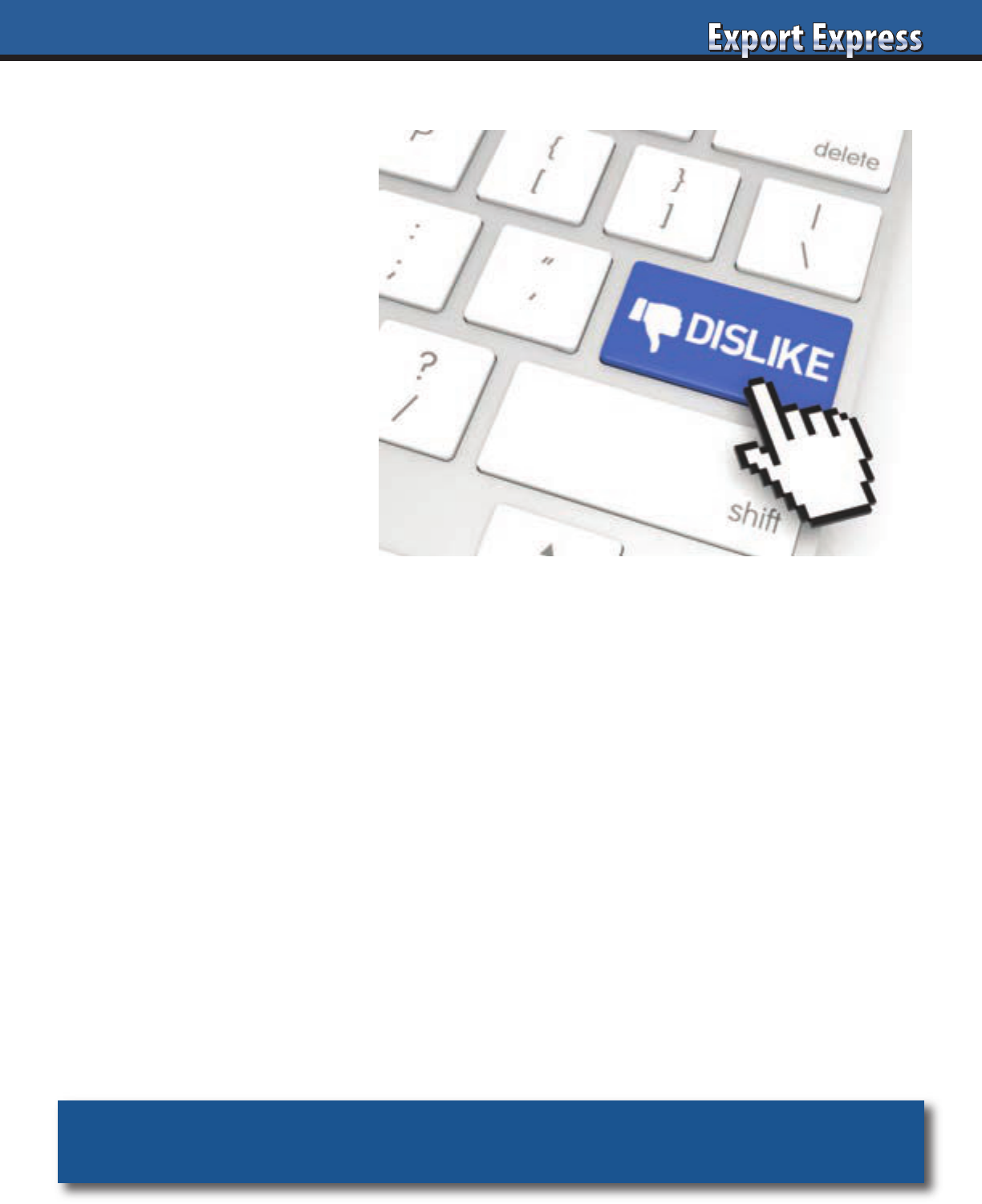
45
1. Unrealistic Expectations
Category growth ranges from 1% to 5%
in most Western countries. So how can
a manufacturer demand a 10% increase
in sales in a mature market? It’s possible
if the brand plans a major increase in
marketing spending. However, normally,
business growth parallels overall
market conditions.
2. Direct Contact With Their Assigned Retailers
Tricky retailers attempt to bypass a broker
by contacting the brand owner. Normally,
the retailer has his hand out for more
money or wants to “buy direct.” Be polite,
but ask the buyer to work with the broker
or schedule a joint meeting for your
next visit.
3. Cut Marketing Budgets
Leading brokers depend on joint
business plans, often created up to one
year in advance. Last minute squeezes,
translating to budget cutbacks sometimes
need to happen, but still hurt. The broker
is left with delivering the bad news and
also hitting the sales target, even with
reduced support.
4. Short Shipments
Everyone loses due to short shipments.
Brokers could be assessed penalties
by retailers. Store level shelf space may
be lost and need to be recaptured. Keep
the pipeline filled, particularly during
peak seasonality.
5. Price Increases
Rising raw material input costs may
require adjustments in list prices. The
reality is that price increases are brutal to
implement in many countries. Eventually,
they are incorporated after months of
stand-off’s. In many cases, brokers are
forced to swallow the punishment until
they can negotiate with the retailers.
6. Endless Reporting
Some brands are guilty of a constant
stream of reporting requests that take
time to complete. Ask: Is the report really
necessary? Legitimate requests are
forecasts, shipment results, major retailer
listing maps, price surveys, and new
product launch status updates.
7. Frequent Market Visits
Your partners require time to accomplish
their objectives without constant
oversight. Brokers appreciate short,
productive visits on a quarterly basis.
More frequently for a big company and
less often for a small brand. Get in,
conduct your business and off to the next
country. Week long visits to small markets
represent a distraction.
8. Commission Reductions
Brokers depend on their commission
to cover fixed overheads like logistics
and cost of their sales team. Often, their
net margin is only 3-5% or lower.
Commission reductions or increased
costs challenge their ability to operate
a financially healthy business.
9. Last Minute Requests
End of the year volume pushes and
rush orders are part of the business.
However, everything functions better
when normal lead times are respected.
Separate “must do” demands from
“nice to have” requests.
10. Delayed Response to Local Ideas
Manufacturers encourage brokers to
create unique local approaches to brand
building. Retailer buyers also call their
favorite brokers with short term
promotional opportunities to participate
in a special event. Brokers need quick
decisions on your ability to support their
idea. Few things are more frustrating for
a distributor than a lengthy wait while
their proposal is debated by numerous
levels of your company management.
Ten Things Brokers Don’t Like
Need a hand? Visit www.exportsolutions.com.
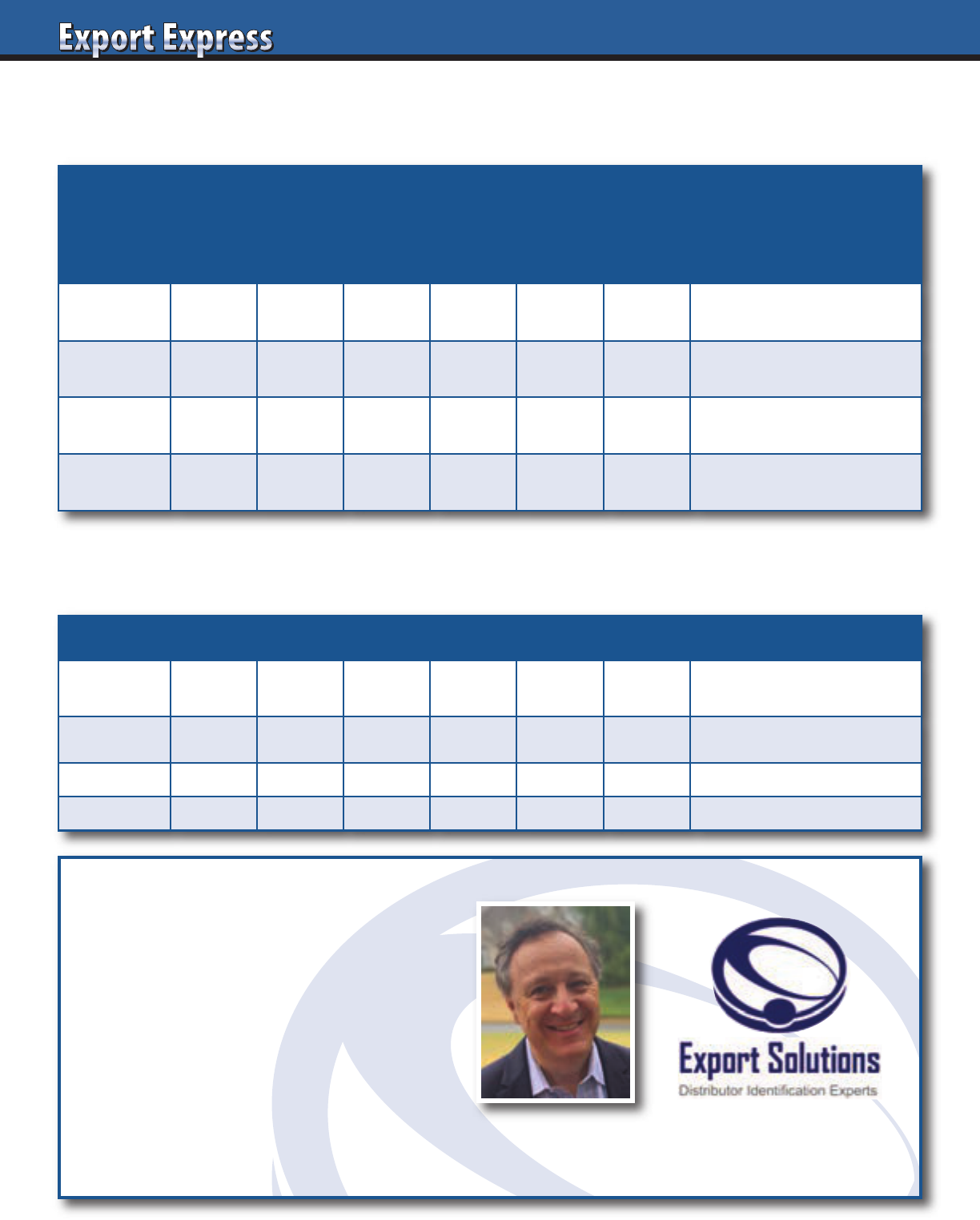
46
Retailer
Your
Brand
Share
Share
of
Shelf
Eye
Level
(yes or
no)
Next to
Brand
B
Key
Item
$2.99
Price
Gap vs.
Private
Label
Comments/Plans
Walmart SC 35% 42% Yes No 2.69 + .50 Shelf review September
Kroger 35% 28% No Yes 2.99 + .30
Increase shelf share to
minimum 35%
Albertsons 35% 25% No No 3.19 + .20
Increase shelf share to
minimum 35%
Publix 35% 45% Yes Yes 2.99 + .20
Maintain space in new
schematic
Country Shelf/Pricing Tracker – USA Sample*
*Complete for all countries/retailers
Country Listing Map – USA Sample*
*Complete for all countries/retailers
Retailer Stores SKU 1 SKU 2 SKU 3 SKU 4 SKU 5 Comments/Plans
Walmart SC 3,571 x x x
SKU 3 stocked at 2,000
Supercenters
Kroger 2,726 x x x x Category review November
Albertsons 2,278 x x x x New shelf set
Publix 1,300 x x x Present SKU 4: July
Talk to an Expert
• Find Distributors in 96 Countries
• International Strategy Road Map
• Fix Problem Markets
• Next Level Sales Management
• Export Workshops
• Motivational Meeting Speaker
Contact Greg Seminara at (001)-404-255-8387 to discuss your business development project.
www.exportsolutions.com
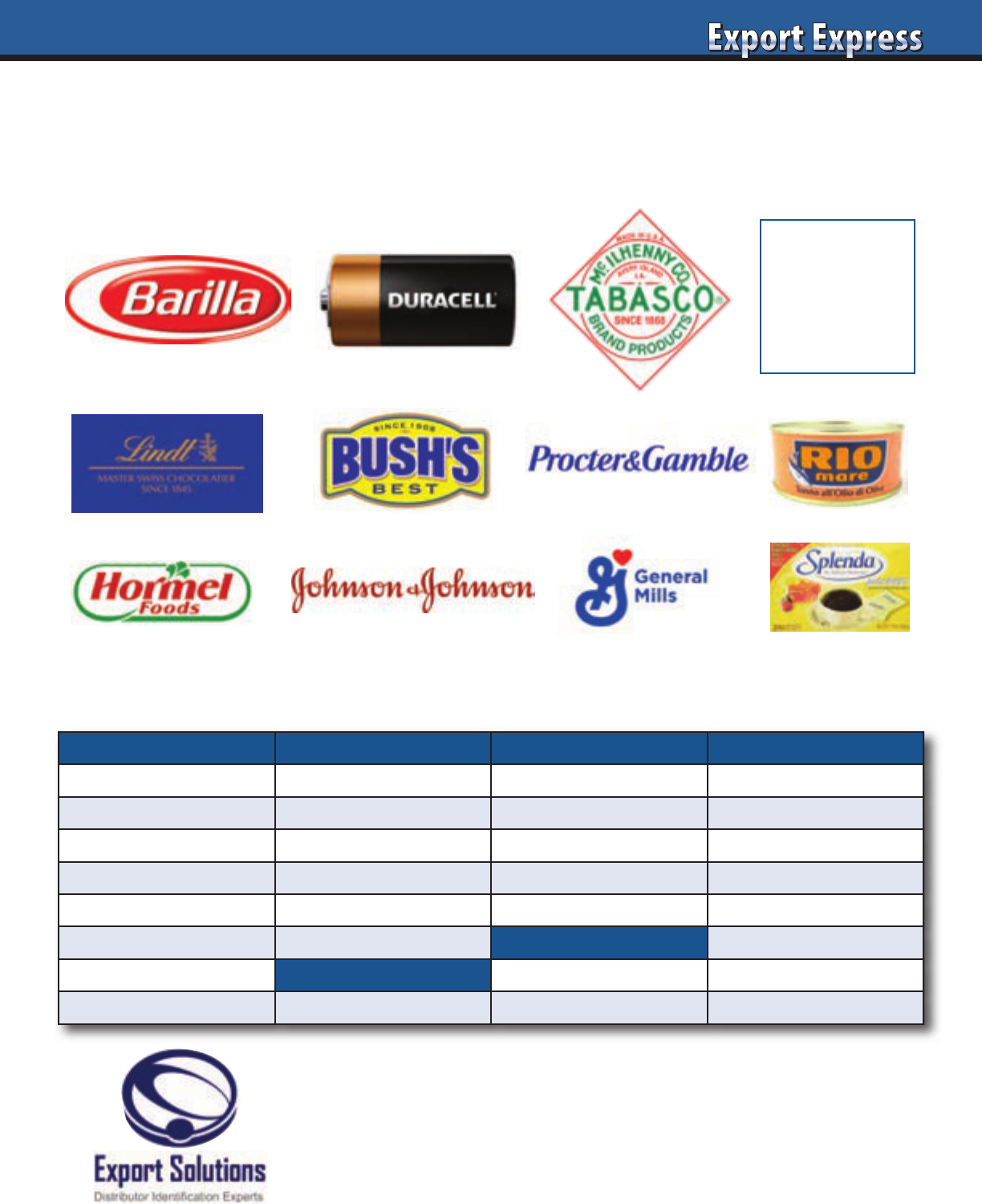
47
Distributor Search Helper for:
Your
Logo
Here
Can We Help You?
Recent Distributor Search Projects
Asia Europe Middle East Latin America
Australia Germany Israel Argentina
China Ireland Kuwait Brazil
Indonesia Netherlands Qatar Colombia
Japan Nordics Saudi Arabia Costa Rica
Malaysia Spain UAE Ecuador
Philippines United Kingdom North America Mexico
Singapore Africa Canada Panama
South Korea South Africa United States Peru
Call the Export Accelerator!
Contact Greg Seminara at greg@exportsolutions.com
to discuss your business development project.
www.exportsolutions.com
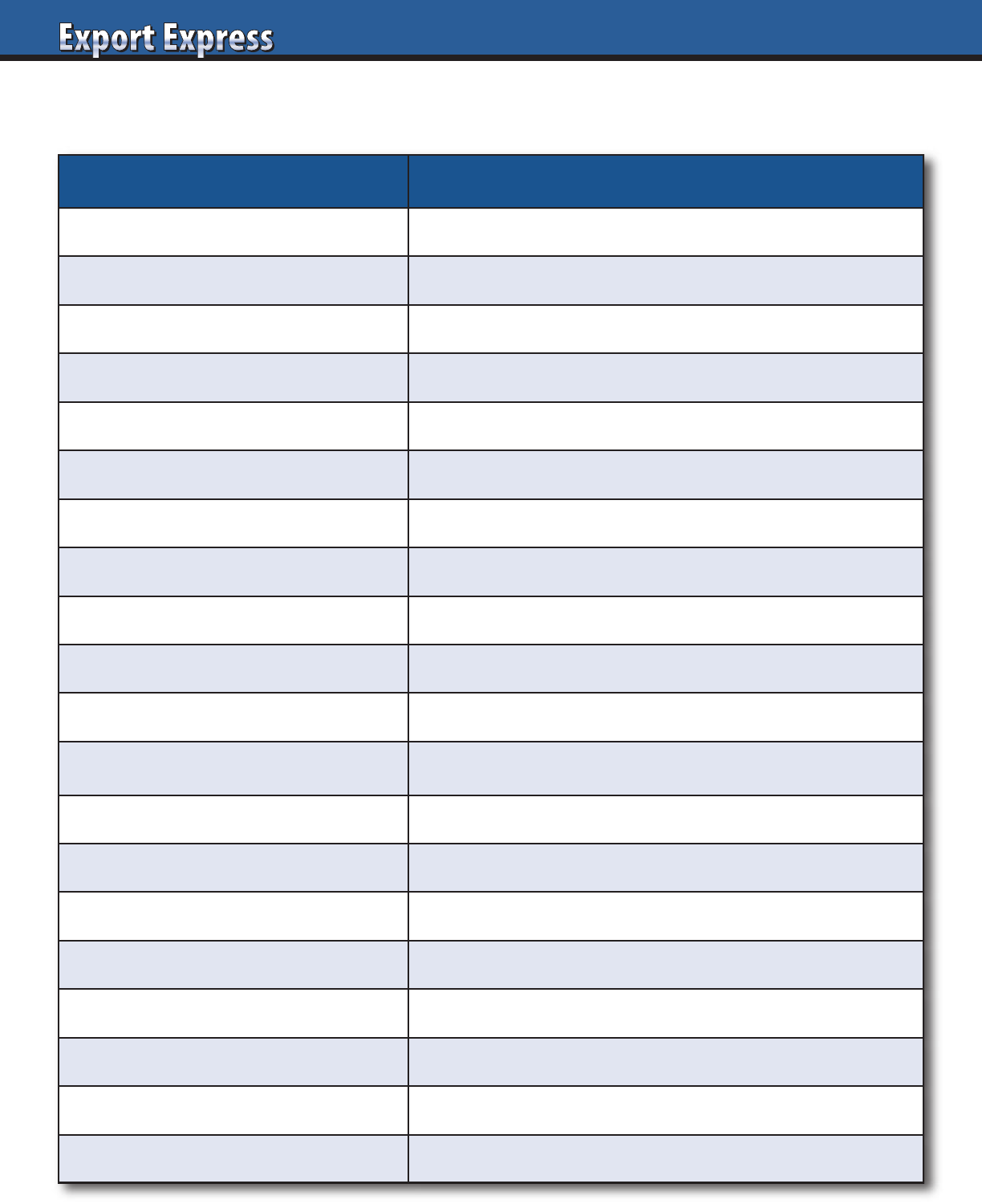
48
20 Tips to Accelerate a Mature Business
Activity Strategy
Creative Promotions
Retailer specific events. Offer fresh ideas.
Distributor Brand Manager
Upgrade talent. Secure “A” players on your business.
Pricing
More profit through higher volume at lower price?
Country Manager
Hire local manager or assign HQ person for 3-6 months.
Local Production or Copacker
Lower cost structure with added complexity.
Brand Ambassadors
Hire team with “brand uniform” to sample at local events.
White Space – Distribution
Fill voids on retailer listing map: Top 10 customers.
Social Media
Partner with influencers. Targeted local investments.
New KPIs
New measures: Listing maps, shelf placement, etc.
E-commerce Development
Invest to lead in this emerging channel.
In-Store Visibility
Educate and measure team on in-store presence goals.
Sampling, Sampling, Sampling
Aggressive distribution of free sample size.
Distributor Team Linkage
Zoom/Teams contact with Key Account Managers, etc.
Launch NPD Innovation
Excite team to launch innovation “The Right Way.”
Distributor CEO
Treat CEO as VIP. Create special relationship.
Sponsorship
Support local events and retailer charities.
Sales Contest
Excite and motivate retail sales team.
Alternate Channel Focus
Small shops, foodservice, duty free, drug stores.
High Spend Test
Will heavy up marketing or trade discounts drive sales?
Distributor Change
Motivated new team, high energy to solve old problems.
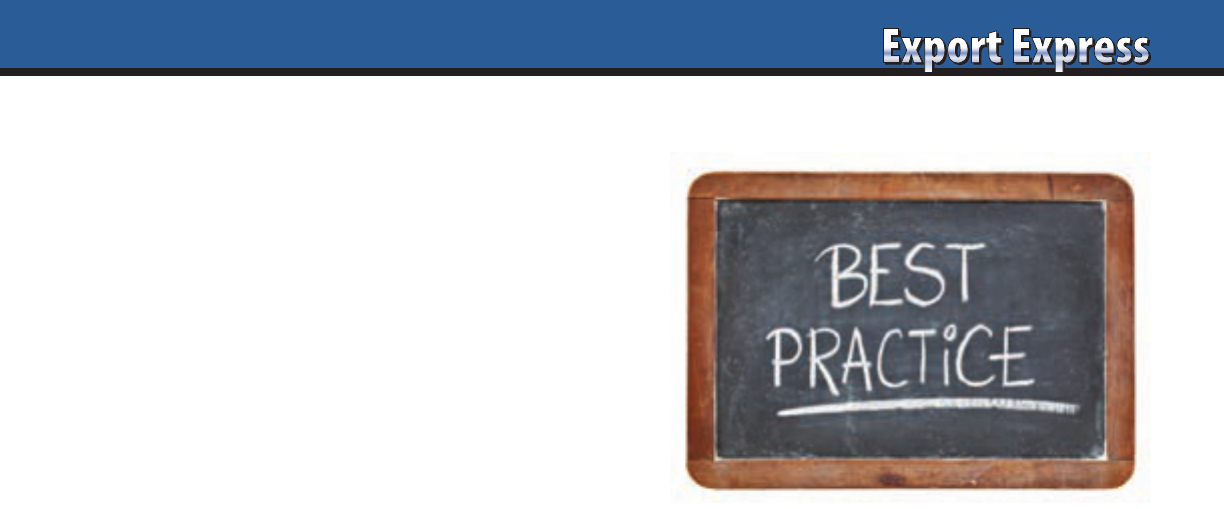
Have you ever experienced an incredible
first meeting with a distributor? Strong
alignment, good fit, everyone smiling,
timelines agreed. Then, nothing happens!
The export manager may take up to six
months to translate his outlook from
“done deal” to “dead deal.” There are
two reasons why this occurs.
First, distributors are positive,
competitive athletes, always striving
to win new business. However, in some
cases, the distributors wake up after time
to reflect and decide they really weren’t
that interested in the brand after all.
Failure also results when a strong
first personal meeting at a trade show
or distributors office is followed by
a relationship buried in email
communication, with no personal touch.
Below are Export Solutions’ Ten Tips on
converting promising new business leads
into tangible business partnerships.
1. Zoom/Teams – Don’t Depend on Email
Motivated distributors still return phone
calls, but frequently receive up to 200
emails a day, many from existing brand
partners. Top distributors’ business days
are captured by a continuous flow of
meetings with customers, principals,
and their own employees. Best bet is to
call a potential partner or set up Zoom
meetings. Email is okay for routine
correspondence, but too easy to ignore
or delete.
2. Follow Up Immediately & Frequently
Time slips away, as Export Managers
focus on existing businesses and
“problems of the day.” One tip is to
put regular follow up reminders on
your computer calendar.
3. Focus on 5 C’s: Category Review, Calculation,
Cost of Plan, Compliance, Contract
There are 5 critical elements to translate
a “lead” into shipments.
Category Review: How does your
category look in target country? Category
size, competition,pricing,margins, and
merchandising activity.
Calculation: What is the distributor’s
proposed calculation from your factory
gate to the store shelf? What are standard
costs like duties and taxes? What are
flexible or negotiable like trade discounts
and distributor margin?
Cost of Plan: Each brand needs a plan
to gain market entry. This includes key
account “sell in,”
followed by consumer
and trade promotion
activities. Look at the
distributor’s proposed
plan, as well as several
options with different
price tags.
Compliance: Many
countries feature a
product registration
process and labeling
requirements. In some
countries, this step is
easy with automatic
compliance for a USA
or European brand. Or a
simple solution with a small distributor
applied sticker. In other countries like
Japan or Indonesia, plan on one year or
more to navigate the complex process.
Contract: “Ready, Set, Go” can be delayed
by 3-6 months due to contract negotiations.
Company lawyers demand 20 page
agreements in English that even the
Brits can’t understand. Distributors
prefer two page letters of understanding
or a handshake deal. Do what is right
for your business, but expect delays
and frustration.
4. Request References
A good idea is to quickly request
distributor references from other brands
they handle. Motivated distributors will
send impressive references right away.
Also, have your credit department run
a Dun and Bradstreet or Equifax report
as soon as possible. Many trade show
meetings are with “pretenders” who state
exaggerated claims and are ultimately too
small to handle your brand. Better to
discover this sooner versus later.
5. Move Beyond the Distributor Owner/MD
The distributor owner “writes the
checks,” but frequently serves as a
“bottleneck.” The key is to quickly get
your brand assigned to a “worker” whose
task is to move your project through the
system and produce an order!
6. Establish Realistic Timelines
Sync with category review dates and avoid
holiday periods. Update timelines
frequently. New distributor relationships
always take longer. Plan on six months
from first meeting to first shipment. Be
pleasantly surprised if things move quicker.
7. Distributor Response Time
Signals Interest Level
How often do you check your emails?
Probably every hour. When I work
on distributor search projects for well
known brands like Pringles, Tabasco,
or Barilla, distributor response is
lightening fast. Motivated distributors
will chase you if they are interested
because they are anxious to start selling
your brand!
8. Establish Regular Checkpoint Calls
I suggest every two weeks at a
minimum. Use a common document of
priorities, action steps, and due dates.
9. Visit the Distributor
It’s amazing the amount of progress
that will be made during a meeting
at the distributor’s office. Also, the
distributor will work hard in advance of
your visit as your project moves up the
priority list and they want to guarantee
a favorable impression. A visit to the
distributor’s market signals your
commitment. Beware if the distributor
is reluctant to schedule your visit. Either
he has changed his mind about a
partnership or his office and capabilities
do not match the bold promises made at
the initial trade show meeting.
10. Parallel Path Two Candidates per Country
A favorable first meeting represents an
excellent start. However, there are still
many steps (think 5 C’s in point 3)
before you sign a contract and receive
your first order. Always keep two
candidates in the process, in case your
top choice disappoints. This can be
tough, but represents a better option
than needing to start the entire process
over again.
Ten Tips: Converting Promising Leads to New Partnerships
49
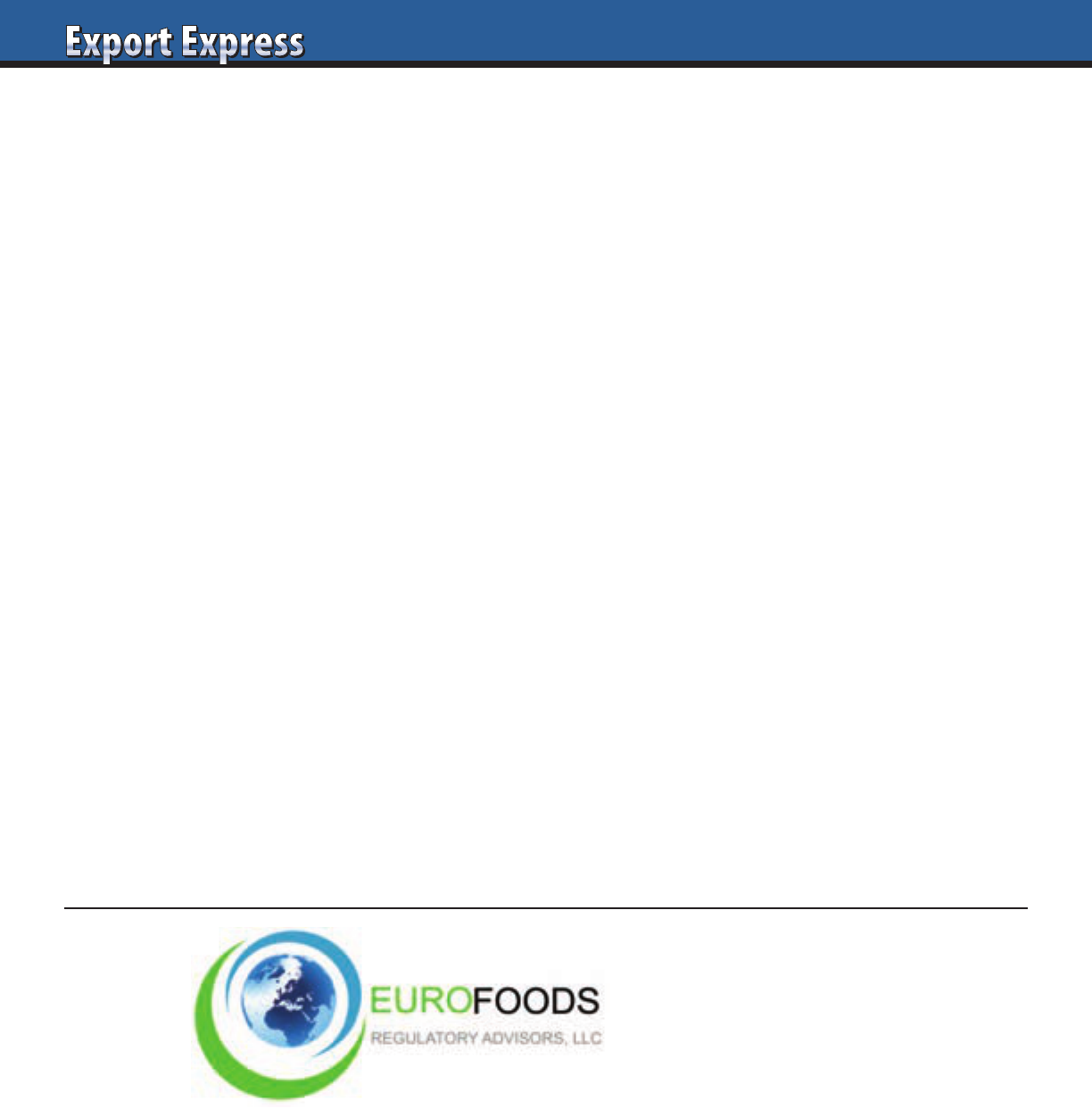
50
5 USA Labeling Regulation Tips-FDA
So often we hear, “It is too complicated to export to the USA,”
when in reality, nothing is further from the truth. Every country
has its requirements and regulations and the USA is no different.
The regulations are pretty much the same whether you are a
domestic producer or a foreign manufacturer. Once you acquaint
yourself with the requirements, it really isn’t that bad. If you
follow what needs to be done, you have taken an important step
in starting on a successful sales journey in the United States.
Here are some tips to get you started:
1. Product name must be clear. If not, you will need a product
description immediately following the product name.
2. Net Weight statement must be in the lower 30% of the
principle display panel (front label) and must include USA
measure and the metric equivalent, e.g. NET WT 3.5 OZ (100g).
3. Nutrition Facts:
• Serving size is based on the reference amounts established
by the FDA NOT on 100g
• Rounding rules have been followed
• Only one of the FDA established formats have been used
• Type size requirements have been followed
4. Ingredient List:
• Ingredients are listed in the order of predominance by weight.
• Only USA approved ingredients are used.
• Components are listed by their USA accepted common
or usual name. Multicomponent ingredients are either
broken out or their individual ingredients are listed
separately without the all-inclusive ingredient name
5. Contact information: If it is the foreign manufacturer, it must
include the country even though the country of origin
declaration (Made in ____) immediately appears above or
below. If it is not the manufacturer, an explaining function
must be included, e.g. “Imported by,” “Exclusively
distributed by” etc.
5 Common FDA Labeling Errors
Some common mistakes to avoid:
1. Type Size of all mandatory information is too small. It should
be a minimum of 1/16 inch (1,6 mm) but should increase as
package size increases. This requirement does not apply to
the Nutrition Facts.
2. Rounding rules in the Nutrition Facts are not followed.
These apply to calories, cholesterol, sodium and vitamins.
3. Ingredients:
• Ensuring that the color is permitted in the USA
(e.g., “safflower” is not permitted as a color)
• Using the common or usual name of an ingredient
(e.g., “cocoa mass” is not an accepted term in the US)
4. Allergen Labeling:
• Ensuring that all allergens are clearly listed in the
ingredient statement. Bolding, italicizing allergens
is NOT permitted
• Confirming that an ingredient is truly a recognized
allergen in the USA (differences between US, Canadian
and EU allergen lists)
• Declaring the presence of trace allergens, if applicable
5. Country of Origin declaration is in close proximity
to the contact information (e.g., manufacturer,
or importer, etc., address).
The above is a brief overview. It is crucial to have a professional
review a label to avoid unnecessary problems at the time of
import. Eurofoods Regulatory Advisors, LLC stands ready
to assist you. Feel free to contact us!
Good Luck & Happy Sales!
Margaret Eckert
President
Eurofoods Regulatory Advisors, LLC
Margaret Eckert is President and Owner of Eurofoods Regulatory Advisors, LLC since January 2010. She has over 30 years experience assisting
hundreds of foreign food and beverage companies to comply with all required regulations in order to successfully export their products to the USA
and Canada. Works closely with USA and Canadian government agencies. Margaret has conducted many seminars both in the USA and in
Germany on major topics affecting imported products. She regularly contributes to leading trade magazines in the USA on current and upcoming
issues affecting the industry. For more information visit our web site at www.eurofoodsreg.com.
Prior to her current position, she was Director of Trade Relations for the German Agricultural Marketing Board – CMA North American Office, a
foreign government agency, where she was responsible for aiding German food and beverage manufacturers to fulfill all necessary regulatory
requirements. Organized the German participation at major trade shows. She also actively participated in the rulemaking process of the Nutrition
Labeling and Education Act (NLEA), the Bioterrorism Act (BTA) as well as the USA – EU Beef Hormone Dispute and the US/EU Banana
Dispute on behalf of the German industry. Margaret is now monitoring the Food Safety Modernization Act (FSMA) and its impact on imports.
Margaret Eckert
42 Lehigh Lane
Hicksville, NY 11801-3313
TEL: (516) 433-4864
www.eurofoodsreg.com
Info@eurofoodsreg.com

51
Channel/Category Definition
CPG Consumer Packaged Goods – refers to our
industry. Similar meaning to FMCG.
ACV All Commodity Volume – used to describe
brand penetration. i.e. 77 % ACV availability.
FDM Food, Drug, & Mass Channels
Food/Grocery Channel Supermarket Channel
Drug Channel Pharmacy Channel
Supercenter Hypermarket format of Walmart. Leading
Walmart format and seller of food in USA.
Vendorville Nickname for Bentonville, Arkansas.
Global headquarters for Walmart.
Club Channel Membership Warehouse Clubs: Costco, Sam’s
Clubs. Annual fee of $40- $100 to shop.
Dollar Stores Channel of retailers selling items for $1
Dollar or similar. Dollar Tree.
Foodservice Channel Channel selling to restaurants,
institutions (schools) and contract
feeders (company cafeterias).
C Store Convenience store. Includes chains like
7-11 and stores aligned with gas stations.
OTC Over the Counter products. Healthcare
products available without a prescription.
HBC Health and Beauty care products.
GM General Merchandise/Non Food products.
Grocery Usually shelf stable food and basic consumer
items like paper towels and laundry supplies.
Spectra Database analyzing demographic purchasing
info for brands and categories.
Dunhumby Database part owned by Kroger that analyzes
purchase data & facilitates targeted marketing.
Store Operations/Supply Chain
Planogram Schematic. Official layout of store fixtures
Modular Same as Planogram. Term used by Walmart.
Cut In Processing of physically making space
for your product on the shelf.
Reset Process of physically updating the
planogram of a store or category.
OOS Out of Stock condition at warehouse or store.
Shelf Hog A brand that takes up more shelf space than
other similar category items.
Cheater Pack Item that looks the same as competition,
but actually has fewer ounces/grams.
Broker Agent providing headquarter sales, retail
coverage and admin services for brands.
Distributor In USA, a wholesale distributor like UNFI,
Kehe, or DPI that stocks 25,000+ specialty
food items.
SKU Stock Keeping Unit. An individual item or
brand size. Each SKU has an individual UPC.
Retail Link Walmart portal to share Point of Sale data
with their vendors.
Promotion Definition
Robinson Patman Act USA law states that all retail customers
should get same price/promotional
“opportunity”.
EDLP Every day low price. Strategy used
by Walmart and others. Fewer “short
term” promotions.
Hi Lo Retailer strategy to offer higher everyday
prices, but deep discount special offers.
Accrual Promotional fund for retailer based upon
a set amount per case purchased.
Deal Special promotion or allowance to a retailer
as an incentive to push a product.
TPR Temporary Price Reduction. Usually, 10-20%
price discount for 4 weeks, noted by in store tag.
Loyalty Card Card (free) required by chains to obtain
discounts/special offers. Retailers analyze data.
Ad Weekly flier/circular by supermarket chains
with special promotions and discounts.
Menu Cost Standard “List Price” to participate in retailer
activities: Ad, Display, Slotting Fee. Negotiable.
Slotting Fee Fixed fee to gain entry for a product to a
retailers shelf or wholesalers warehouse.
BOGO Buy One Get One Free Promotion.
Scan Down Discount paid to retailer on products scanned
through the register behind a TPR promotion.
In & Out Temporary stocking of an item. Usually for a
Holiday or special season. No Slotting fee.
Billback An allowance paid by brand owner to a retailer
after proof of promotional performance.
Shipper Promotional display piece with point
of sale material. Usually higher margin
and “in and out”.
Bonus Pack Special size of a brand: free ounces versus
the normal size. i.e., 80 oz for price of 60 oz.
Lift Incremental sales behind a promotion offer
versus your normal sales rate.
Dog Slow selling brand or item.
POS Point of Sale materials. Promotional materials
placed on shelf or display.
Coupon A discount certificate providing an immediate
savings (.25 - $1.00) on a specific product.
Double Coupon Some retailers double value of coupons (up
to .50) at their own expense to attract shoppers.
Neckhanger Coupon or product literature attached to the
neck of a bottle.
FSI Free Standing Coupon Insert. Coupon
distributed via Sunday newspaper.
SPIF Money to incent a sales representative to sell
more of your product. Common in Foodservice.
Spender of the Year Joke: Some state that “Vendor of Year”
awards go to the biggest brand “Spenders
of the Year”.
How Well Do You Know the USA? 50 Industry Terms and Definitions
Looking for more USA Industry terms and definitions?
100 + commonly used terms and their meanings.
Free Access: www.exportsolutions.com
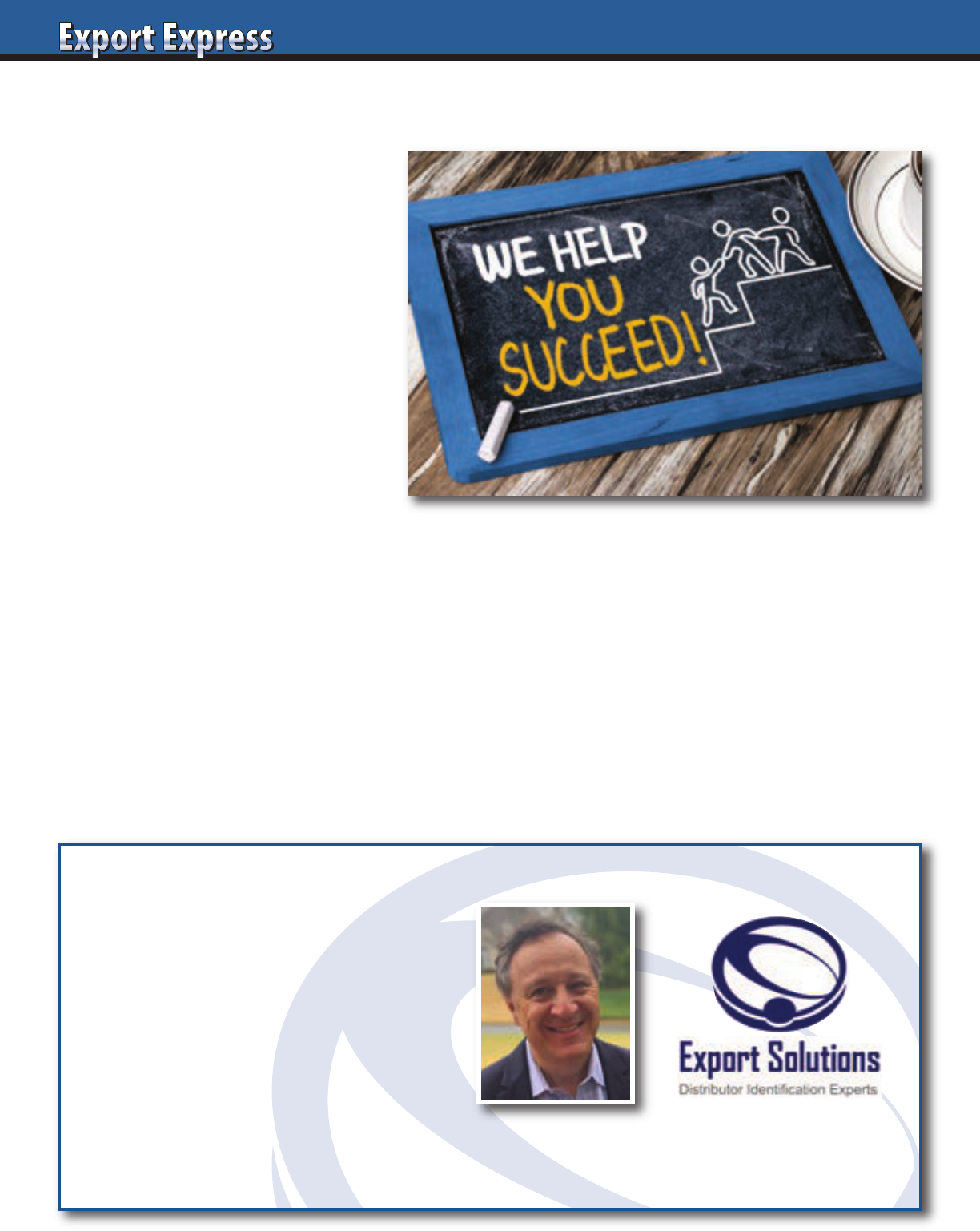
52
1. Determine Brand Ambition
for Country
Will your brand be a category leader,
player, or niche participant?
2. Establish Distributor
Selection Criteria
Big brand distributor, category specialist,
or smaller entrepreneur?
3. Create a Pool of Candidates
Export Solutions’ database tracks
9,200 distributors in 96 countries.
4. Determine Candidates Preliminary
Interest Level
Send introductory email, followed
by phone call within 48 hours.
5. Introductory Web Interview
One hour meeting to share credentials
and confirm interest.
6. Local Interview at Distributor’s Office
4-6 weeks lead time. 2 hour meetings.
Send advance agenda.
7. Independent Store Checks
Provides category insights and “real” distributor
performance for current brands handled.
8. Interview Preparation: Scorecard, Samples,
Your Presentation, Key Questions
Export Solutions’ templates: Assessment Scorecard
& Ten Questions for every interview.
9. Distributor Interviews – Target 3 Candidates
Review capabilities, warehouse, cost to serve,
and interest in your brand.
10. Cooperation Model
What is the plan? Year one plan, pricing
calculation, and tim
eline.
Ten Step Distributor Search Process
Talk to an Expert
• Find Distributors in 96 Countries
• International Strategy Road Map
• Fix Problem Markets
• Entry Plans
• Export Workshops
• Motivational Meeting Speaker
Contact Greg Seminara at (001)-404-255-8387 to discuss your business development project.
www.exportsolutions.com
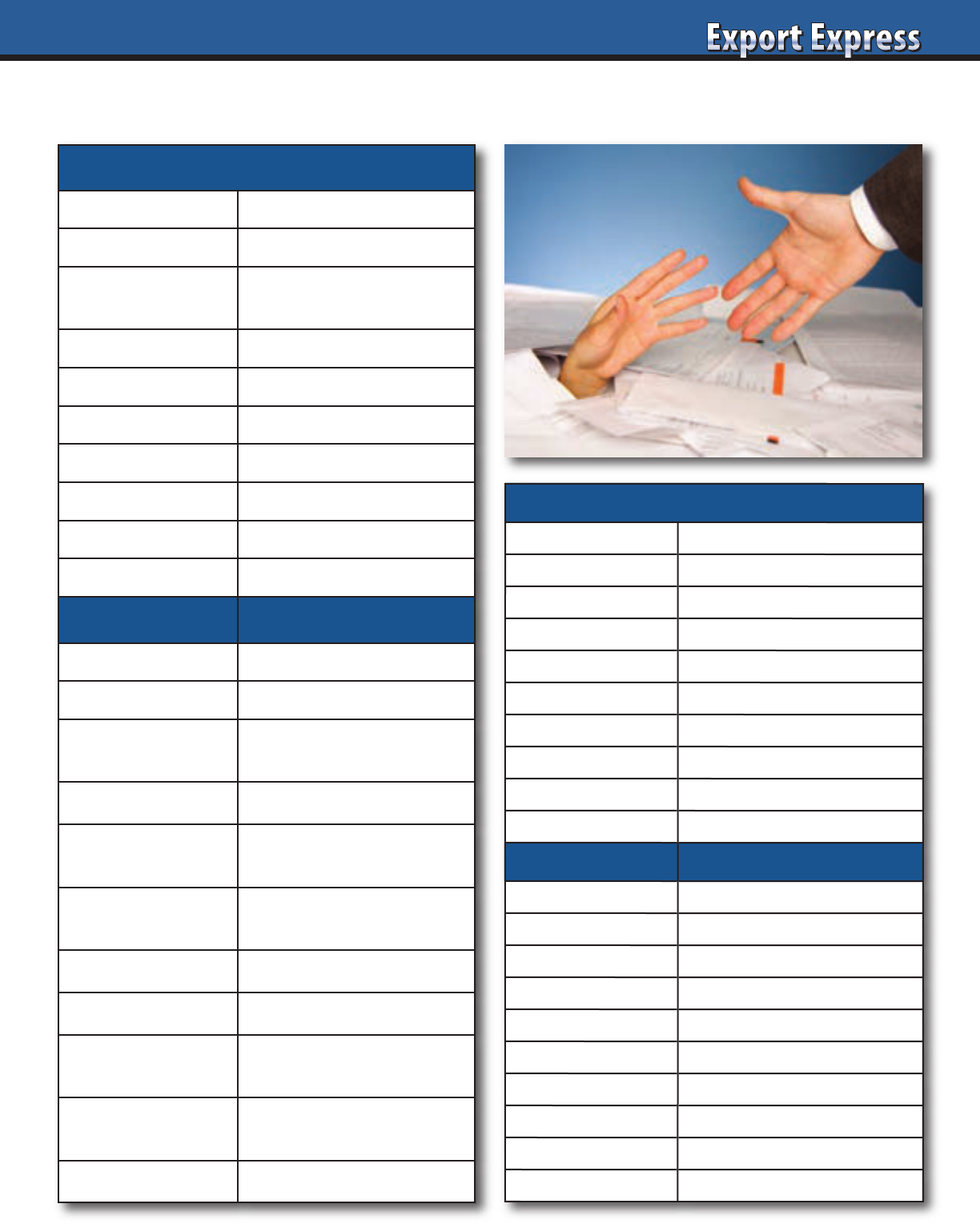
53
Need a Hand? – 40 Great USA Resources
Sector Experts
Brand/Market Tests www.gamechanger.net
Category Management www.thepartneringgroup.com
Contract Sales
Management
www.ramgroup.net
German Brands www.germanfoods.org
Health & Personal Care
www.emersongroup.com
Private Label www.daymon.com
Recruiting www.cpgjobs.com
Regulatory/Labels www.eurofoodsreg.com
Sales Strategy www.exportsolutions.com
UK Brands www.greenseedgroup.com
Sector Facts Specialty
Bevnet Beverage
CIA Factbook Country Facts
Consumer Brands
Association
Manufacturers
Export Solutions Retailer Database
Food Marketing
Institute
Industry Facts
Foreign Agricultural
Service
Reports/Stats
IDDBA Dairy, Deli, Meat
Kantar Retailer Insights
National Confectioners
Association
Candy & Snacks
National Restaurant
Association
Foodservice
Nasft Specialty Food
News Topic
Analysis
www.morningnewsbeat.com
Beverages
www.bevnet.com
Brands
www.supermarketguru.com
Candy & Snacks
www.candysnacktoday.com
Gourmet
www.gourmetretailer.com
Gourmet
www.specialtyfood.com
Manufacturers
www.smartbrief.com
Manufacturers
www.progressivegrocer.com
Marketing
www.adage.com
Supermarkets
www.supermarketnews.com
Trade Shows
Specialty
Comida Latina
Hispanic Food
ECRM
Buyers Shows
Fancy Food
Gourmet
IDDBA
Dairy, Deli, Bakery
NACDS
Health & Personal care
NACS
Beverages
Natural Products Expo
Natural Foods
NRA
Food Service
PLMA
Private Label
Sweets and Snacks
Candy & Snacks
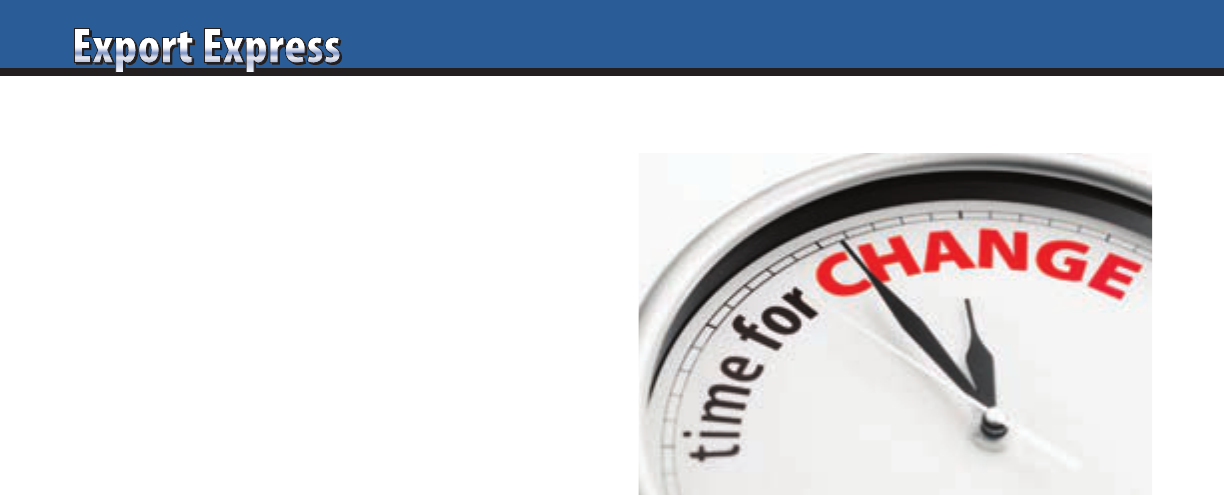
54
Every exporter has countries where
their brand performance lags far behind
expectations and market potential. This
appears as a serious issue when the poor
results are in a large strategic country like
the USA or China. The first step to fixing
the situation is to admit that you have
a problem. Too many times, export
managers loyally cling to their plan and
existing distributor with hope that “next
year will be better.” The likelihood is that
sub-par trends will continue without
intervention. Remember, it’s your quota
and job that suffer due to lackluster
results in a country. Listed below are
Export Solutions’ 10 Tips on action
steps for under performing countries.
1. Look in the Mirror
Chances are that your current brand
proposition is wrong for the country. Your
product sales are a reflection on buyer and
consumer response to your product range.
An underqualified partner does not help,
but is usually just part of the problem.
2. Research Consumer Habits
Conduct category research to understand
why consumers in a foreign country
do not appreciate your brand like they
do “back home.” Category habits and
development vary widely, particularly
around food products. Recently, I
confirmed several examples where Asian
consumers demonstrated little interest
in certain Western style foods (although
everyone loves candy and snacks!).
3. Investment Level
Many poor performers suffer the classic
issue of insufficient funds to invest in
marketing and trade programs. There is a
cost of doing business everywhere and the
investment requirements can be huge in a
place like China or the USA. Best bet is to
break down the country into smaller areas
and focus on targeted investments with
high potential, regional retailers where
your brand has a higher probability of
success. Avoid the attraction of large,
national retailers where you realistically
cannot support the business. Don’t expect
miracles without basic investments in
marketing and trade promotion.
4. Establish and Track In Store KPI’s
Many exporters focus primarily on monthly
shipment numbers. Shipments represent
the ultimate scorecard, but we strongly
advocate the implementation of in-store
metrics. This process starts with major
account listing maps,
tracking your SKU
level authorizations
for major customers.
The second step is to
launch and measure
in-store presence
guidelines. How do
you judge a good
store from a bad
store? Ultimately,
shipments are a
reflection of
consumer purchases,
not inventory sitting
in a distributor’s
warehouse. “What’s
measured is treasured.”
5. Spend a Day at Retail With
Your Distributor Executives
We all spend too much time in comfy
meeting rooms sharing PowerPoint
presentations with optimistic plans.
Dedicate time for retail with the
distributor executive team. Visit stores
at random, picking an area on the other
side of town from the distributor’s office.
Create a store check sheet to capture
observations such as shelf space,
promotions, and competitive activity.
Speak to aisle clerks and store managers
to get “street smart” on your product
and category performance.
6. Secure Direct Buyer Feedback
Every distributor should maintain
excellent trade relations with at least one
of his key accounts (if not all!). Schedule
an appointment or a lunch with a friendly
buyer to secure his point of view. Try to
keep the conversation focused around
category dynamics and trends versus just
a request for more trade spending. Buyers
love to serve as “experts” and may
support you if you follow their advice.
7. Distributor Brand Manager
The Distributor Brand Manager serves
as our everyday contact and the conduit
to distributor resources. Problems may
relate to having an experienced brand
manager handling too many companies
or a junior brand manager, lacking the
clout to get things done with the busy
sales team. We all like our Brand
Managers, as they take our calls
and rescue us periodically, However,
sometimes it’s just not working and
you need a change.
8. Share Best Practices – Adjacent Countries
Every distributor will be quick to point
out “How different their country is.”
The reality is that there are more
similarities between countries than
differences. Look at an adjacent country
or one with common retailers and share
lessons learned. This may represent a
category review, presentation approach
or special sales contest. Invite the brand
manager to visit a successful country
or attend a meeting where best practices
are shared.
9. FaceTime in the Trenches
Distributors appreciate export managers
willing to contribute to joint resolution
of problems. Consider sending a
company employee to work for 3-6
months on assignment at the distributor.
Visit quarterly or more frequently.
Schedule bi-weekly update calls. Better
to focus attention on fixing a high
potential country than regular visits
to small countries achieving their
objectives. “Distributor respects what
the principal inspects.”
10. Partner Change
A distributor change is the last resort,
but sometimes partners outgrow each
other and are no longer a “fit.” Export
Solutions’ database tracks an average
of 85 distributors per country, so you
always maintain options. Transition
to a new distributor involves business
disruption and even a temporary decline
in shipments. The good news is that your
new distributor will be motivated,
committed and anxious to make a
positive impression with a fast start.
The key is to manage the process with
dignity and open communication, so that
the terminated distributor is not surprised
by your actions.
Ten Tips: Action Steps for Poor Performing Countries
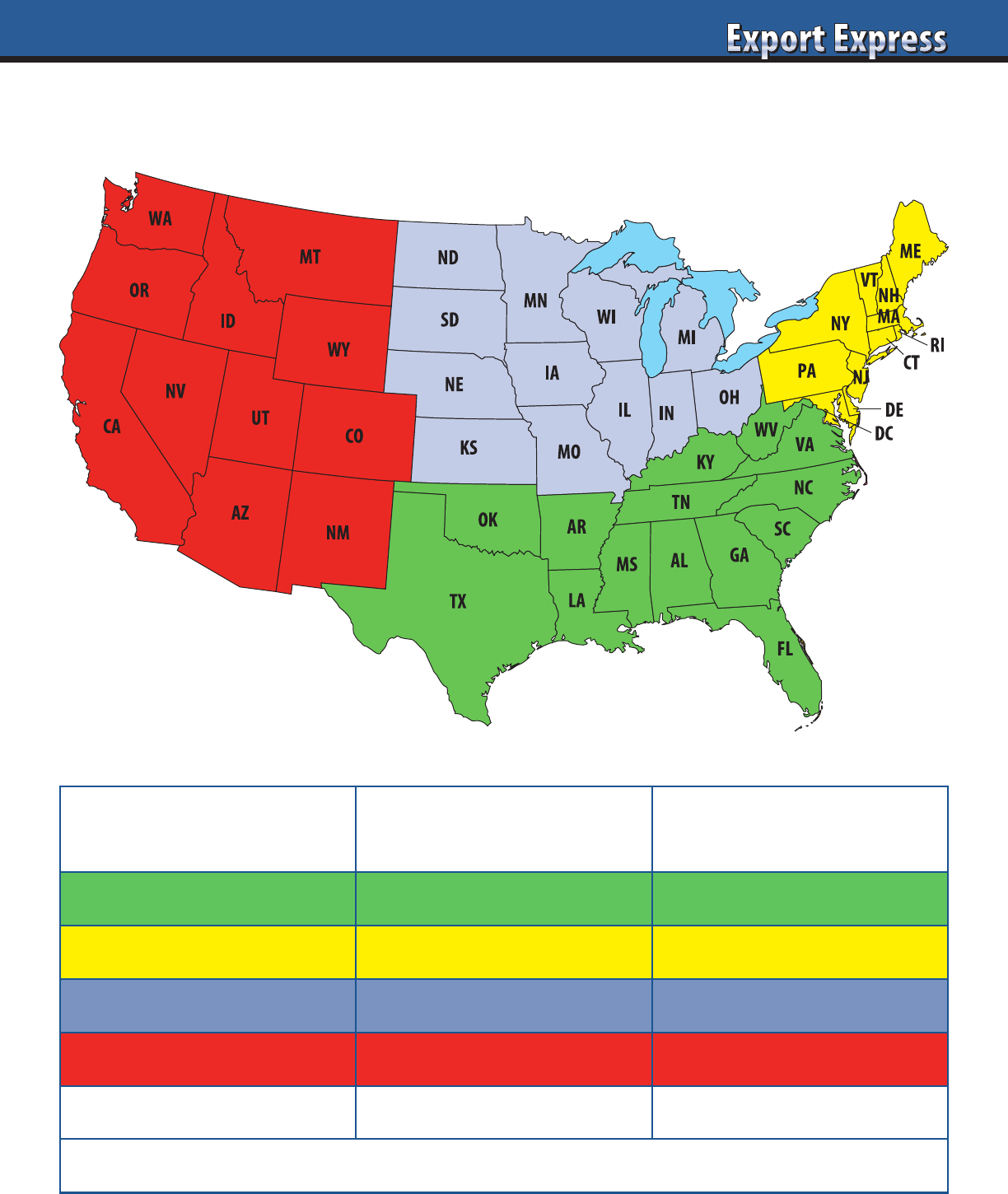
55
USA Population by Region
MD
Region Population (millions)
Percentage of USA
Population
South 128 38%
Northeast 57 17%
Midwest 69 21%
West 79 24%
Total 333
*estimated 2022
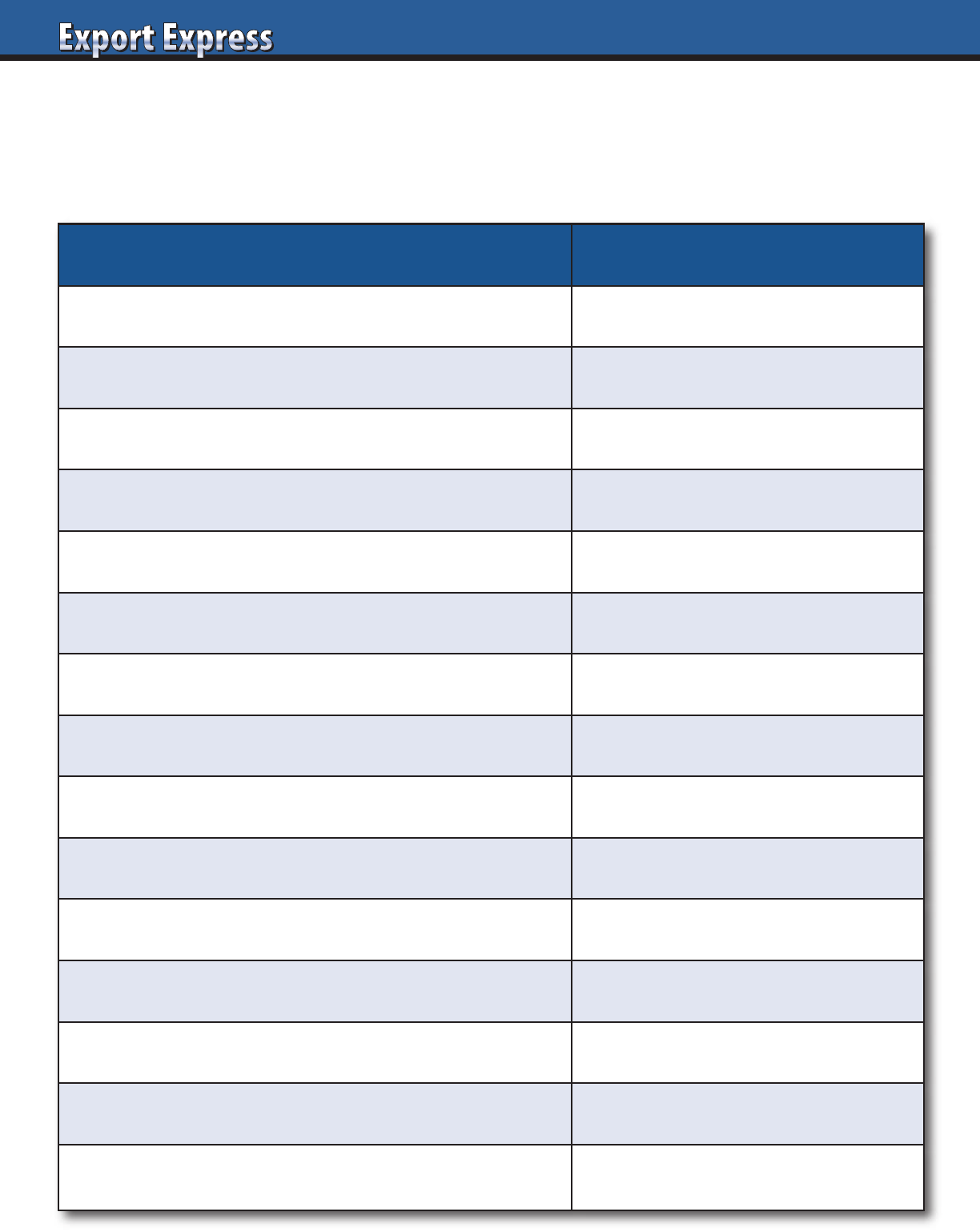
56
Distributor Capability Assessment
Export Solutions established 15 assessment criteria to identify “Best in Class” performers as well as “under
achievers.” Many distributor relationships extend 10 years or more. Is your distributor network still a “good fit”
for your current business requirements? Template can also be used as New Distributor Reference Check form
.
Assessment Criteria Rating: (10 = Best)
Category Expertise/Critical Mass
Focus/Time Dedicated to your Business
Joint Business Plan Development, Execution, Delivery
Alignment with Brand Owners Vision. Relationship.
Cost to Serve (fair margin, extra costs)
Assortment/Shelf Space
Promotion Creativity, Effectiveness, and Efficiency
Key Account Relations (Senior level, buyer)
Leadership/Owner (engaged & committed to us?)
Brand Manager (seniority, clout,creativity)
Multi Channel, Multi Regional Coverage
Financial Stability, Payment Record
Supply Chain Management & Forecasting
Problem Solving: rapid response?
Sales Results versus Budget, Market, Category (CY, PY, 3 Years)
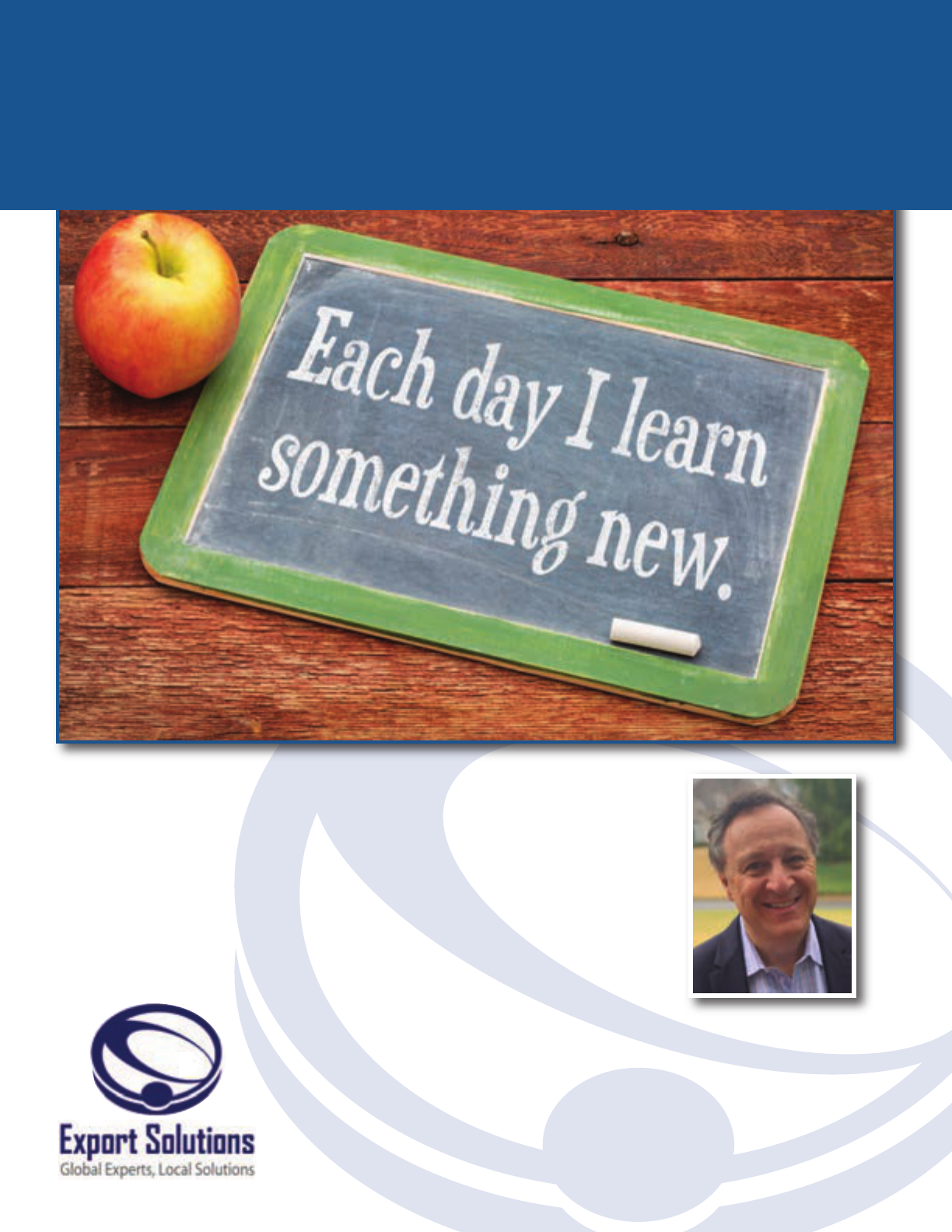
Export Workshops & Speeches
by Greg Seminara
Export Workshops & Speeches
by Greg Seminara
Export Workshop Overview
• Web and on-site workshop options available
• 8 Export Development & Distributor Management Modules
• Includes 25 Common Export Problems group work
• 200+ topics available for tailored workshop
• One hour keynote or motivational speech
Contact Greg Seminara for
more details and references:
gseminara@exportsolutions.com.
57
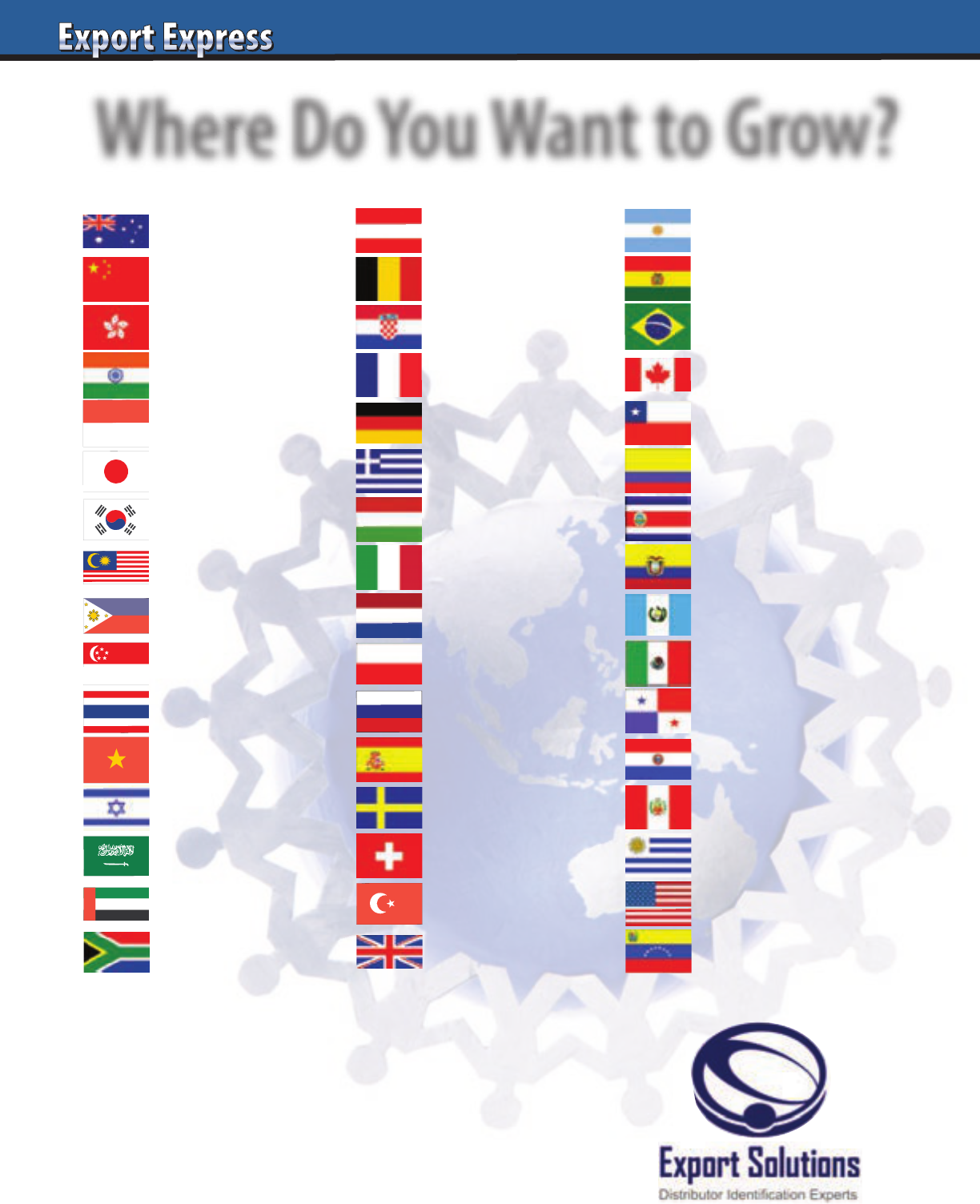
58
Where Do You Want to Grow?
Asia/Africa/Middle East
Europe Americas
Use Export Solutions Database
to fill in the Gaps in your
Export Coverage Map
Australia – 274 Distributors
China – 160 Distributors
Hong Kong – 177 Distributors
India – 109 Distributors
Indonesia – 78 Distributors
Japan – 176 Distributors
Korea – 146 Distributors
Malaysia – 128 Distributors
Philippines – 109 Distributors
Singapore – 163 Distributors
Thailand – 94 Distributors
Vietnam – 49 Distributors
Israel – 61 Distributors
Saudi Arabia – 115 Distributors
U.A.E. – 195 Distributors
South Africa – 106 Distributors
Plus 14 more countries
Austria – 68 Distributors
Belgium – 85 Distributors
Croatia – 78 Distributors
France – 125 Distributors
Germany – 188 Distributors
Greece – 90 Distributors
Hungary – 68 Distributors
Italy – 105 Distributors
Netherlands – 155 Distributors
Poland – 90 Distributors
Russia – 108 Distributors
Spain – 157 Distributors
Sweden – 103 Distributors
Switzerland – 100 Distributors
Turkey – 82 Distributors
U.K. – 274 Distributors
Plus 19 more countries
Argentina – 61 Distributors
Bolivia – 52 Distributors
Brazil – 135 Distributors
Canada – 205 Distributors
Chile – 92 Distributors
Colombia – 82 Distributors
Costa Rica – 73 Distributors
Ecuador – 55 Distributors
Guatemala – 61 Distributors
Mexico – 193 Distributors
Panama – 63 Distributors
Paraguay – 57 Distributors
Peru – 82 Distributors
Uruguay – 52 Distributors
USA – 598 Distributors
Venezuela – 38 Distributors
Plus 14 more countries

